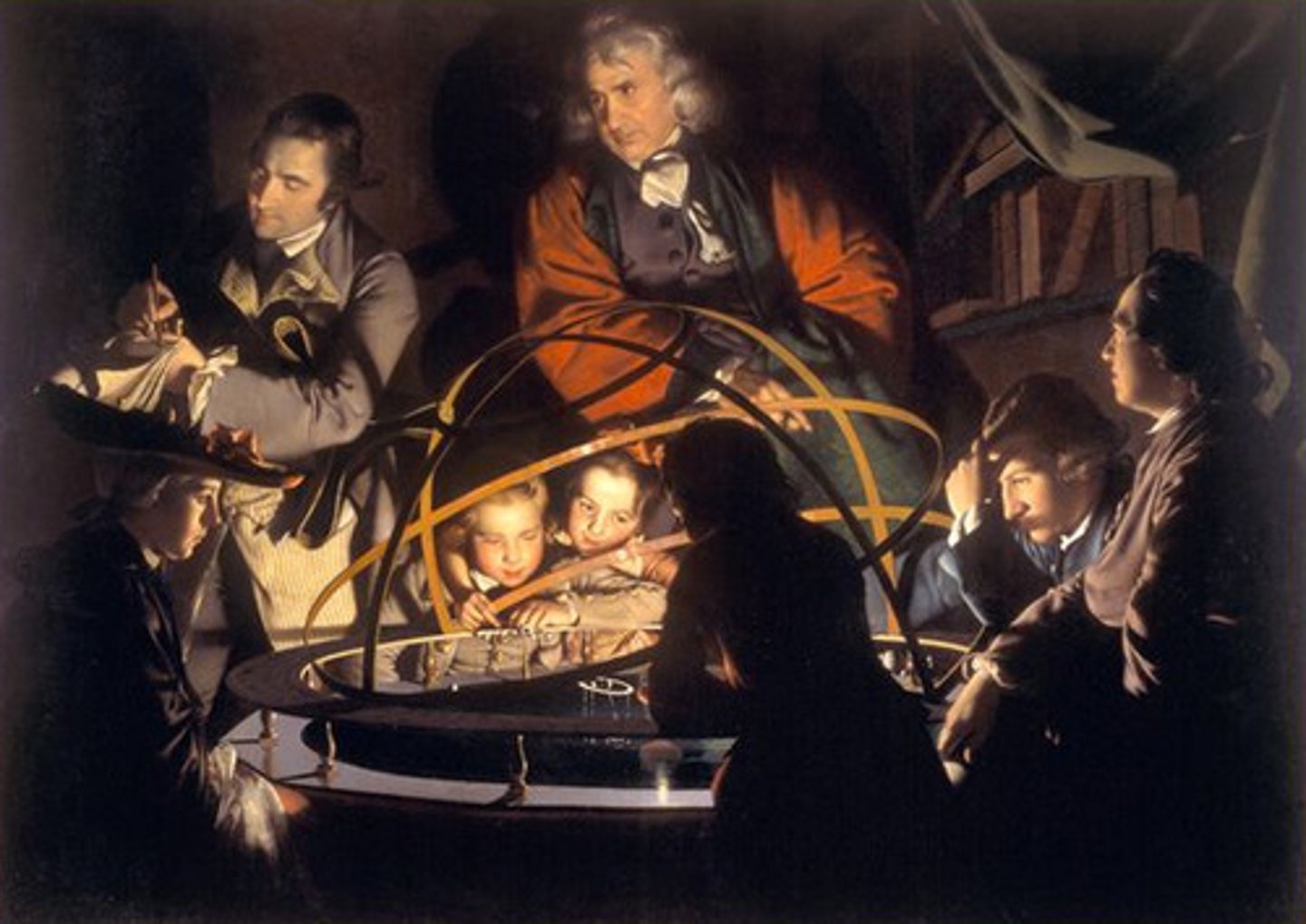AP Art History study for BNAP 250
1/268
There's no tags or description
Looks like no tags are added yet.
Name | Mastery | Learn | Test | Matching | Spaced |
|---|
No study sessions yet.
269 Terms
Apollo 11 Stones, charcoal on slate, 25500-25300 BCE, Namibia
Form:
-stones with charcoal drawings of animals
-geometric designs
- 4-5"
Function:
- depict animals
=some of world's oldest works of art
Content:
- animal figures with human legs added on probably later
Context:
- found in Apollo 11 caves
-probably were made (oldest representational art in Africa) and buried in these caves
-named because it was discovered at the time of the Apollo 11 moon landing

Great Hall of the Bulls, rock painting, 15000-13000 BCE, Lascaux, France
Form:
-naturalistic in a cave
-natural materials: plants, charcoal, iron ore
-twisted perspective
- human are stick figures while animals are realistic looking
Content:
- pictures animals in motion
- pictures on top of pictures (all from different artists from many time periods)
-cows, bulls, horses, deer
-650 paintings
Function:
- to show an animal ritual (very unusual to find pictures of humans/hunting)
-ancestral animal worship
Context:
-sacred place (deep in a cave)- in situ
-not a dwelling because the creators of these were nomads
-Paleolithic Europe
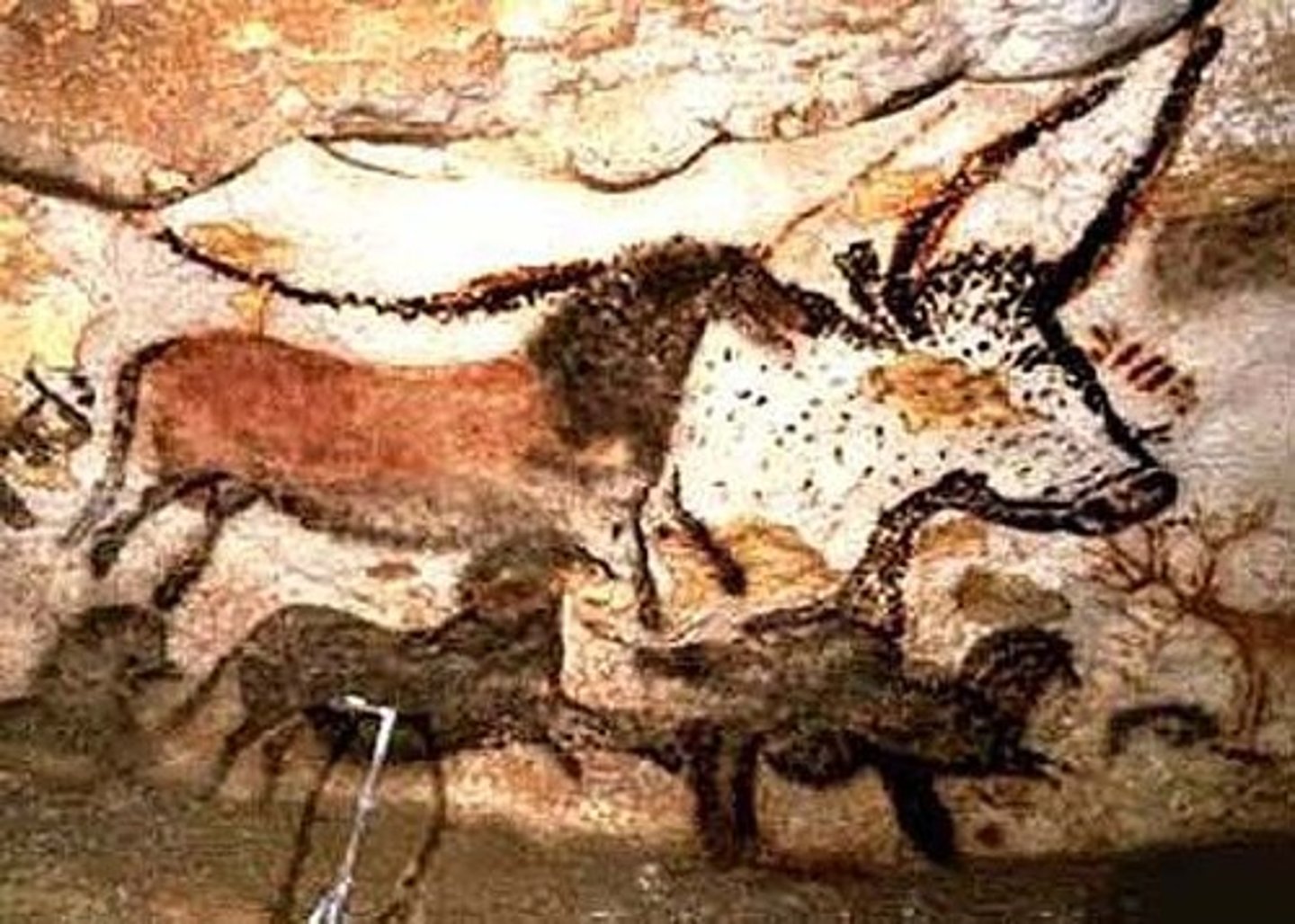
Camelid sacrum, bone, 14000-7000 BCE, Mesoamerican
Function:
-spiritual mask
-house spiritual essence of a hunted animal
-sacrum bone powerful symbolism of Osiris and rebirth- triangle
Content:
- sacrum bone (hip bone) carved in shape of a canine/wolf
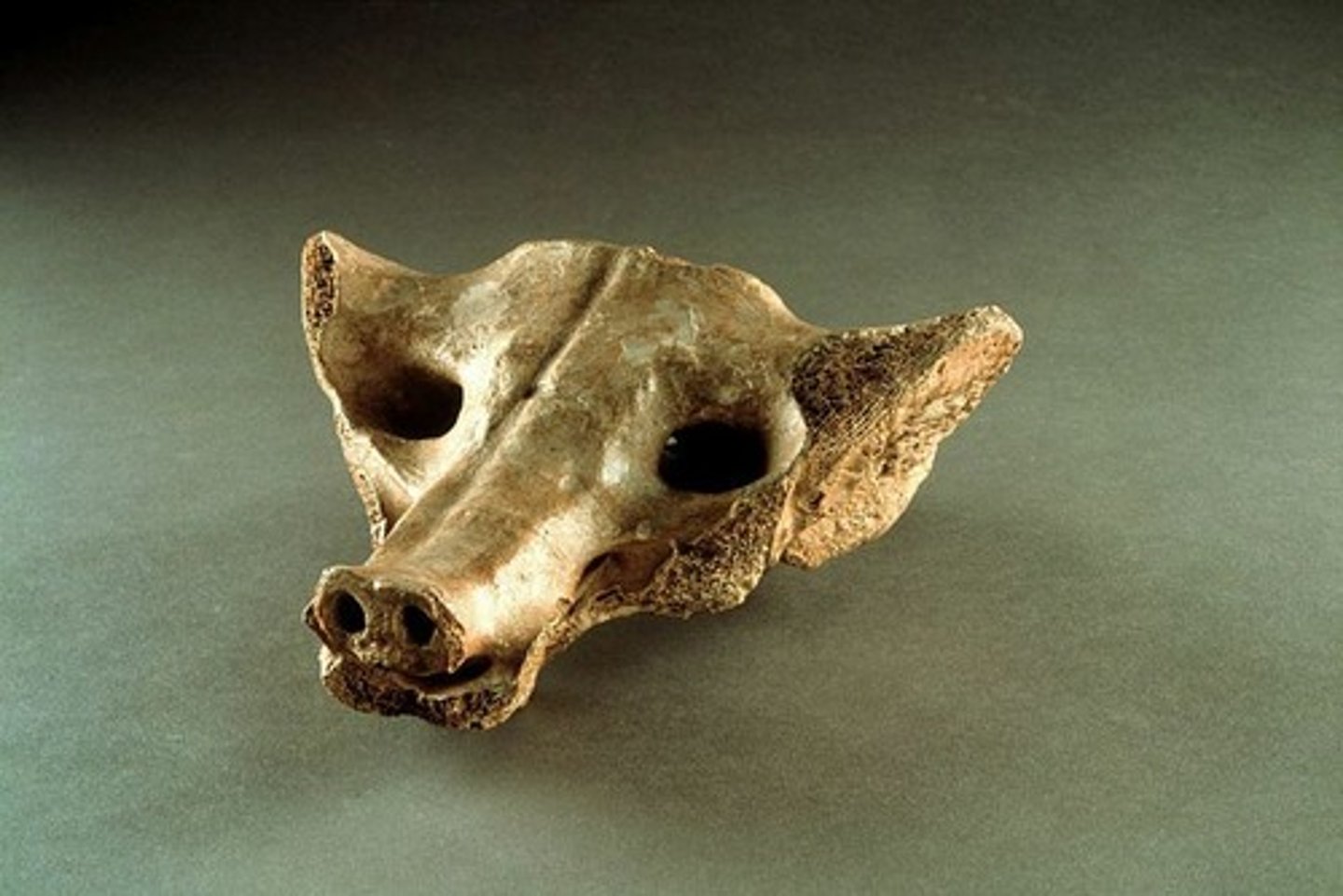
Running horned woman, pigment on rock, 6000-4000 BCE, Tassili N'Ajjer
Form:
- canyon painting (layers of painting from different times so makes it hard for carbon dating)
-depicts motion
Function;
- show this person as holy or a god bc of the horns
Content:
- shows a woman with horns running
- dots on her body represent body painting
- shows a deity wearing ceremonial headgear?
Context:
- in situ on canyon walls in the Sahara
(neolithic)
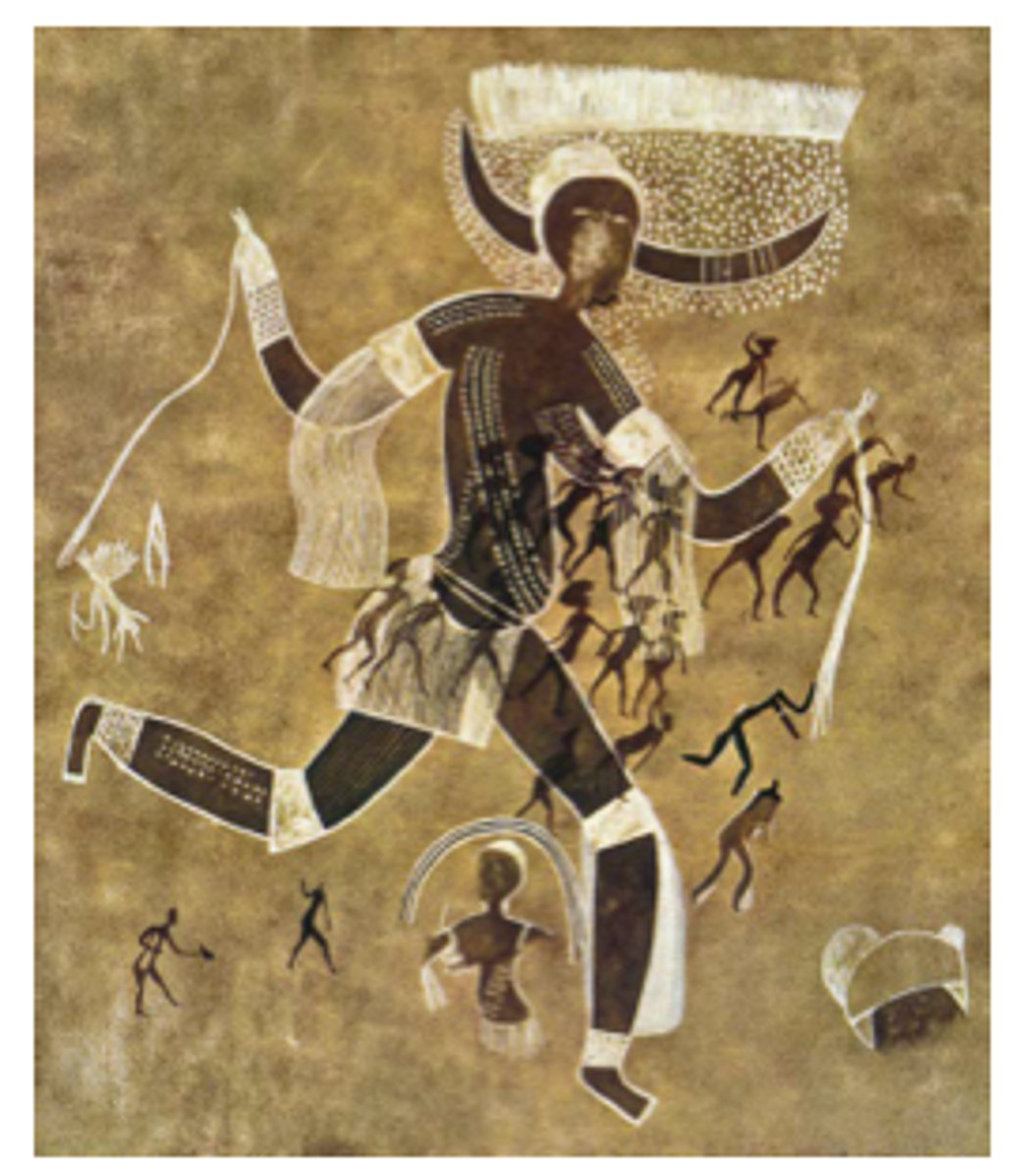
Beaker with ibex motifs, painted terra cotta, 4200-3500 BCE, Susa, Iran
Form:
- geometric forms
- set in registers, controlled and repeated planar composition
Function:
-funerary object
Content:
-dog figures, mountain goat, cranes
Context:
-neolithic
-new technology: use of potter's wheel
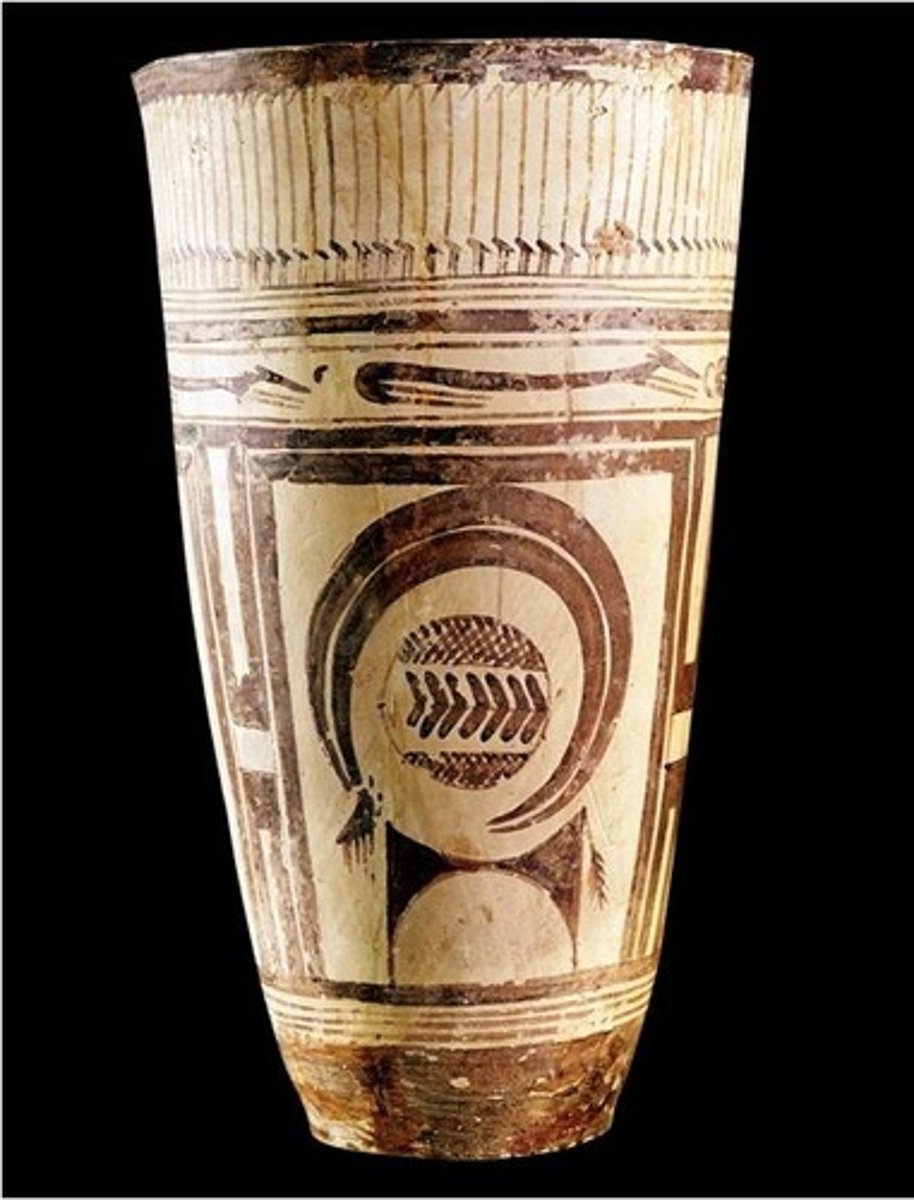
Anthropomorphic stele, sandstone, 4th millennium BCE, Saudi Arabia
Content:
- 3 of them all 3ft tall
-belted robe with knife hanging from it
Function:
- used in incense trade
-religious/burial practices
Context:
-found on trade routes in the Arabian Peninsula
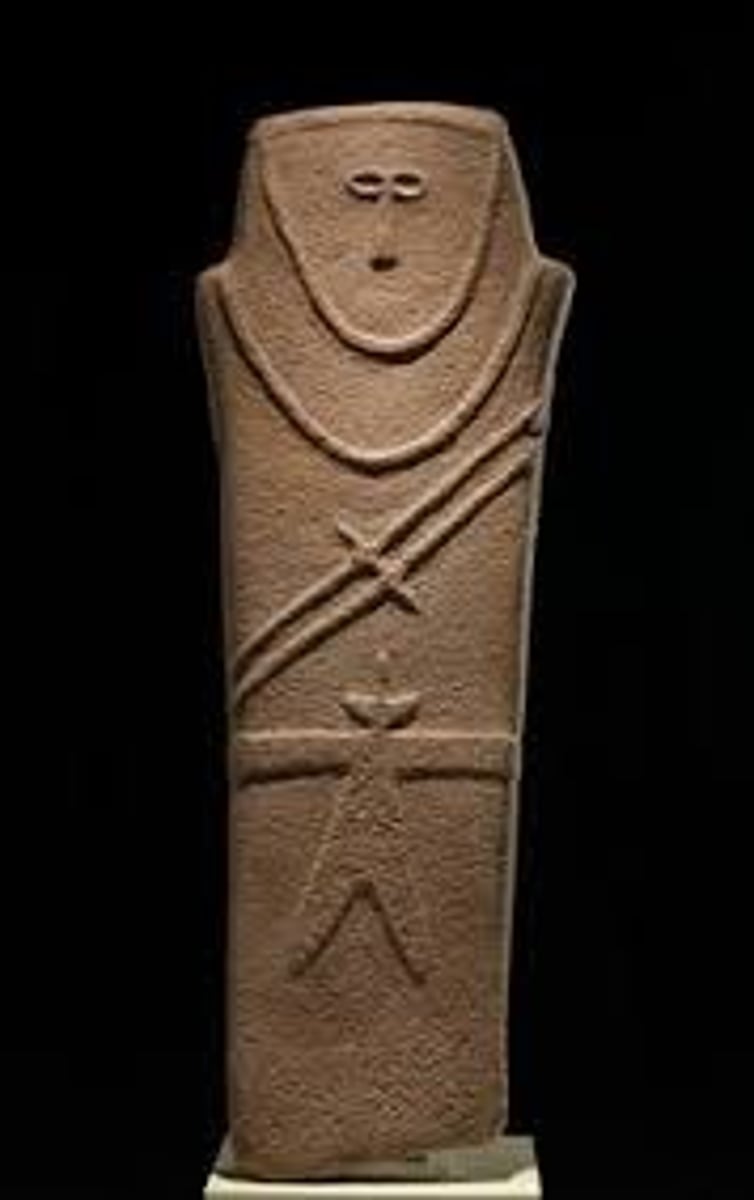
Jade cong, Liangzhu, 3300-2200 BCE
Form:
- carved
-low reliefs
-abstract designs
- square with a circle inside
Function:
-jade usually appears in burials of high ranked people
Content:
-low reliefs
decorations on this refer to spirits/ deities
Context:
-jade in China is linked with virtues like beauty, durability, and subtlety
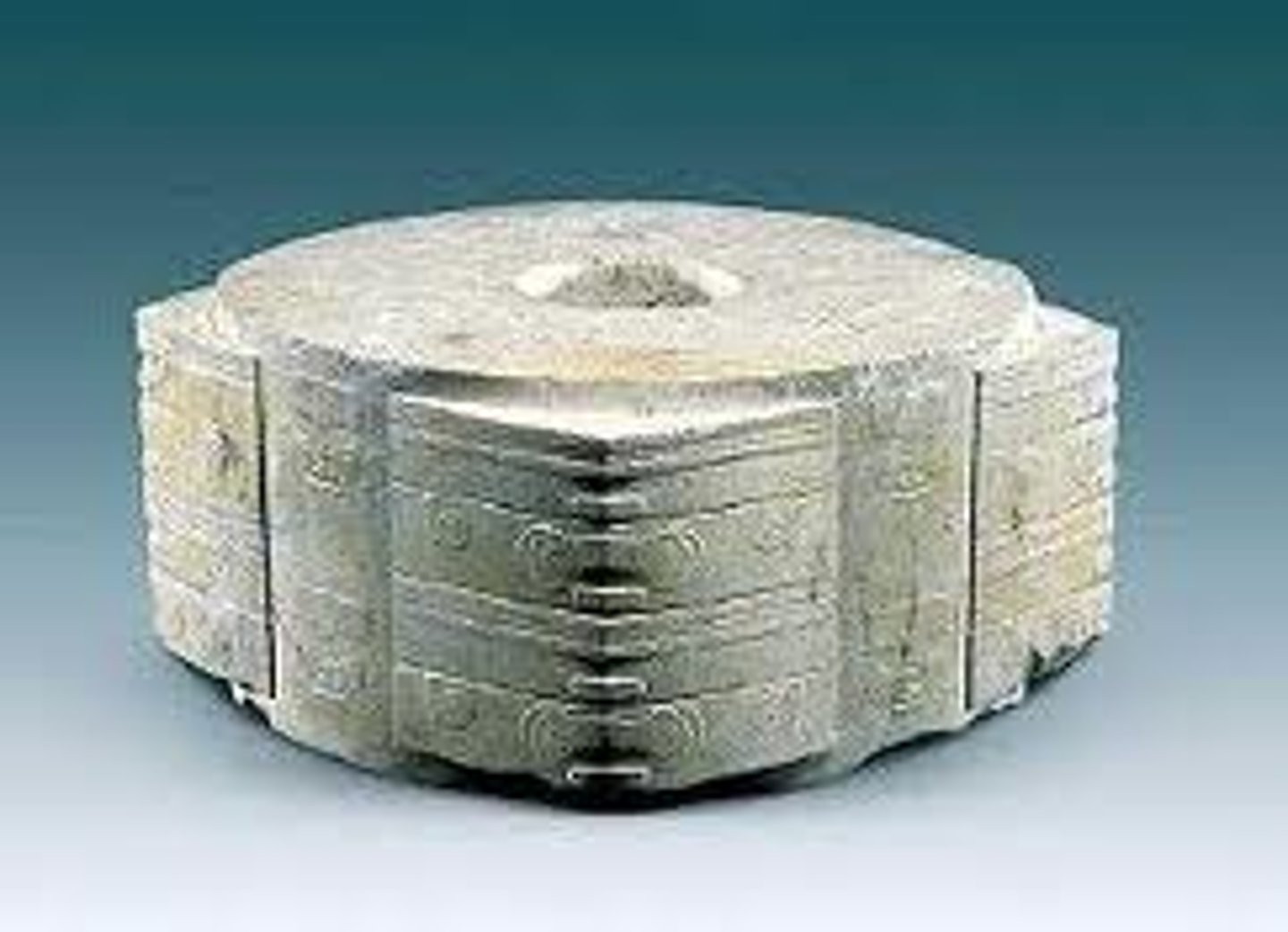
Stonehenge, sandstone, 2500-1600 BCE, Wiltshire, UK
Form:
-post and lintel (two vertical posts support a horizontal beam)
- arranged in a circle (cromlech)
Content:
- stones in a centralized plan
-small stones surrounding in no specific pattern
Function:
- probably religious ceremionies
- burial?
- marker of mid-summer solstice
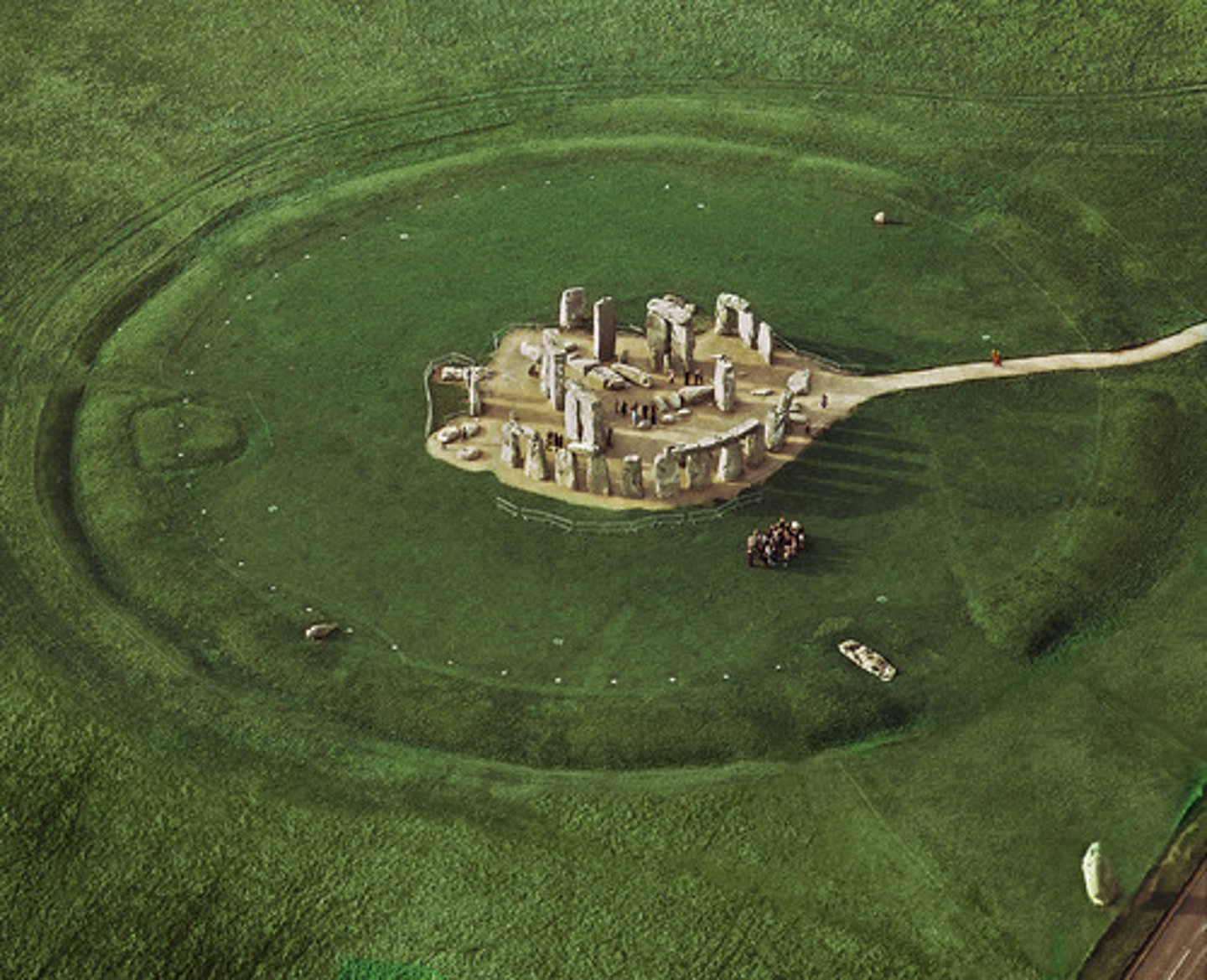
Ambum stone, greywacke, 1500 BCE, Papua New Guinea
Content:
-sculpted to look like an anteater
-human/animal characteristics (mostly animal)
Function:
- objects like these are believed to have supernatural power
- used as a spirit stone in rituals

Tlatico female figure, ceramic, 1200-900 BCE, Mexico
Content:
- pinched waist and big hips with two-heads
- no hands or feet
-naked except for jewelry
Function:
- show fertility
-two heads represent life and death that happens everyday
Context:
-many of the other figures show deformities like this
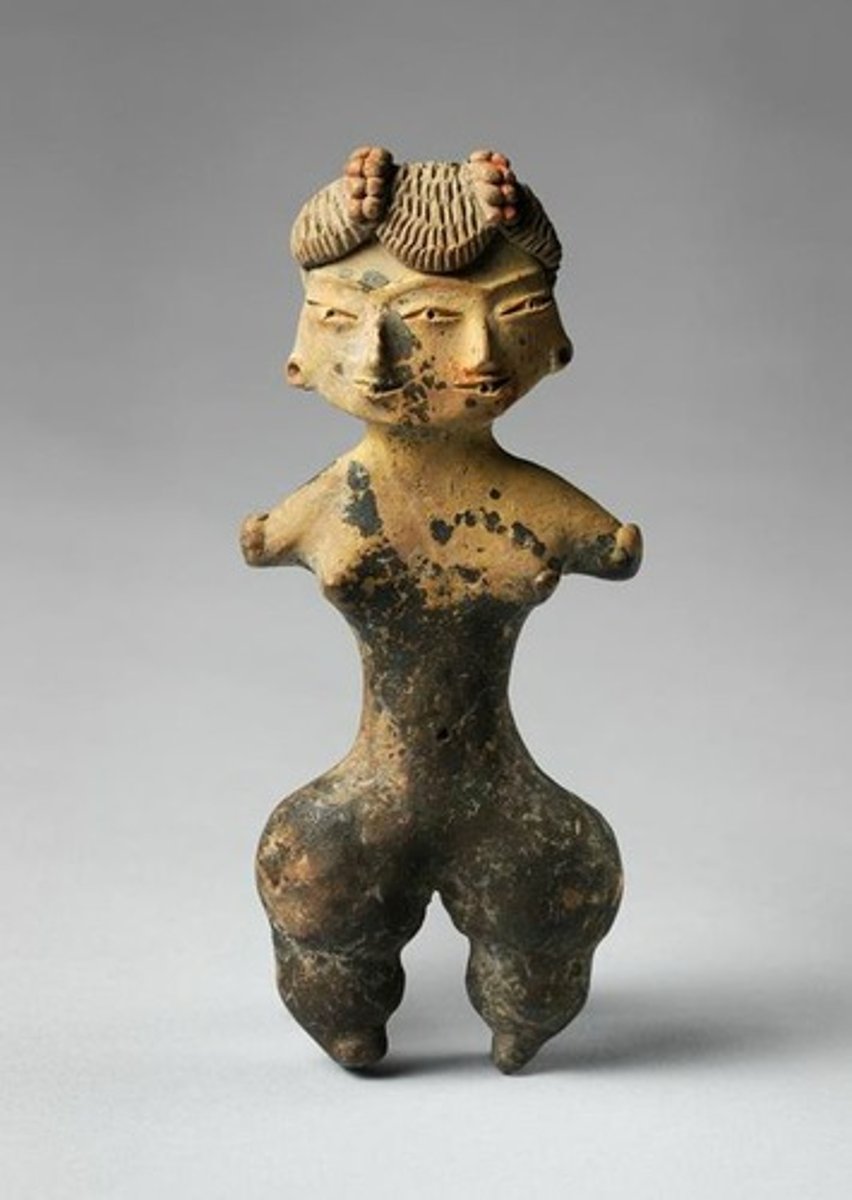
Terra cotta fragment, 1000 BCE, Reef/Soloman Islands
Form:
-terra cotta with dentate stamping
Content:
-dentate designs (circles, hatching, dots)
Function:
-unknown
Context:
- Lapita peoples
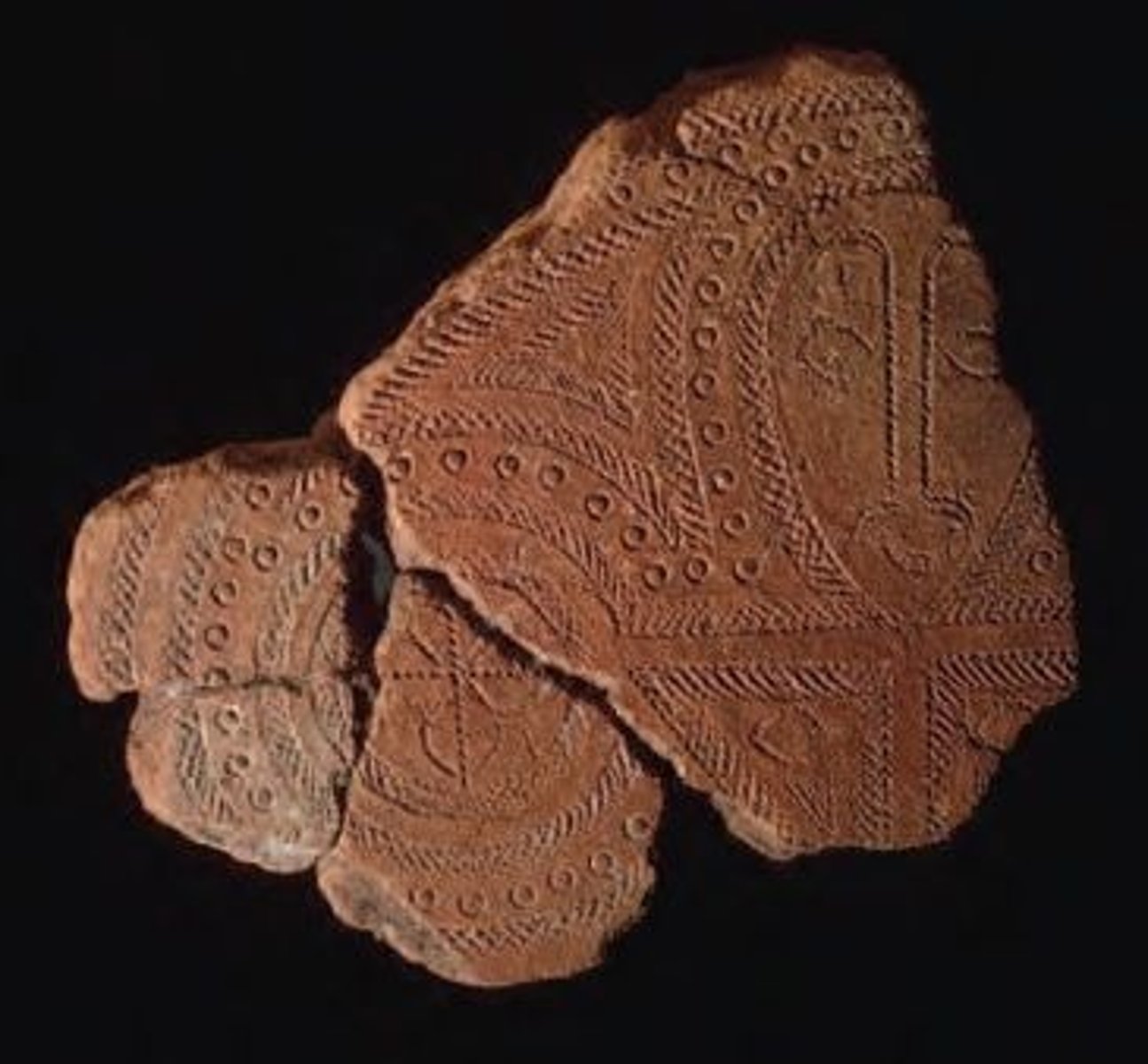
White Temple and its ziggurat, mud brick, 3500-3000 BCE, Urak, Iraq
Form:
-collosal scale
-built to resemble mountain
Content:
- sloping walls, bent access (ramp up to enter the altar), 3 entrances
-mosaic surface
Function:
- temple that is a meeting place for humans and gods in the center of the city
-votive figures and dedicated to Anu the sky god
-top temple was only for royals or clergy to enter
Context:
- Uruk; Modern day Warka, Iraq
-Sumerian
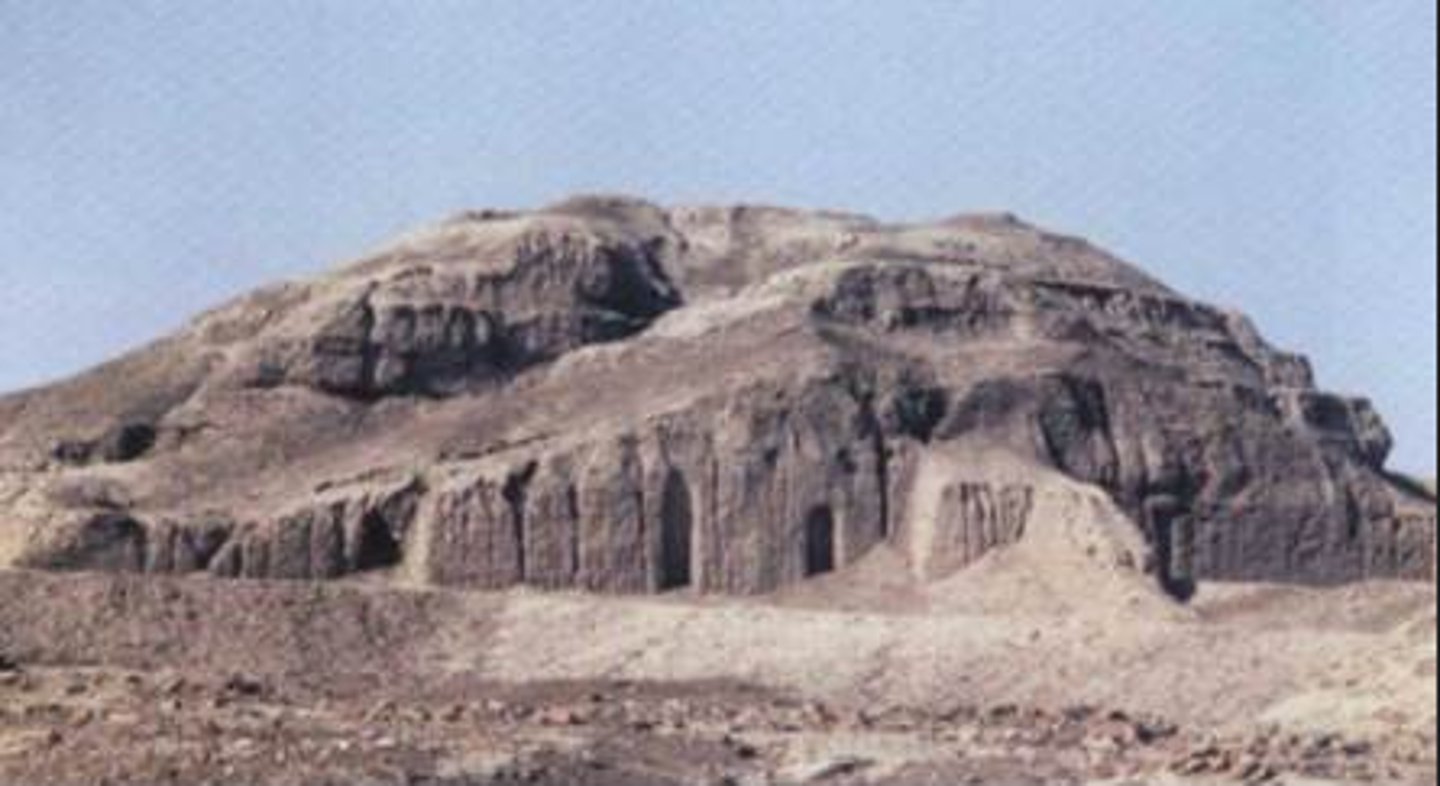
Palette of King Narmer, greywacke, 3000-2920 BCE, predynastic Egypt, Function: represents the unification of Egypt and country's growth as a powerful nation
Form:
-organized in registers
-hierarchic scale
-low relief, twisted perspective
Content:
-Front: Narmer (on large scale) looking on the beheaded bodies of his enemies wearing crown of lower Egypt, harnessed lionesses (symbol of unification), bull knowcking down a city fortress (Narmer knocking over enemies)
-Back: Hawk=Horus, Narmer wearing bowling pin crown (symbol of unification), stands barefoot (he is a divine king), palette for eye makeup, hieroglyphics
Context:
-found in temple of Horus
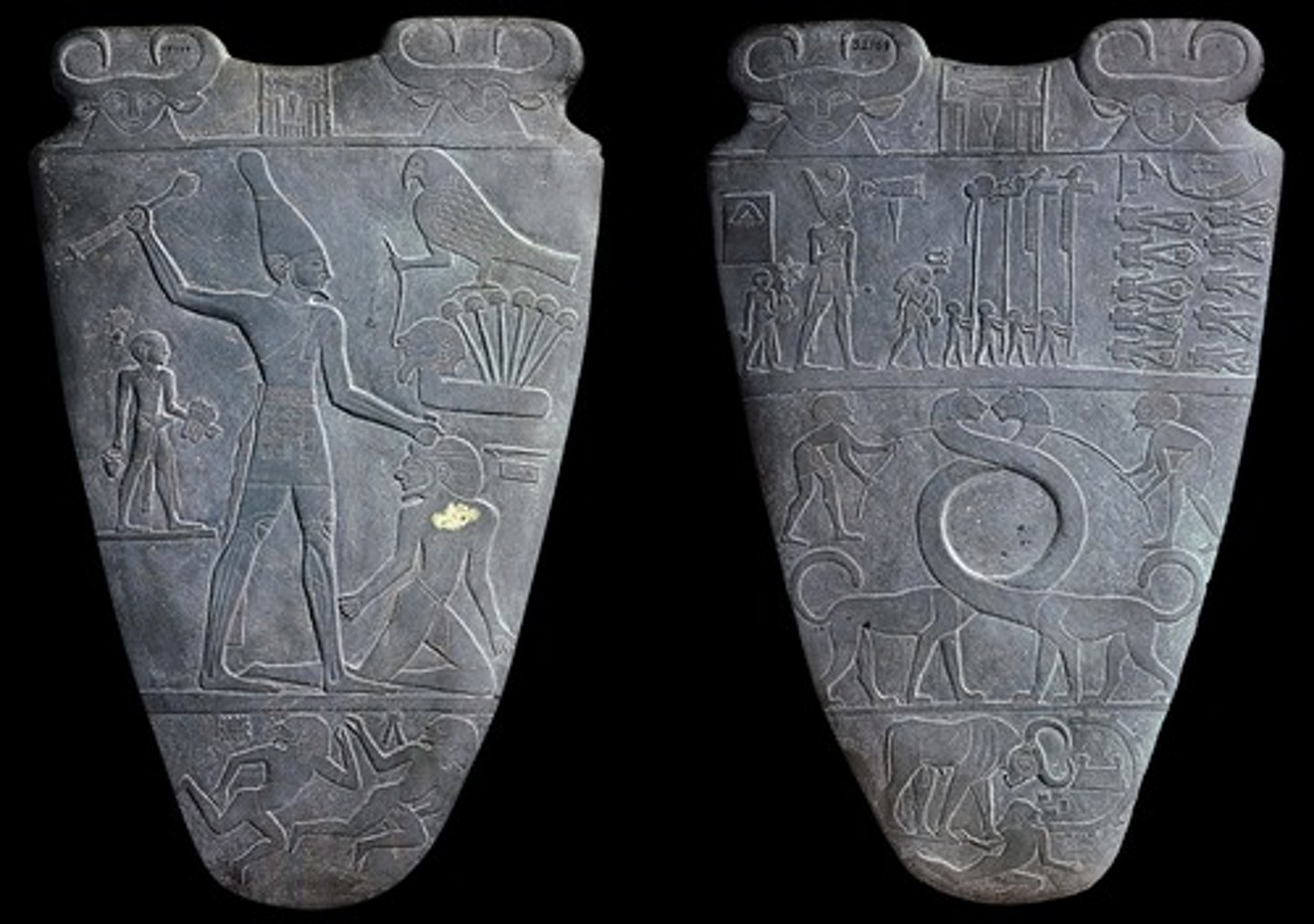
Votive figures, gypsum with shell and black limestone, 2700 BCE, Temple of Eshunna
Form:
- bilateral symmetry
- eyes exaggeration (beholding the divine)
Content:
-the hands are placed in prayful gesture
- elite male and female figures
Function:
-placed in ziggurat to resemble the people that aren't allowed to be in the ziggurats
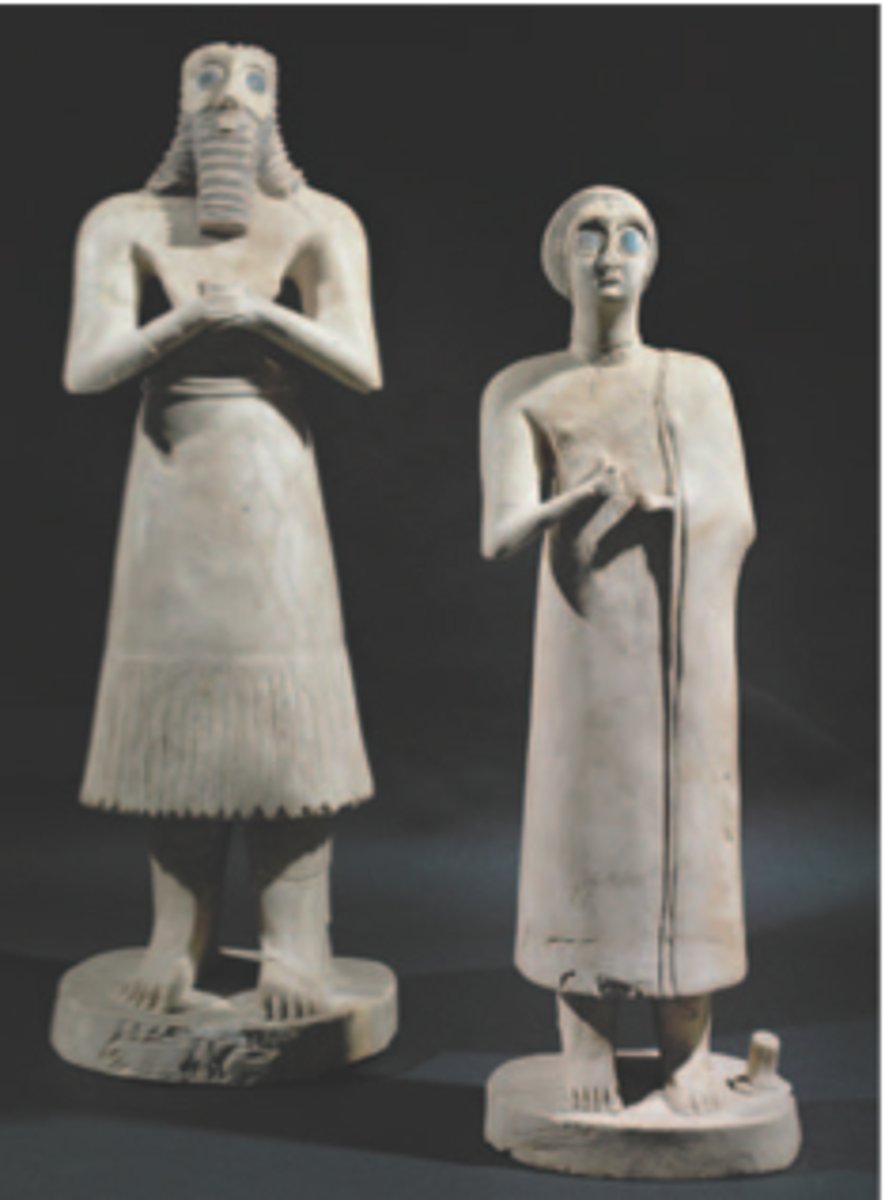
Seated Scribe, limestone, old kingdom, Egypt
Form:
-crystal limestone eyes
Content:
-royal scribe
-depicted with sagging body (realistic not ideal), thin face
-holding tools to show he is ready to write
Function:
-shows that the scribe is important but not perfect like a pharoah
-made for tomb at Saqqara for the ka
Context:
-found near tomb (funerary object)
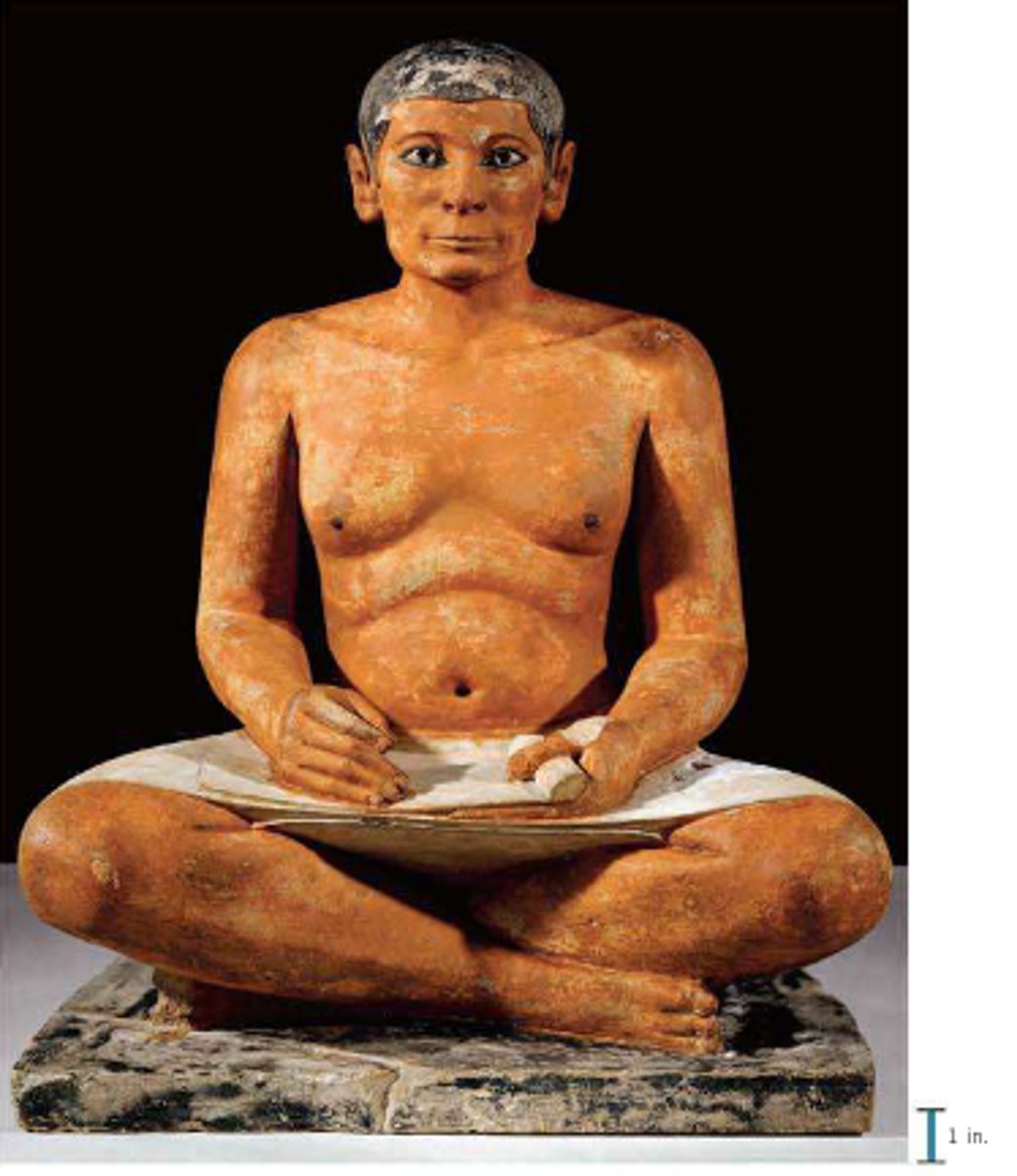
Standard of Ur, wood inlaid with shell, lapis lazuli, black limestone, sumerian, 2600-2400 BCE, Iraq
Form:
-mosaic
-hierarchic scale to show who was more important in society
-front shoulds, body in profile
Content:
-2 sides: war side and peace side
-war side: shows Sumerian king on larger scale descending from his chariot to inspect captives, lower register shows him riding over dead bodies in his chariot
-peace side: food brought to a banquet, ruler wears a kilt of wool (larger scale)
Function:
- shows the different classes of people
-democratic leadership
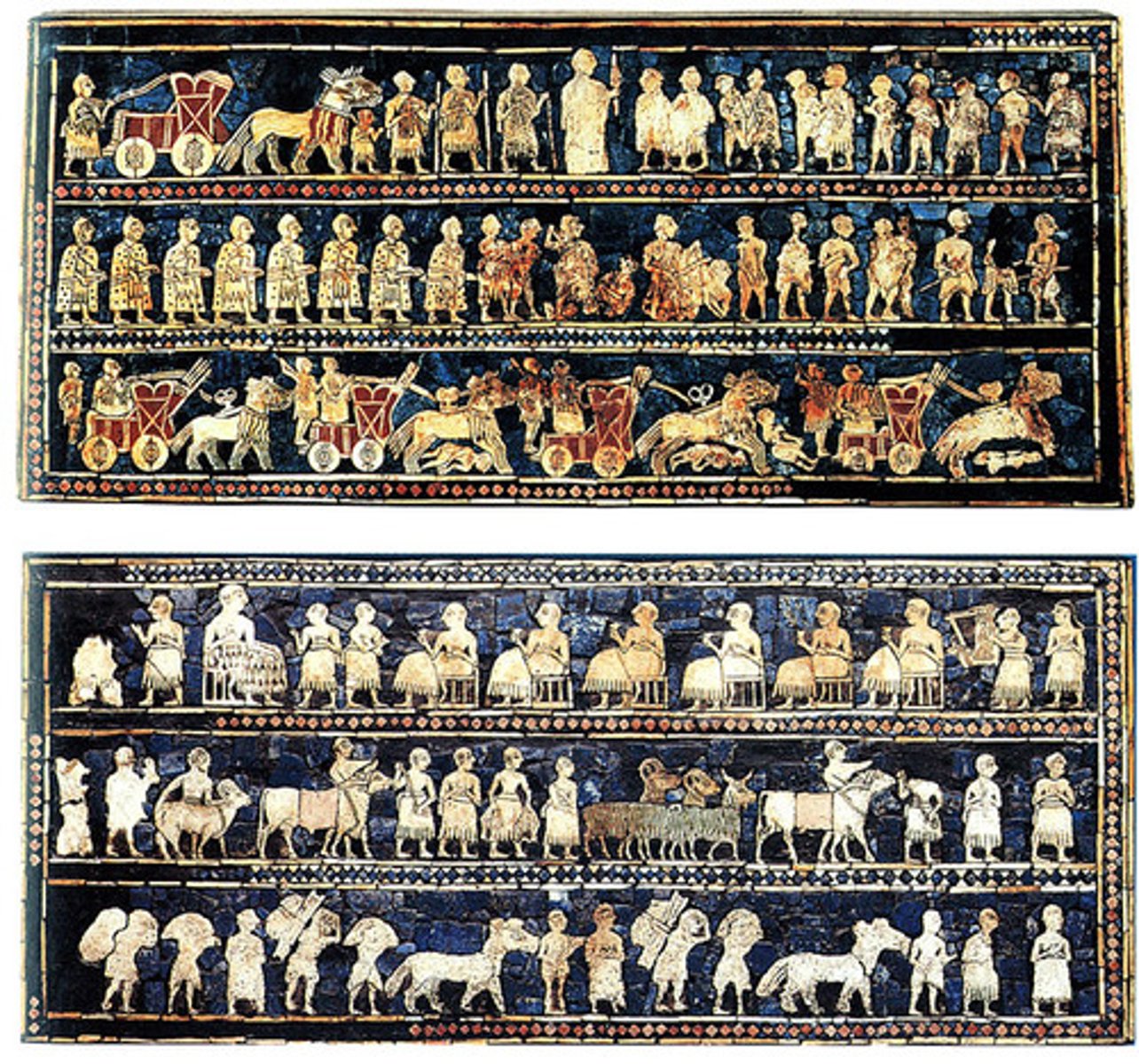
Great Pyramid and Great Sphinx, limestone, old kingdom, Giza, Egypt
Form:
-square base with 4 sloped sides (represents rays of sun)
Content:
-pyramids with adjoining funerary complex; get to these through secret passageways
-Great Sphinx: human head with lion head
-descending order on West side of Nile
Function:
-maintain and protect tombs for eternity
-Great Sphinx: protecter the pyramids behind it
Context:
-built by Khufu, Khafre, and Menkuare (each temple name after)
-Khufu temple (oldest and largest)
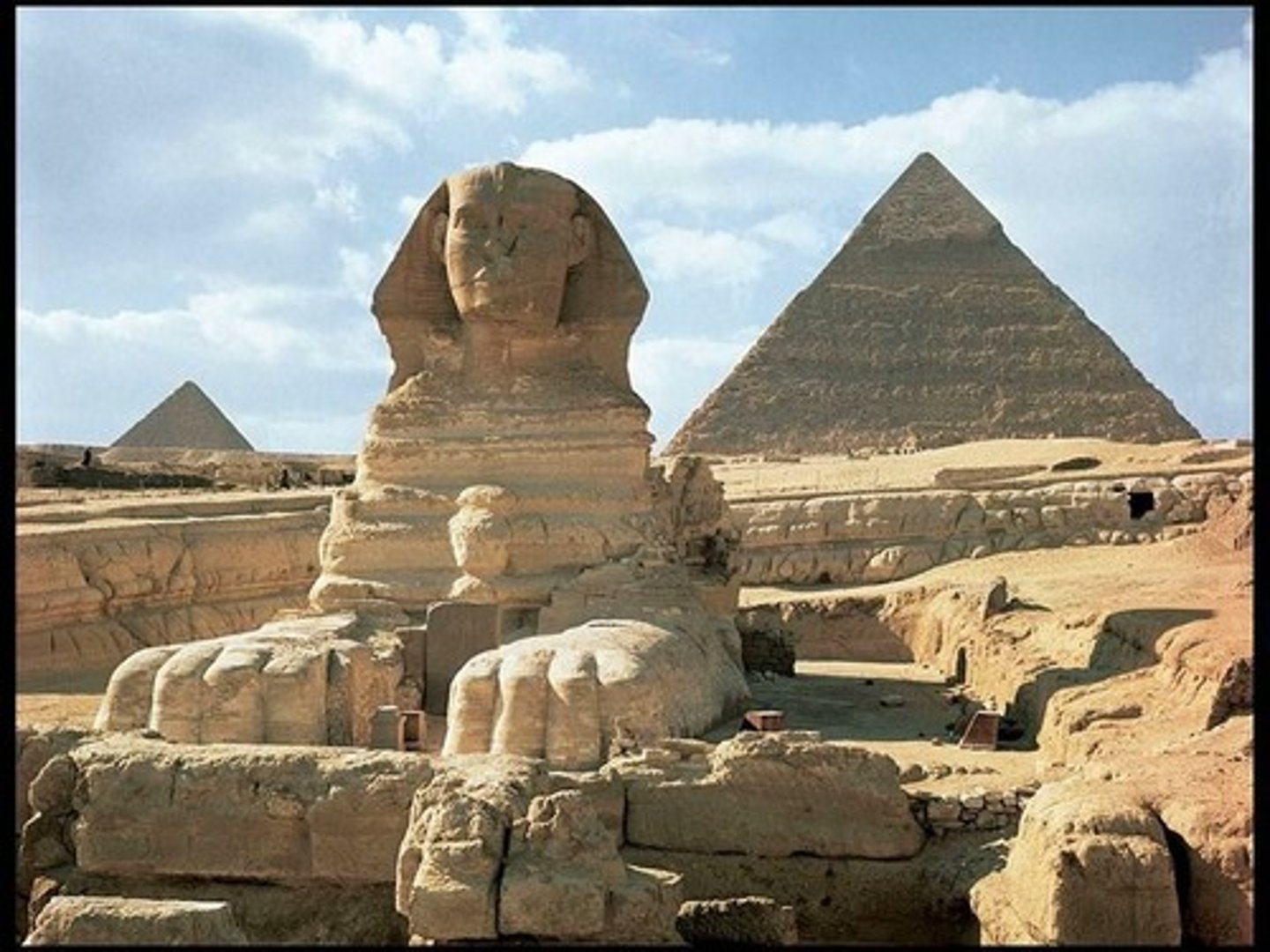
Menkaura and queen, greywacke, old kingdom,
Function:
-temple sculpture
-symbolize his power and kingship
Form:
-under life-size
-symmetrical
-Egyptian style: one foot in front of the other
Content:
-king and queen same height, idealized figures
-pharaoh crown
-wife gives simple affectionate gesture
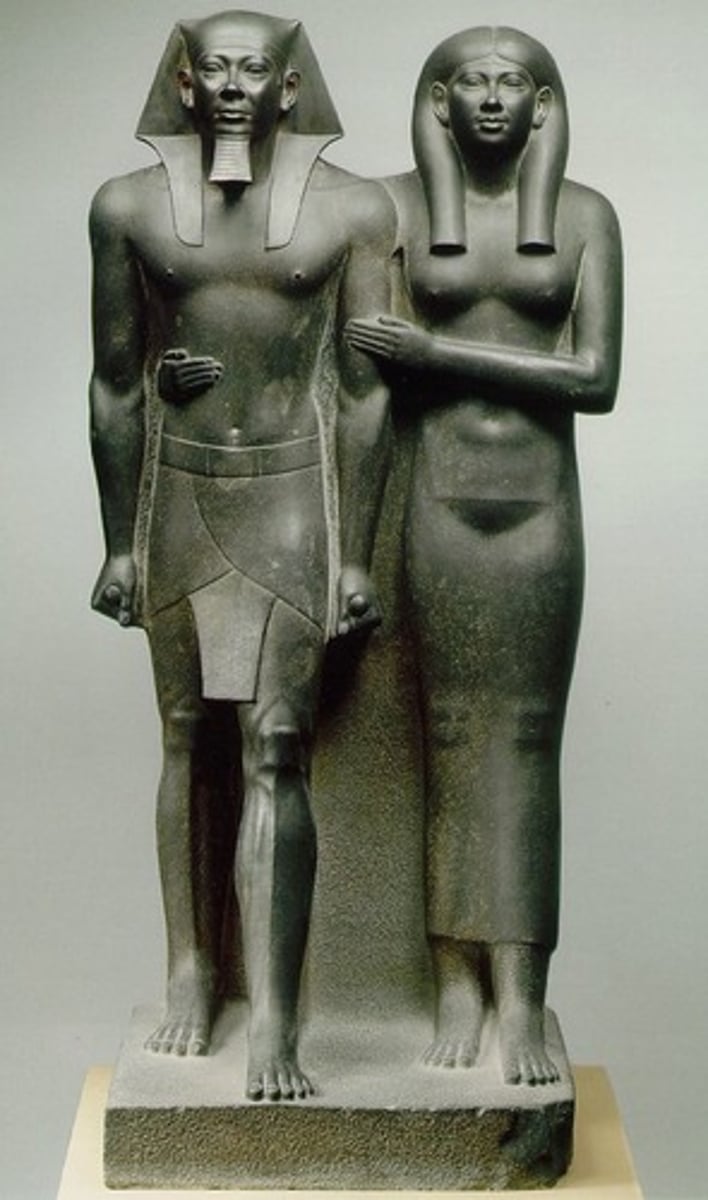
Code of Hammurabi, basalt, 1792-1750 BCE, Babylon
Form:
-black-stone stele with words carved in it
-frontal shoulders, everything else profile
Content:
-divine law code carved in stone
-sun god, Shamash, giving laws to Hammurabi to be king
-god is bigger (hierarchic scale)
Function:
-tells us where the laws came from
-exercises justice and divine authority to carry out the law
Context:
-Susian
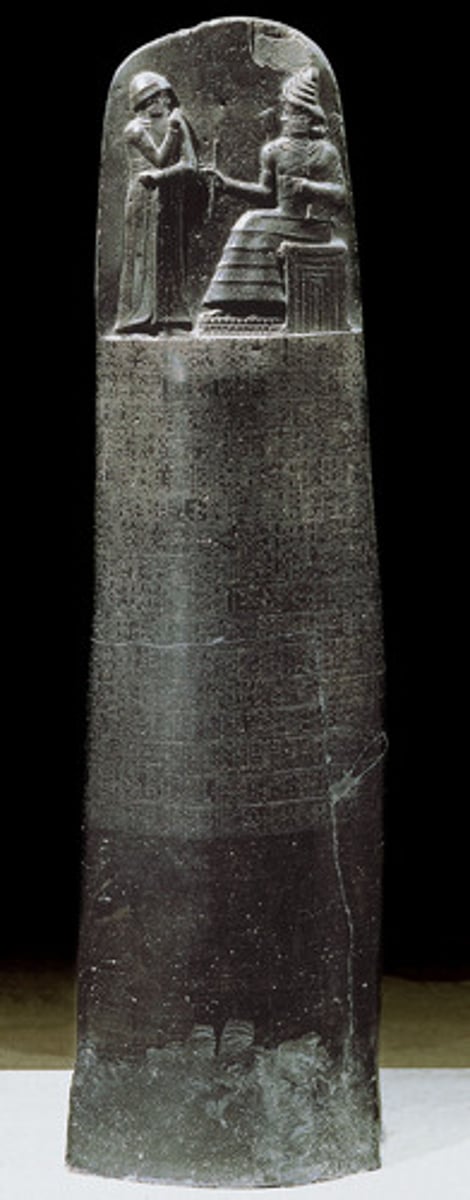
Temple of Amun-Re and Hypostyle Hall, cut sandstone and mud brick, new kingdom, Karnak near Luxor
Form:
-hypostyle hall
-symmetrical plan, axial plan
-open ceilings
-colossal columns with sunken relief
Content:
-134 sandstone columns
-inscriptions/images of kings and gods on walls and columns
-gates (suggesting old world to new world)
Function:
-used for festivities and prayer
-only priests and pharoahs allowed
Context:
-East side of the Nile
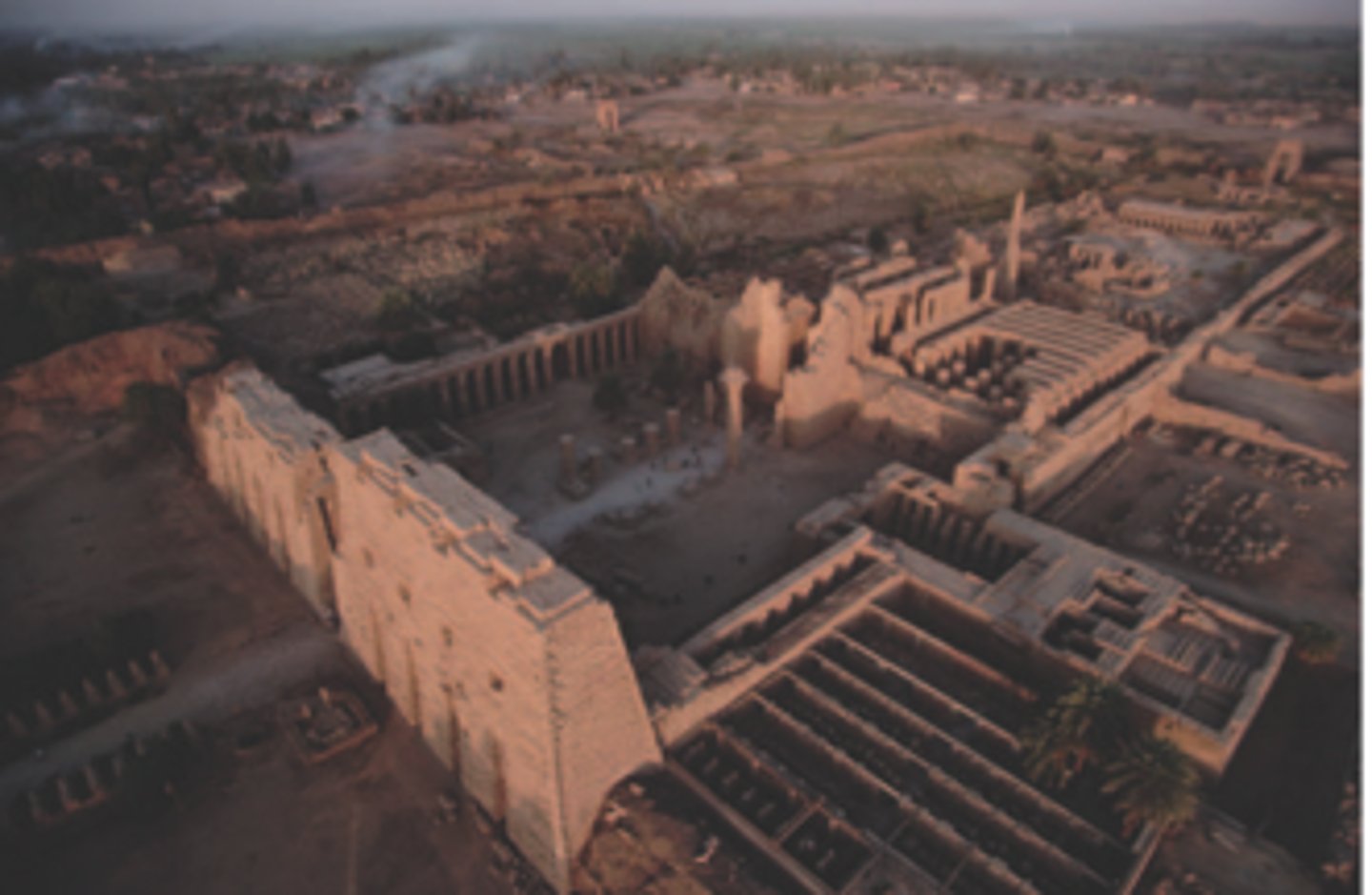
Mortuary Temple of Hatsheput, sandstone, new kingdom, near Luxor,
-mortuary temple for Hatsheput but she wasn't buried there
-statue shows her power in male ways (beard and kneeling is priest-like gesture
Form:
-built into rock cliff
Content:
-statue of Hatsheput kneeling: offering plants to Amen, the sun god
-ascent up to temple
-chapels and shrines dedicated to her
-hypostyle hall
Context:
-site specific
-across from Amun temple
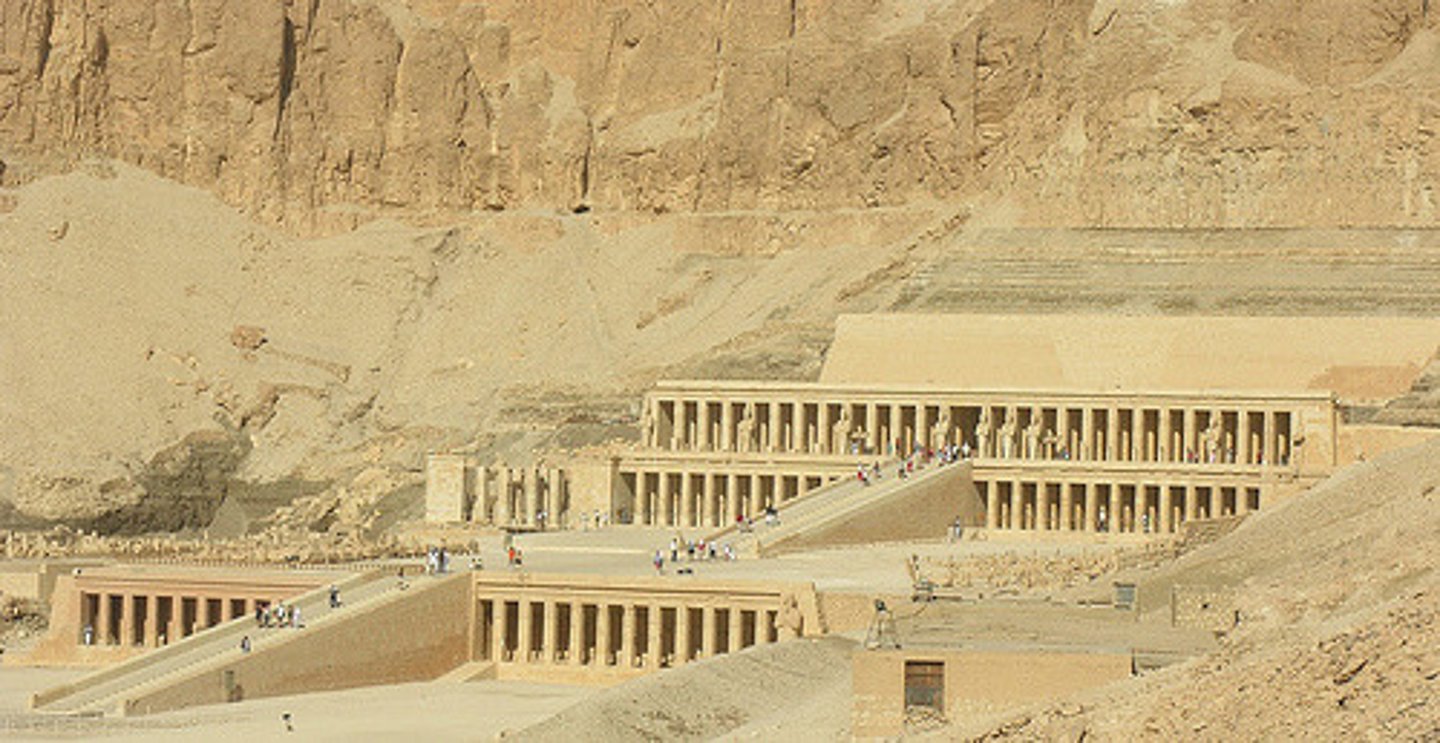
Akhenaton, Neferiti, and three daughters, limestone, new kingdom (amarna)
Form:
-sunken relief piece, hieroglyphics
Content:
-couple receiving blessing from Aten (the sun god-rays shown)
-show husband and wife seated with their children
-rays shining upon the family showing their divinity
Function:
-shows intimacy of the family
-conveys realistic fidgetiness of children
-state religious shift in evolving Egyptian art
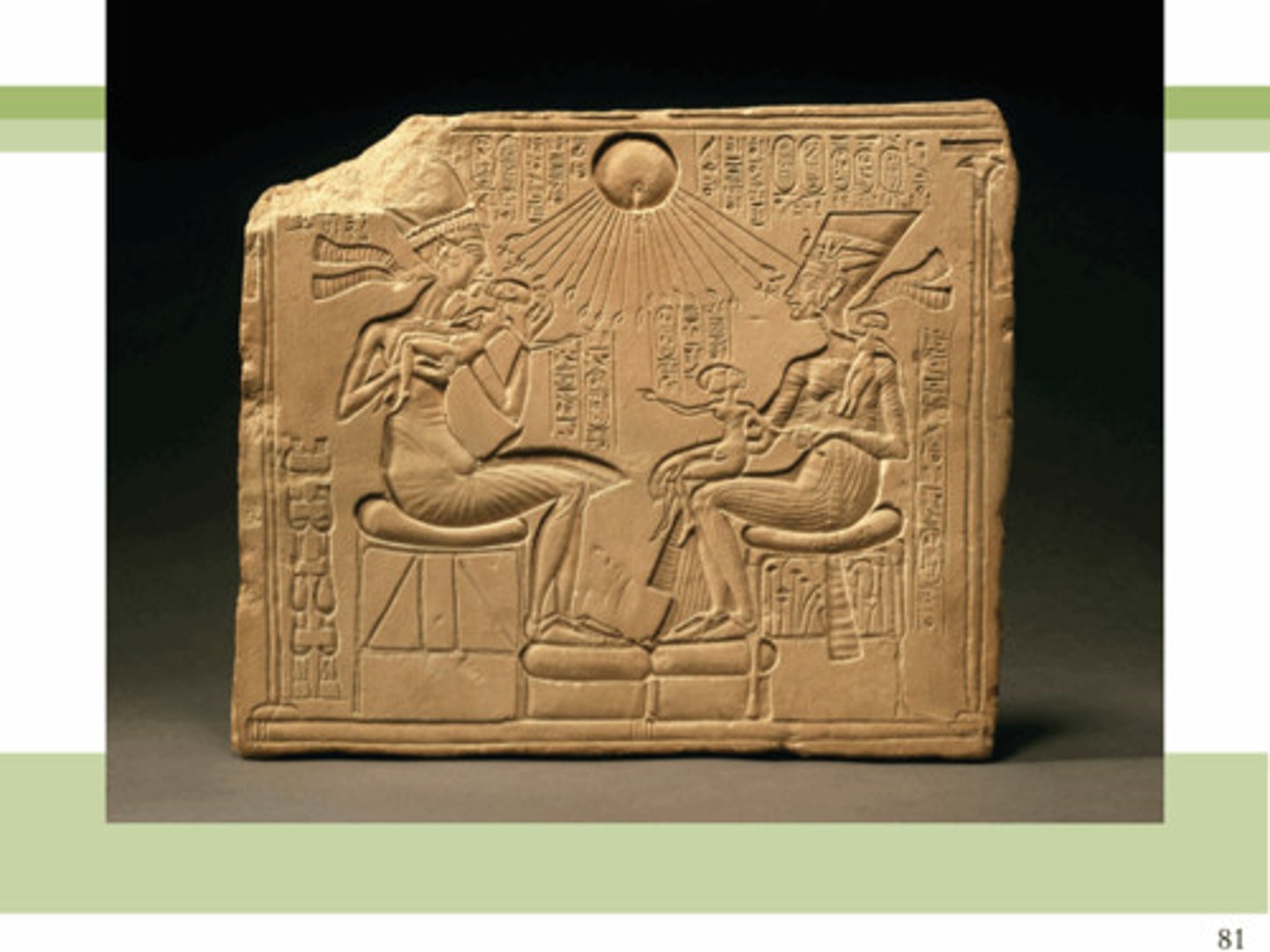
Tutankhamun's tomb, gold and enamel, new kingdom
Form:
-inlay with stones and
Content:
-crook and flail- symbols of Osiris
-cobra and vulture coming from headpiece- gods of Upper and Lower Egypt
-Son of Akhenaton
Function:
-sarcophagus (body inside)
-materials used represent the royal wealth (143 objects buried with him)

Last Judgement of Hu-Nefer, painted papyrus scroll, new kingdom
Form:
-continuous narrative
Content:
-Hu-Nefer being lead to final judgement
-heart weighed on scale against Osiris (test to see if has a heavy heart)
-sin must weigh less than feather
-Hu-Nefer is accepted into afterlife
Function:
-guide people to the afterlife and make journey from life to death
Context:
-found in Hu-Nefer's tomb
-from the Book of the Dead
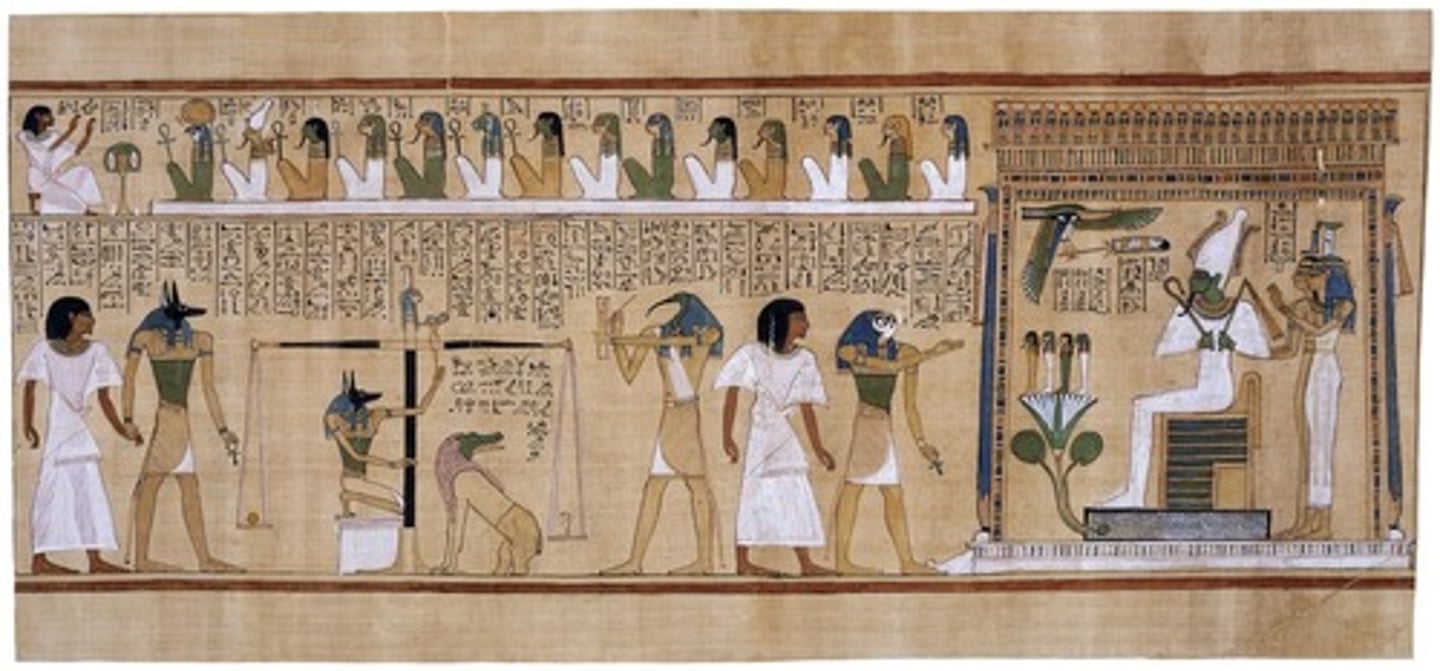
Lamassu, alabaster, 720-705 BCE, Assyrian
Content:
-god-like figures
-animal body, human head
-5 legs
Function;
-support doorways of palaces
-intimidate those who enter
Context:
- from the citadel of Sargon II (modern day Iraq)
-Sumerian
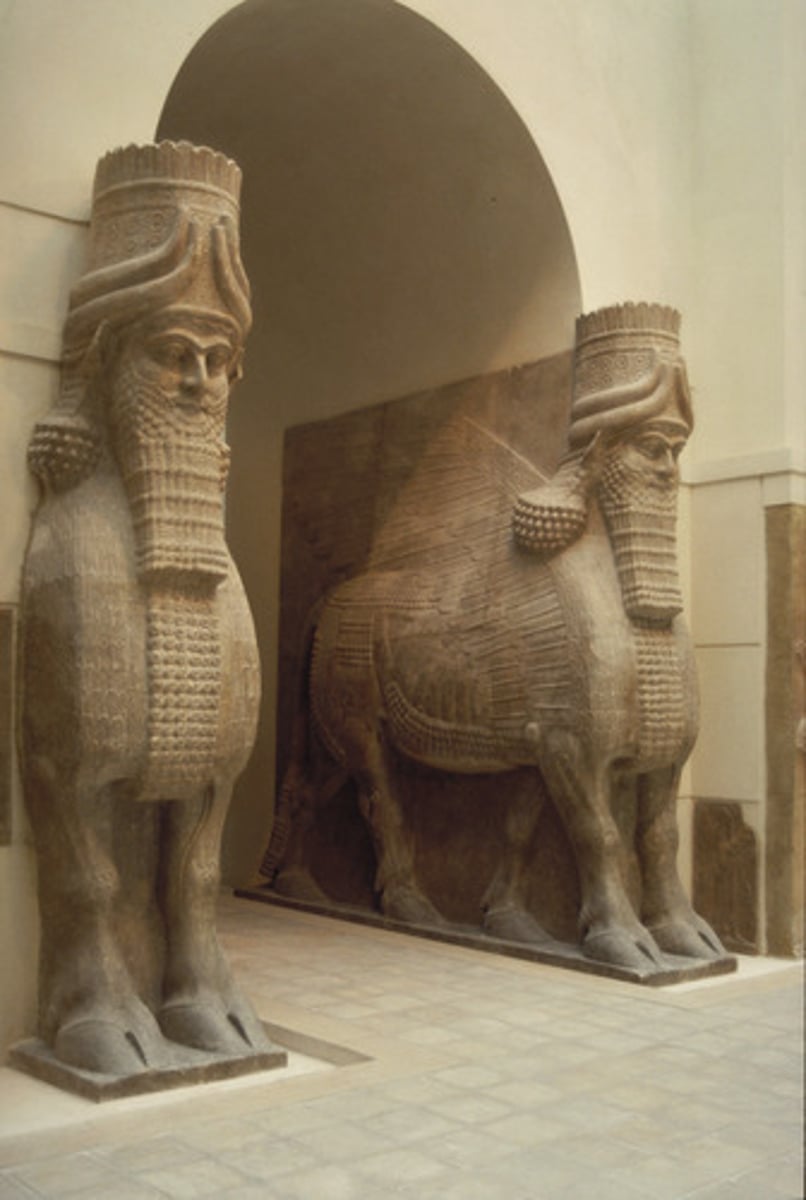
Athenian Agora, 650-150 BCE, Greek
Form:
-long buildings (stoa)
-covered places- public markets
-at foot of Acropolis, road that leads up
Function:
-marketplace/meeting area
-temple (pay tribute to Athena)
Content:
-participated with government
-democracy- didn't vote representatives but instead participated directly
Context:
-Athens, Greece
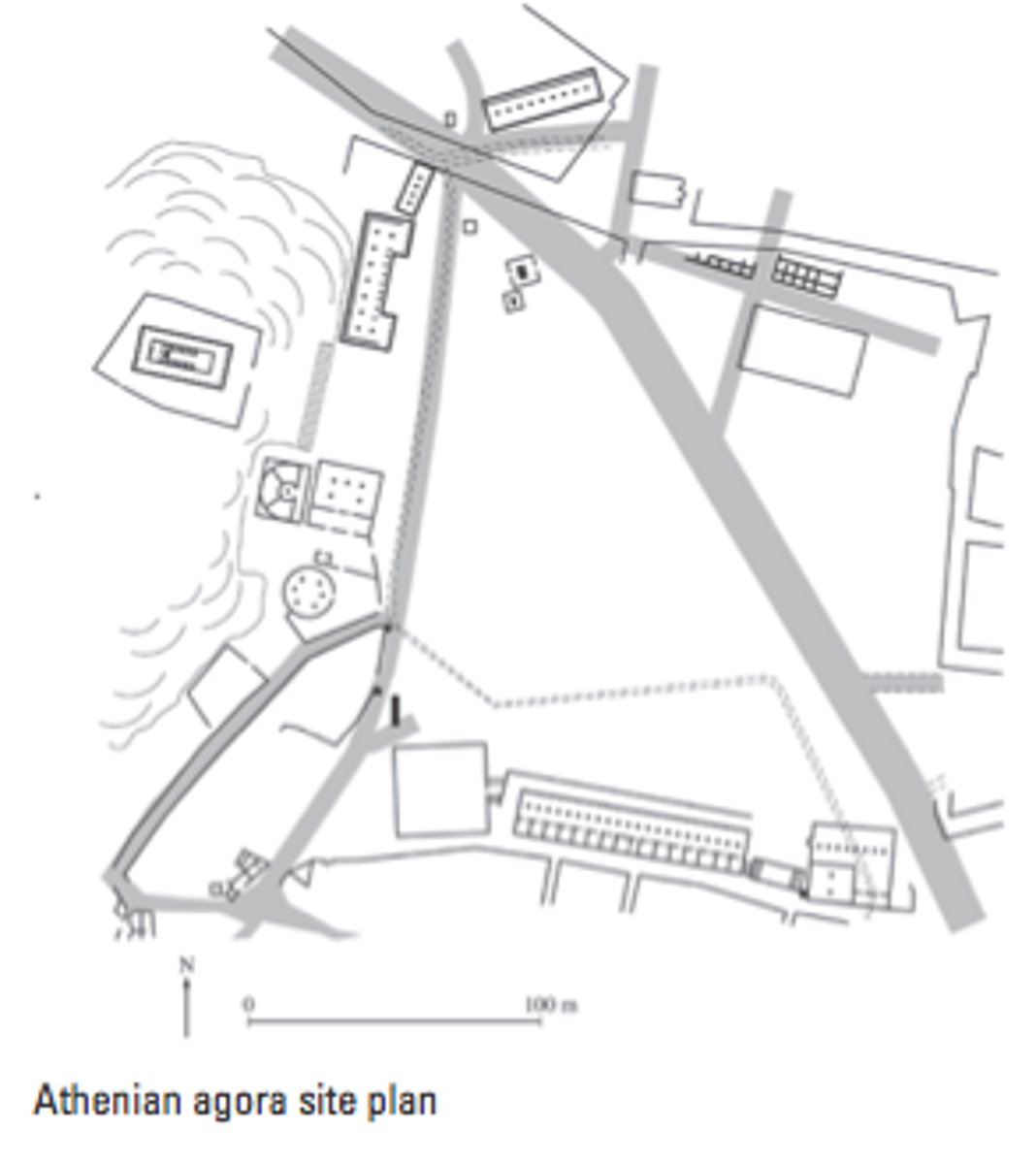
Anavysos Kouros, marble, archaic greek
Form:
-marble with remnant of paint
-smile
-Egyptian inspiration shown through the stance of one foot slightly in front of other
-incaustic paint
Content:
-not a specific civilian depicted (not individualized)
-male nude (warrior)
-observing the human body
Function:
-grave marker
Context:
-large scaled
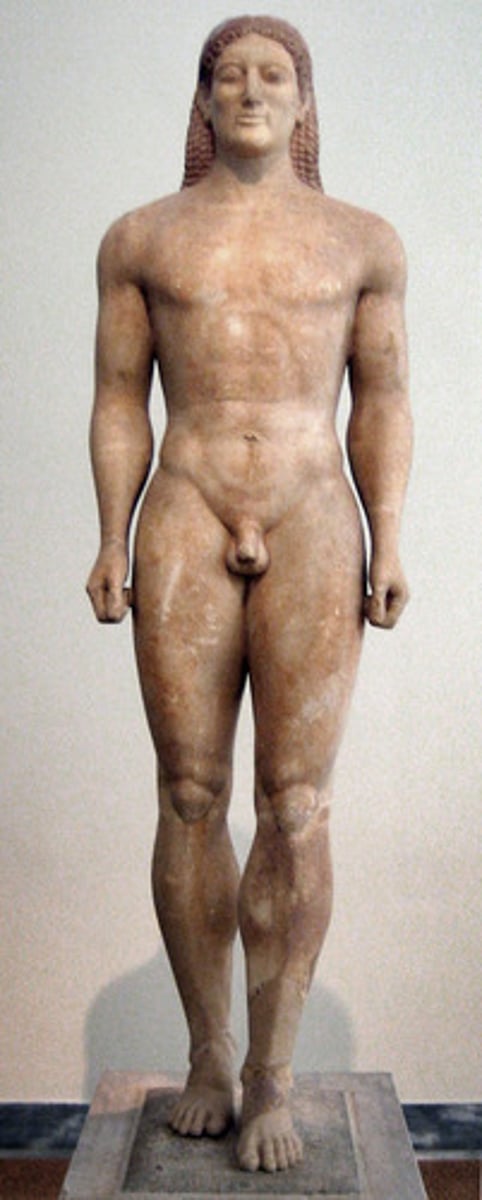
Peplos Kore, marble, archaic greek
Form:
-smile
-patterned hair
-marble with paint remains
-smaller scale
Content:
-women with arm out (supposed to hold out a oil lamp but hand broken off)
Function:
-in front of temples to "light the way"
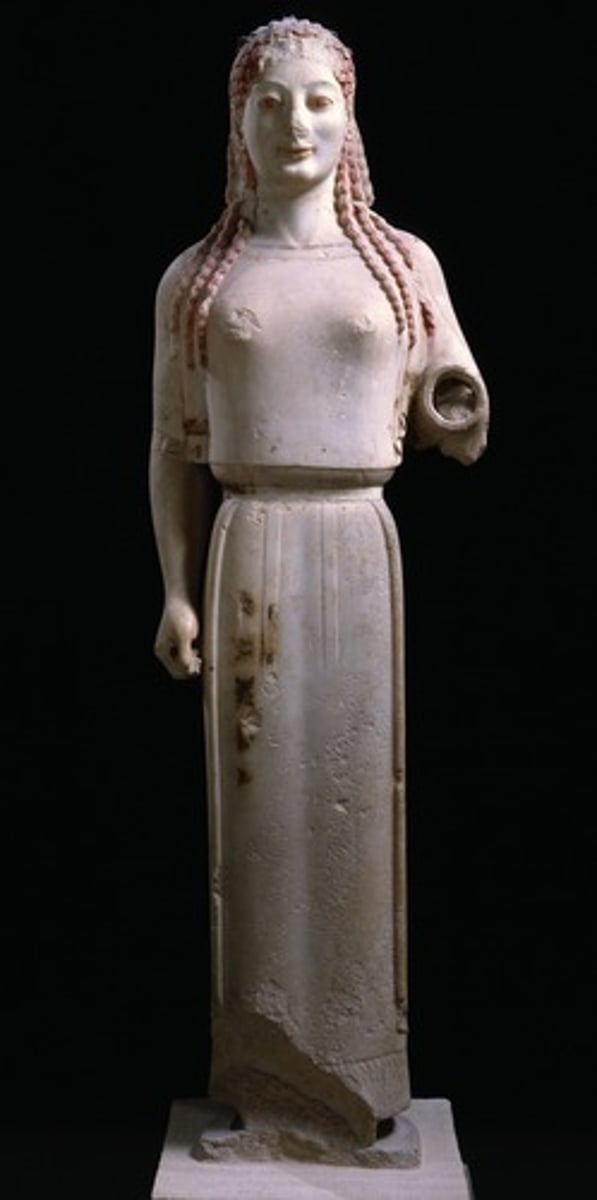
Sarcophagus of the Spouses, terra cotta, etruscan
Form:
-lifesize
-archaic smile, patterned hair
-extending arms
Content:
-husband and wife reclining on a couch dining "dining in banquet for eternity"
-four pieces put together
Function:
-funerary container to hold ashes not the body
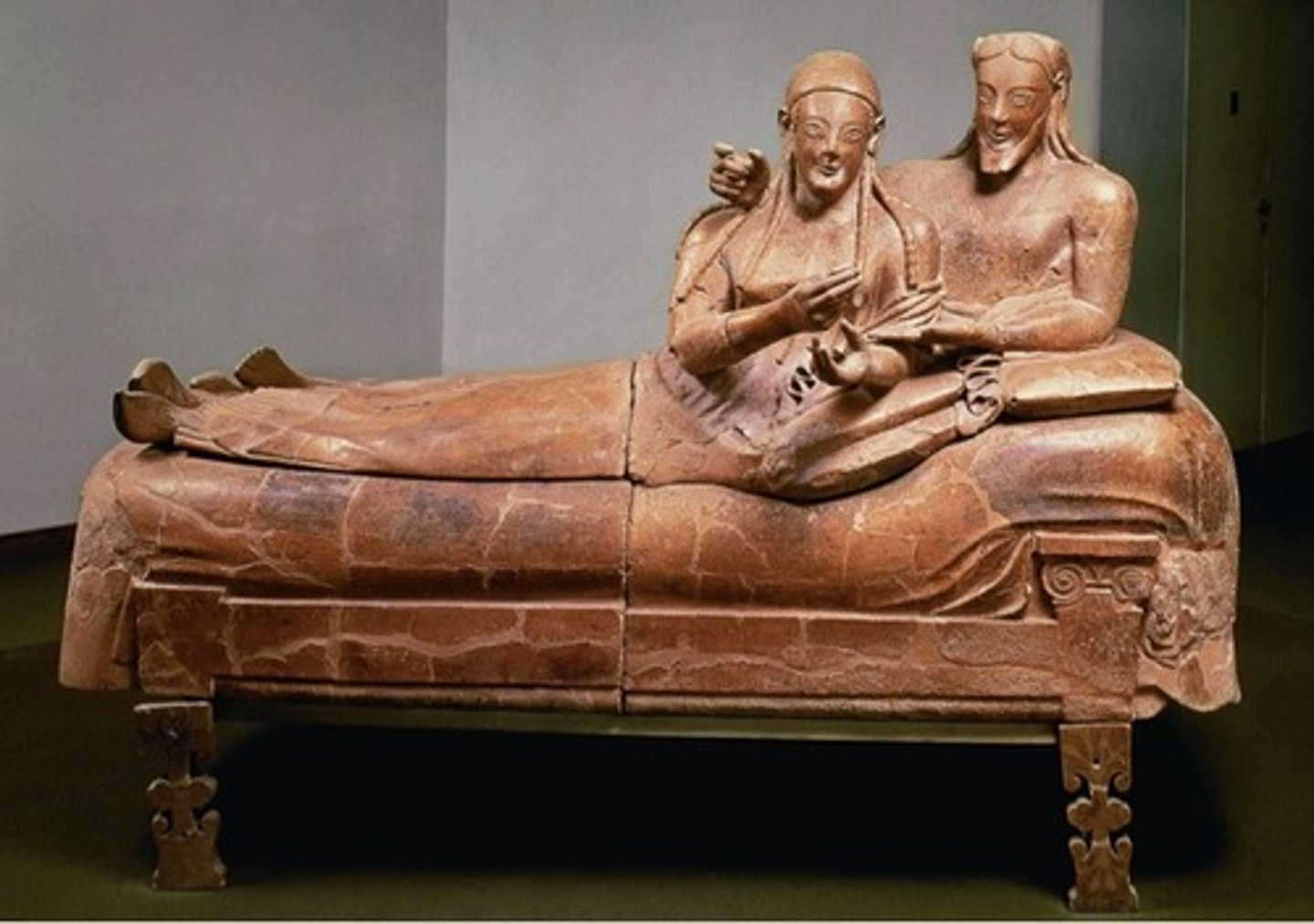
Audience hall, limestone, persian, 520-465 BCE
Form:
-hypostyle hall
-cut sandstone and mud brick
-built in a hillside with big platform
-72 columns (3 portico made of 12 columns)
Content:
- relief on the side pictures Darius and Xeres
-stairs have central relief of king enthroned with attendants
-reliefs
Function;
-used to hold thousands of people (audience hall), king's receptions
- ascend upwards symbolic
Context:
- Persepolis, Iran; Persian influence
-built by Darius and Xeres; destroyed by Alexander the Great
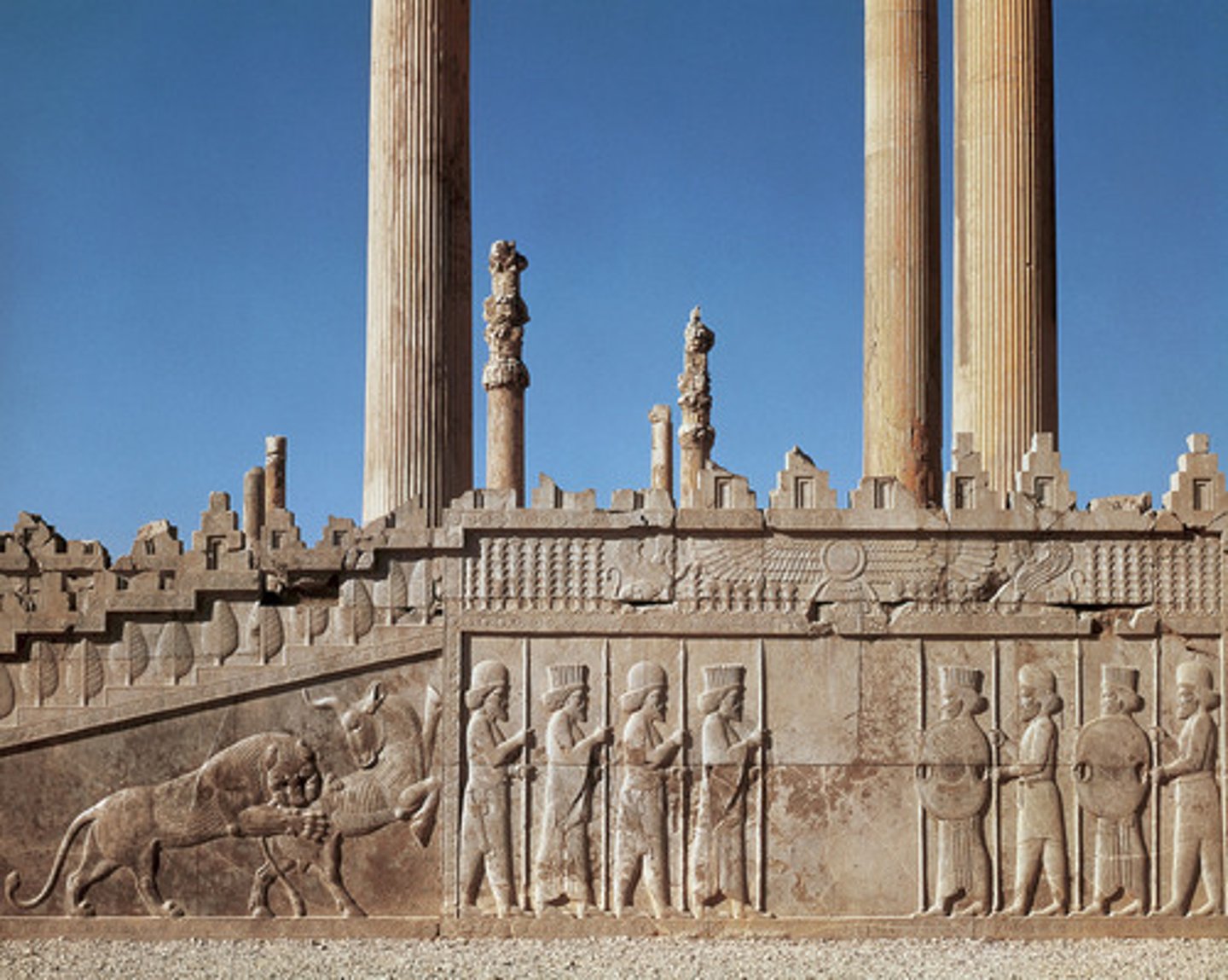
Temple of Minerva, mud brick/tufa, etruscan
Form:
-temple: wood, mud brick, tufa (volcanic rock)
-sculpture: terra cotta
-animated and moving sculpture ()
Content:
-Apollo apart of a narrative of Herakles, acroterion (roof sculpture)
-deep porch, 3 cella (entrance is emphasized)
-archaic Greek smile
Function:
- temple made to be a place to worship the gods and goddesses
-acroterians probably shows a mythic event
Context:
-Veii (near Rome, Italy)
-Imperial Rome
-sculpture made by Vulca
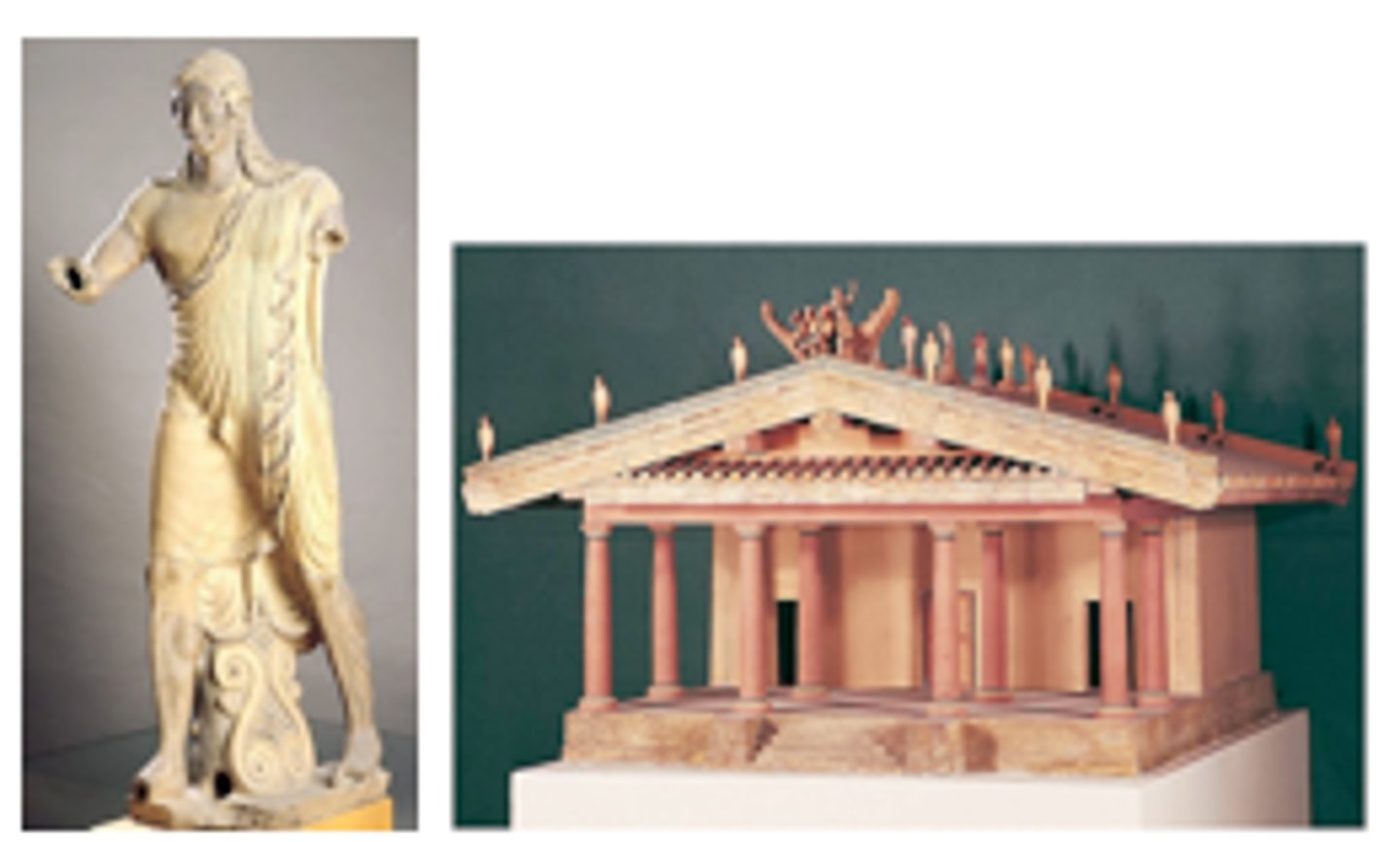
Tomb of the Triclinium, tufa and fresco, etruscan, 480-470 BCE
Form:
-wall paintings
-great detailed piers
-color coding to show genders (not race)
Content:
-pictures people casually dining in triclinium (reclined on couches)
-fully furnished
-lively paintings of people dancing and in motion
Function:
-keep record of domestic life
-holds ashes (crematorium) and any other offerings to the dead
Context:
-Tarquinia, Italy
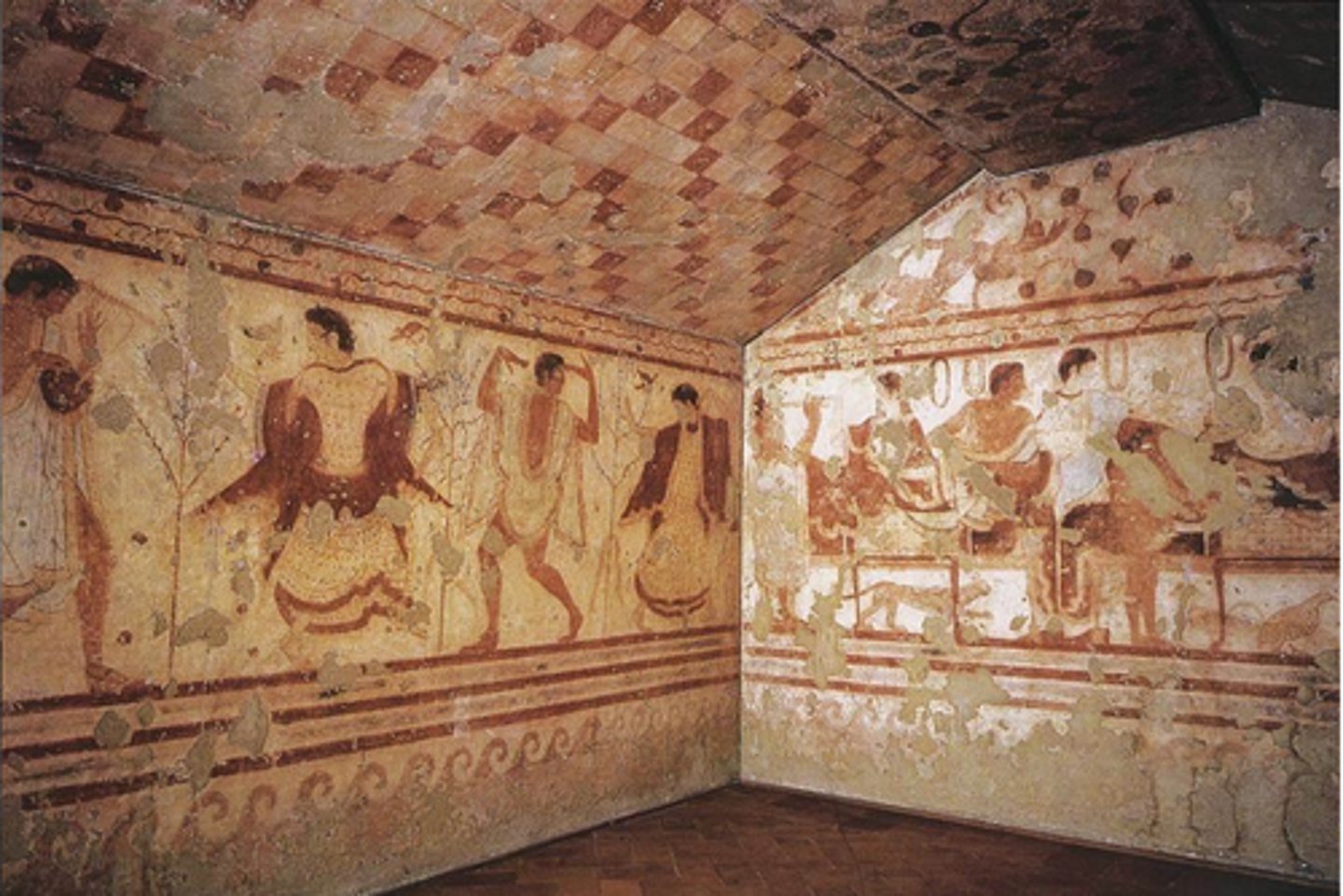
Niobides Krater, clay red figure, classical greek (function: mix water and wine)
Form:
-calyx krater (type of painted pot)
-stiffness in the figures contrast the other relaxed side of the vase
-sense of depth perception
-red figure technique with white highlight
Content:
-one side: mortal woman named Niobe with 12 children would always brag to the goddess Leto that she had more children so Apollo and Artemis (Leto's children) take revenge for their mother by killing all 12 children
-other side: Hercules (identified with club and lions skins) is actually a sculpture (contraposta) and Greek soldiers are offering tribute and prayer to protect them before going into battle
Context
-not signed
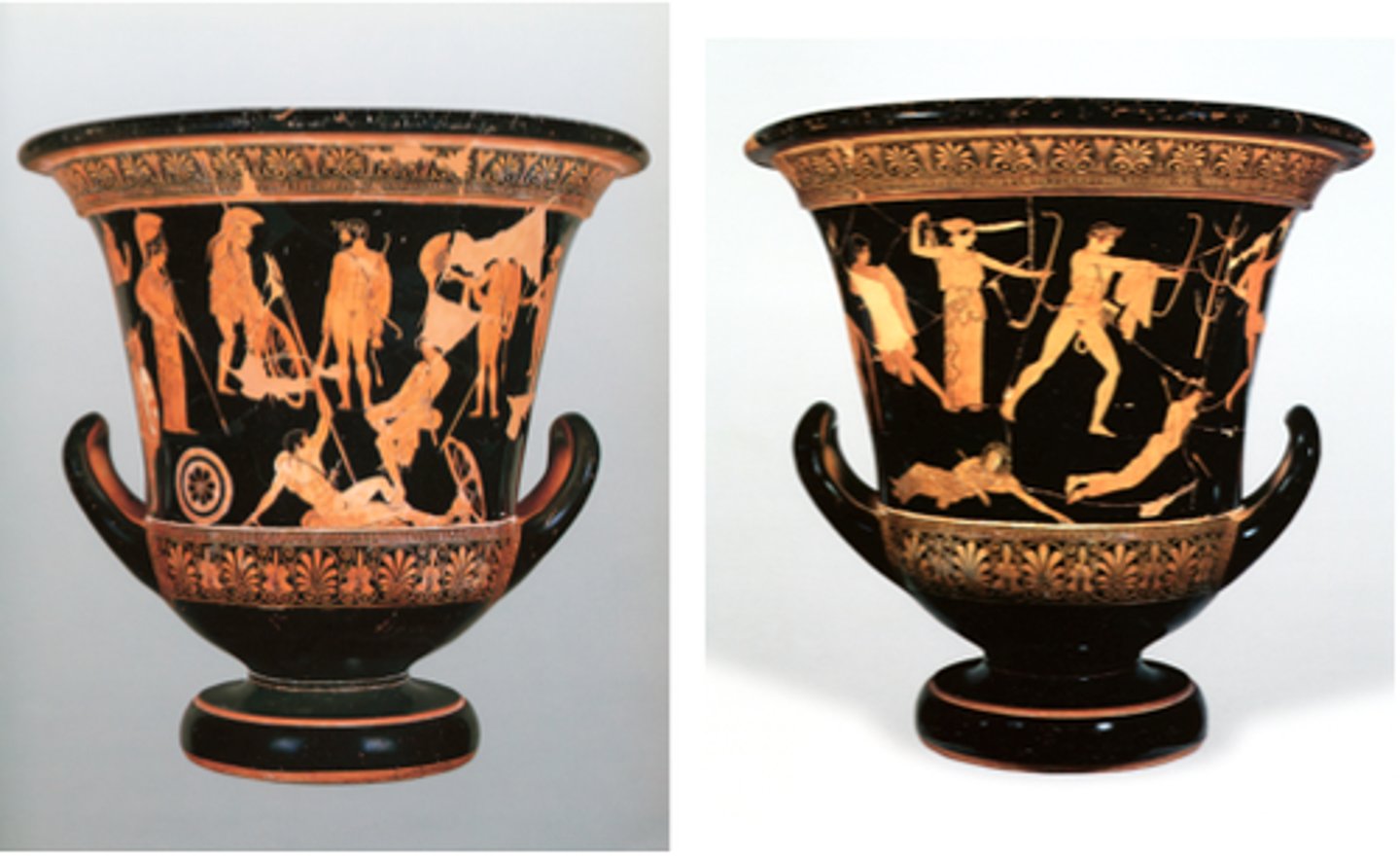
Doryphoros, marble, classical greek, Pompeii, Italy
Form:
-marble (Roman); bronze (Greek)
-contrapposto: shifted weight
-not meant to portray a specific person but rather specific characteristics of a Greek
Function:
-portray the physical perfection of a human figure
Content:
-everyone is imperfect but brings together different body proportions to make physical
-missing its spear
-athlete and warrior
-gazes off in the distance
Context:
-Artist= Polykleitos of Argos
-Roman copy of the Greek original
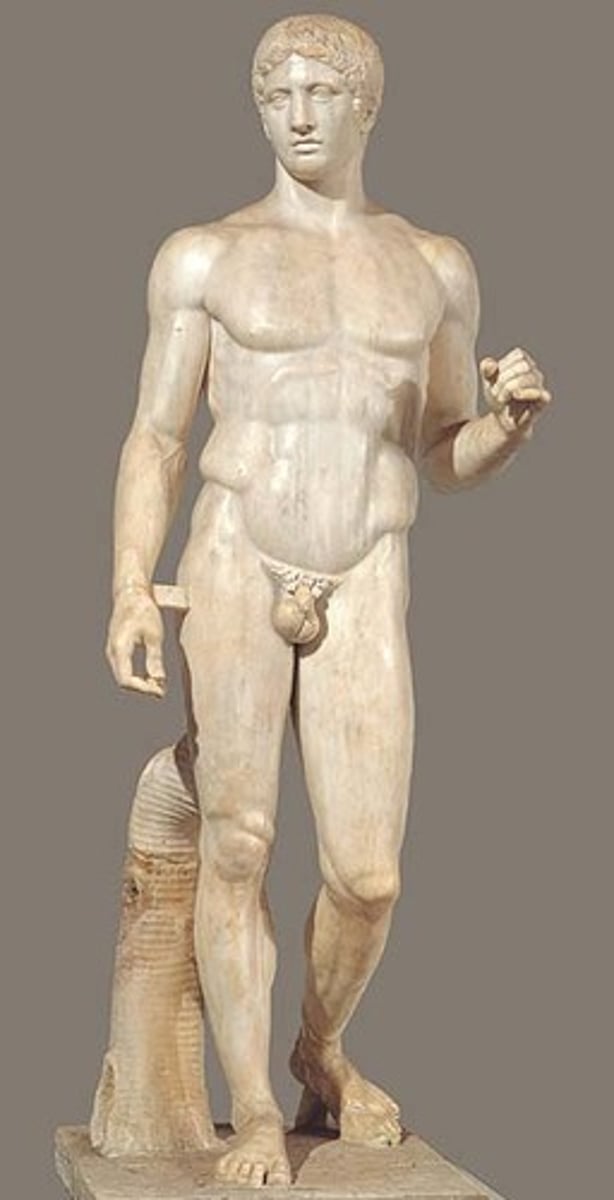
Acropolis
Form:
-marble (wealth)
-winged figure (nike)
-elevated
Content:
-buildings, temples, statues
-Parthenon (constructed under Pericles):
-doric temple
-East Pediment on parthenon: birth of Athena from the head of Zeus (Helios)
-plaque of ergastines: procession held for Athena every 4 years
-Temple of Athena Nike: commemorate Greek victory over the Persians
-Victory Nike adjusting her sandal
Function:
-hold image of goddess Athen (in cella)
-celebrate the female figure
-civic pride (Athena)
-commercial, civic, religious, and social building
Context:
-Athens, Greece
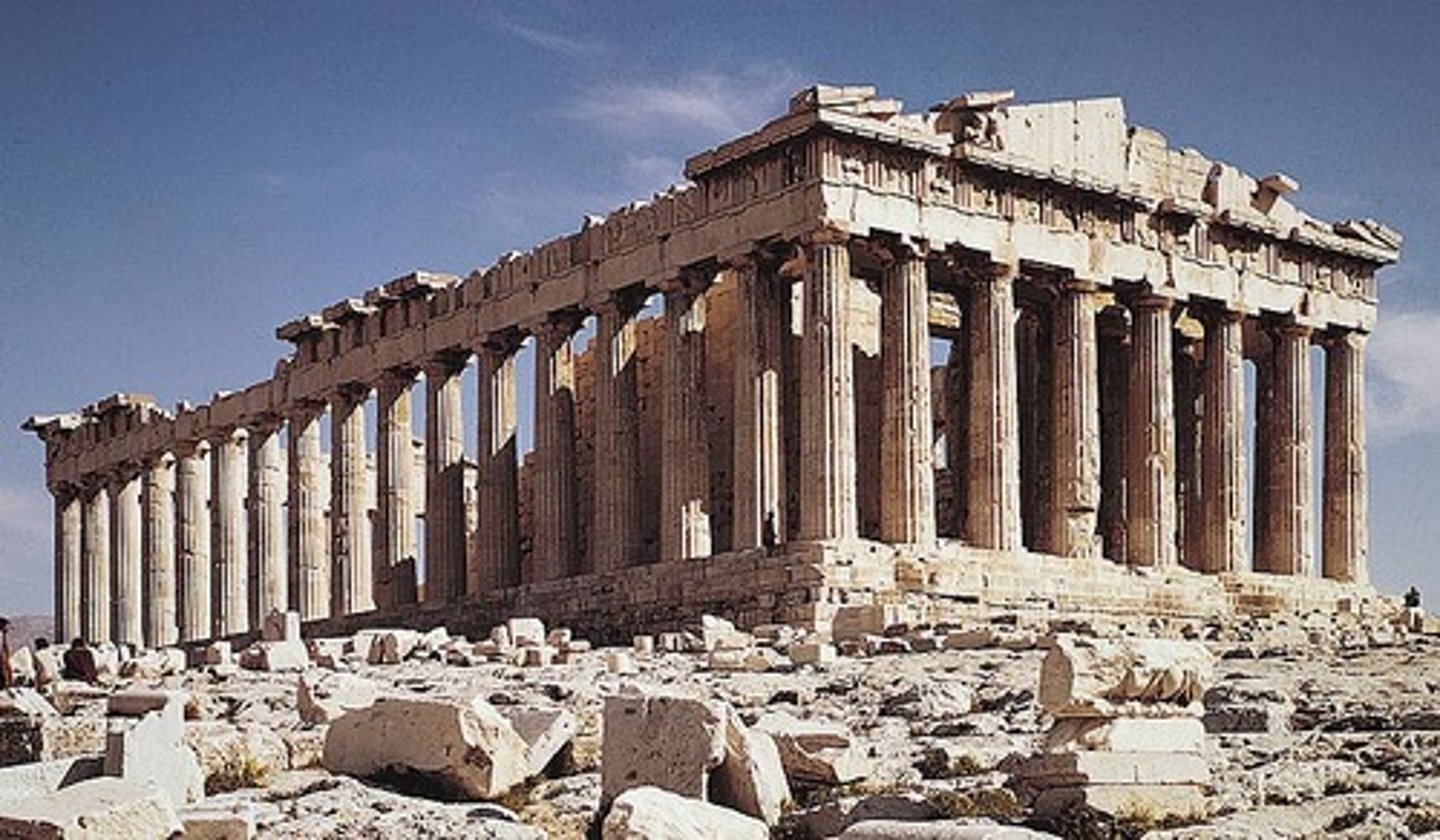
Grave Stele of Hegeso, marble and paint, classical greek
Form:
with paint
-hierarchic scale
-drape accentuates the body
Function:
-funerary object
-put on graves
-commemorates the death of Hegeso
Content:
-genre scene: slave bringing jewelry box to nike figure for her to examine the jewelry
-inscription identifies Hegeso
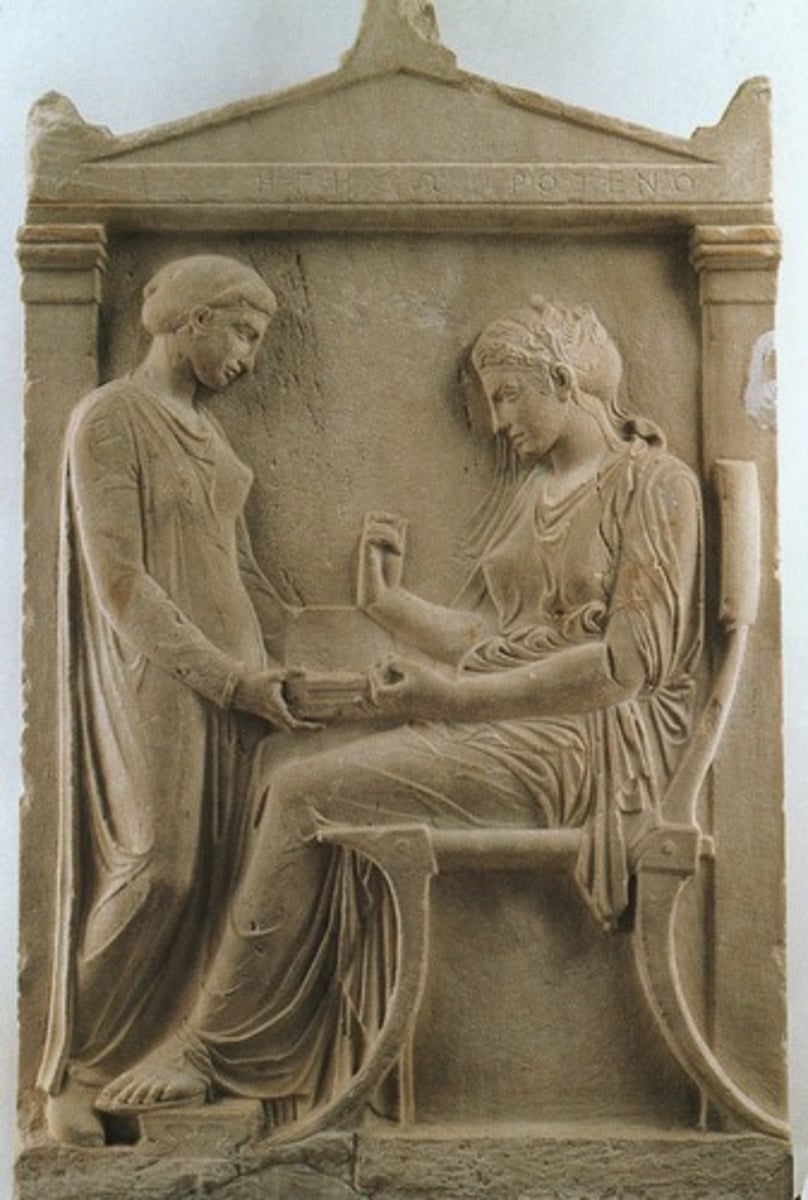
Winged Victory of Samothrace, marble, Hellenistic greek
Form:
-marble
-textures shown
-very dramatic motion, explosive,
-forward movement counteracted by the backward movement of her wings
Content:
-nike lands on front of ship descending from the heavens
-wet drapery look to the sculpture
-twist and contrapposto of the torso
Function:
-war monument
-commemorating a naval victory
-nike is a symbol of victory
Context:
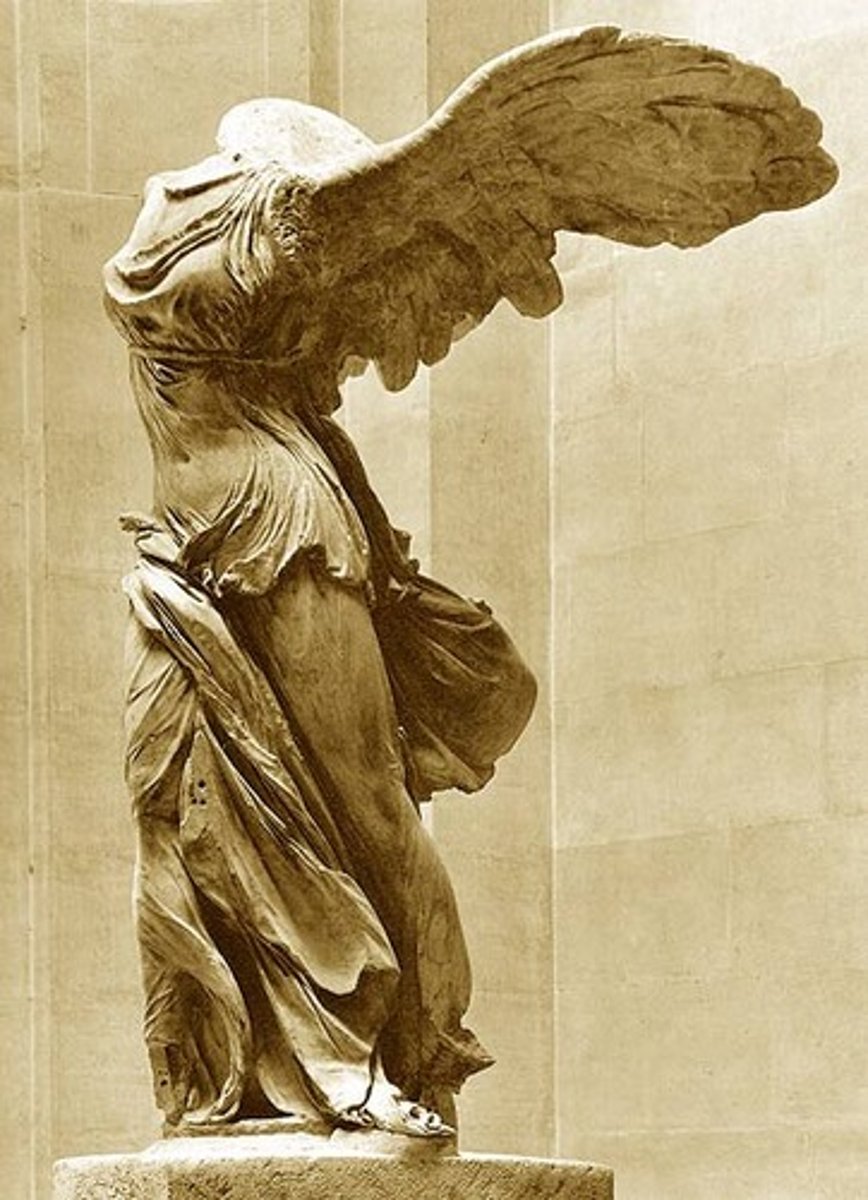
Great Altar of Zeus and Athena, marble, Hellenistic greek
Form:
-marble frieze
-elevated with steep dramatic staircase
-complex forms with big muscles showing violent energy and detail
-ionic columns
Content:
-frieze wrapping around the monument shows gods overpowering the Titans
-Titans vs. Olympians
-"Athena": gigantomachy, battle between the gods and giants (gods win)
Function:
-war monument (Greek defeat of Gauls)
-break architectural boundaries
-altar dedicated to ZeusContext:
- Asia Minor, Turkey
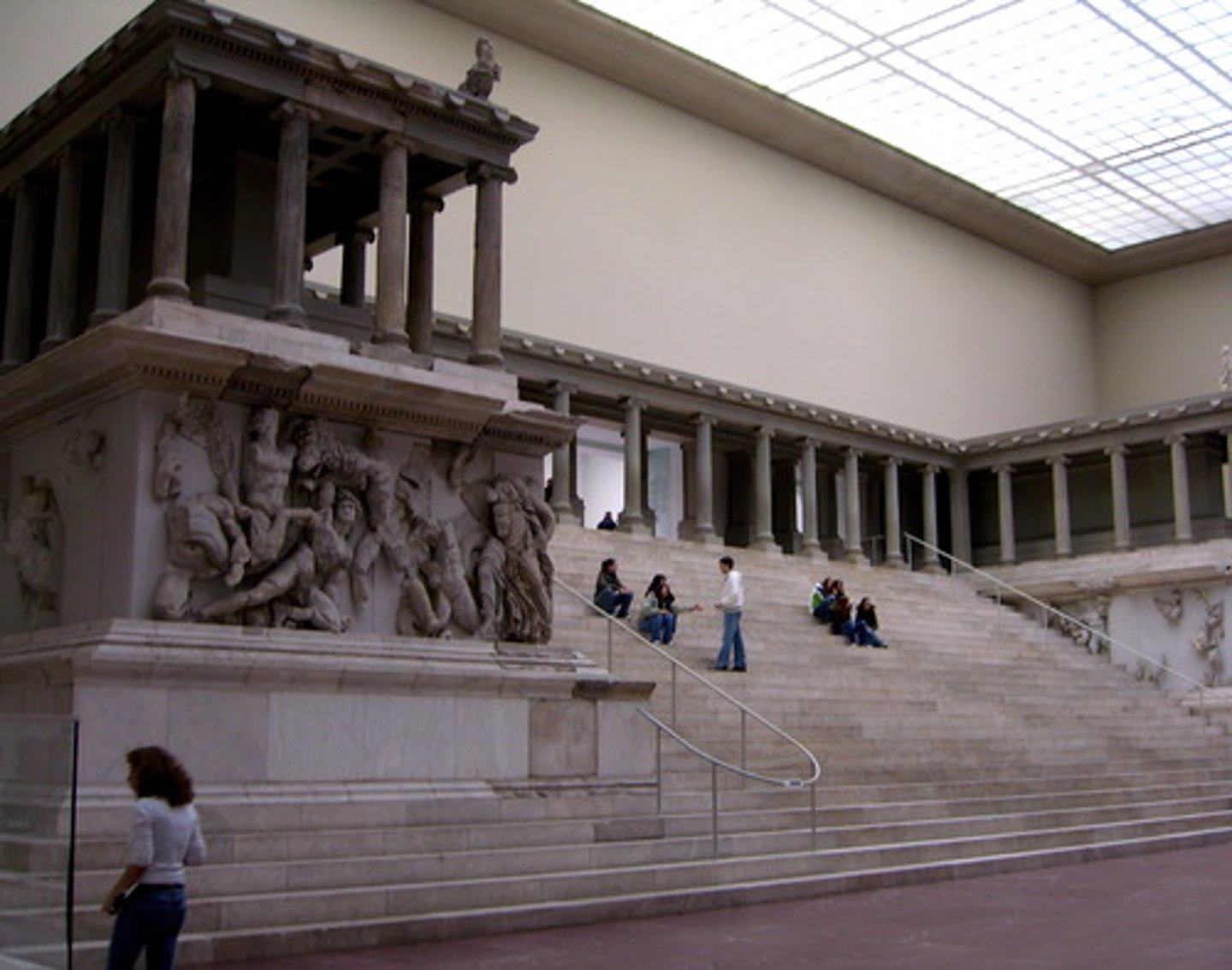
House of the Vettii, cut stone and fresco, imperial rome, 2nd century BCE, Pompeii, Italy
Form:
-axial symmetry
Content:
-atrium (inner courtyard with pool)
-reception area (atrium) has open ceiling
-catch basin to collect rainwater
-peristyle garden in back of house
-living room with frescoes
-frescoes show person's taste and used as conversation pieces for businessmen to discuss
Function;
-represents the wealth of the people who lived there
Context:
-Pompeii, Italy
-wealthy family's home set in the middle of markets
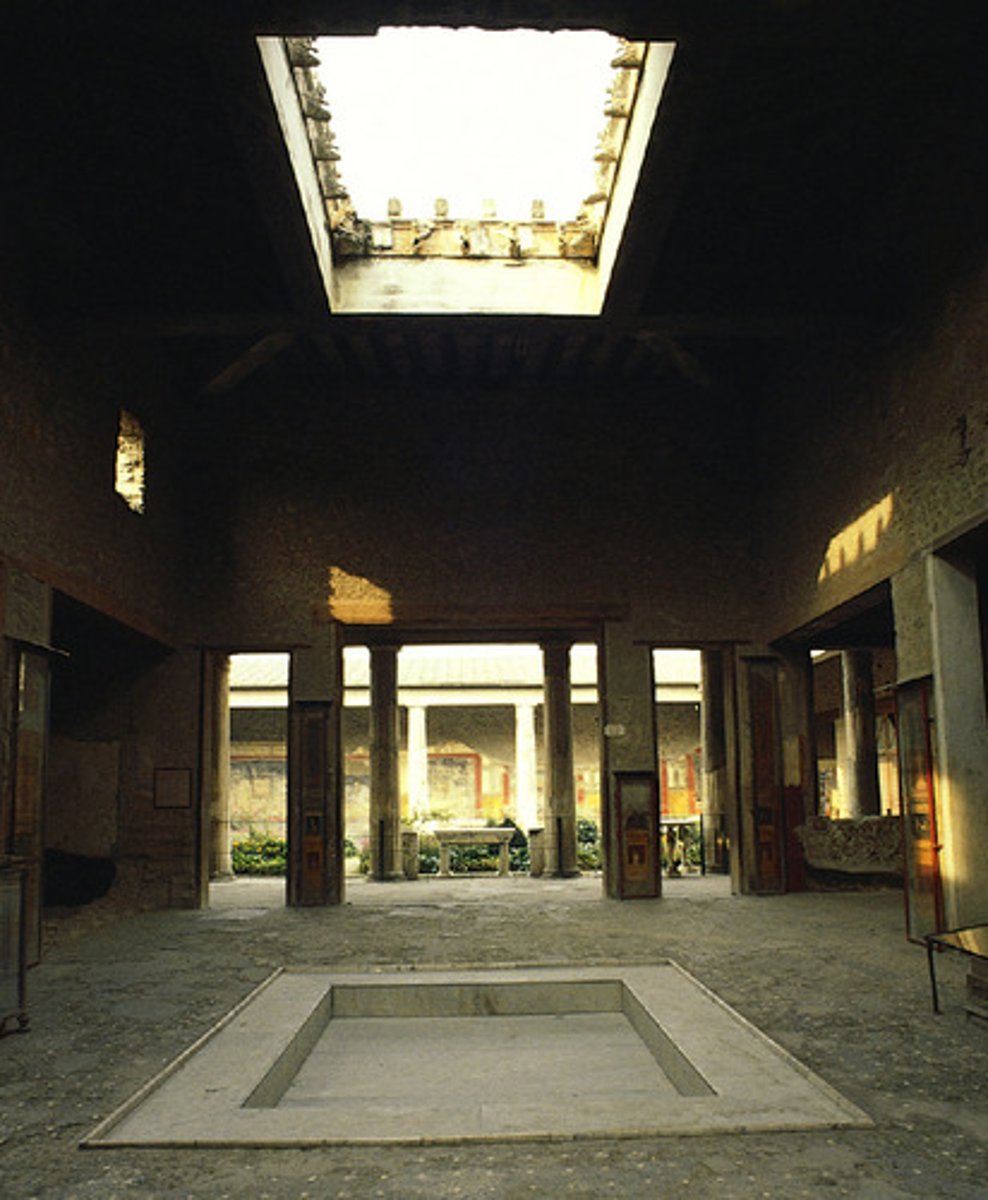
Alexander Mosaic, tessarae moasic, Roman Republic, Pompeii, 100 BCE
Form:
-spacial illusionism
-interweaving of figures
Content:
-Alexander the Great confront Darius III at Battle of Isos
-dead tree signifies the death and sadness
Function:
-floor mosaic showing dramatic representation of a historical event
-last major defeat of the Persians
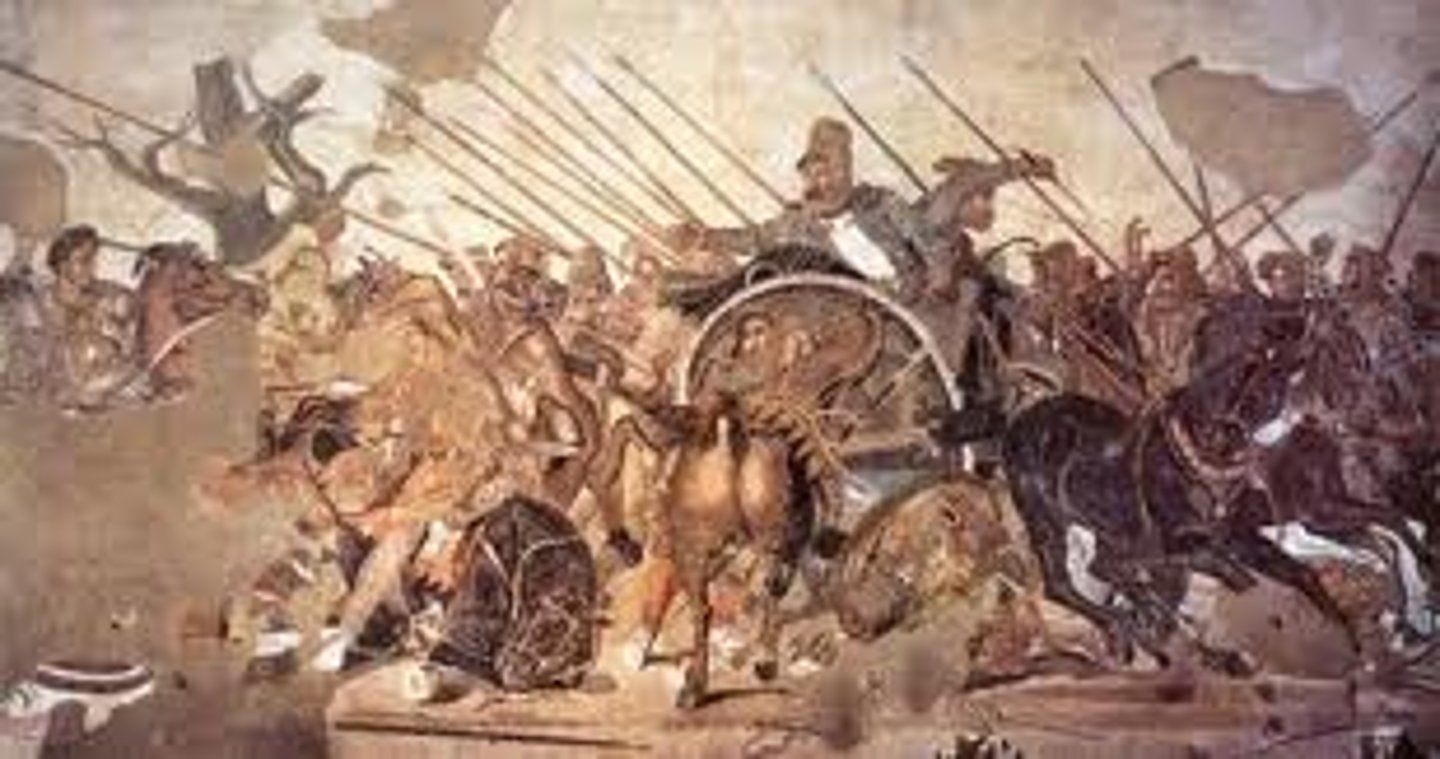
Seated Boxer, bronze, hellenistic greek
Form:
-realistic- shows the exhaustion of a real athlete
Content:
-boxer seated naked with only his boxing gloves
-copper shows blood
-cuts and bruises
Function:
-show a boxer after a fight
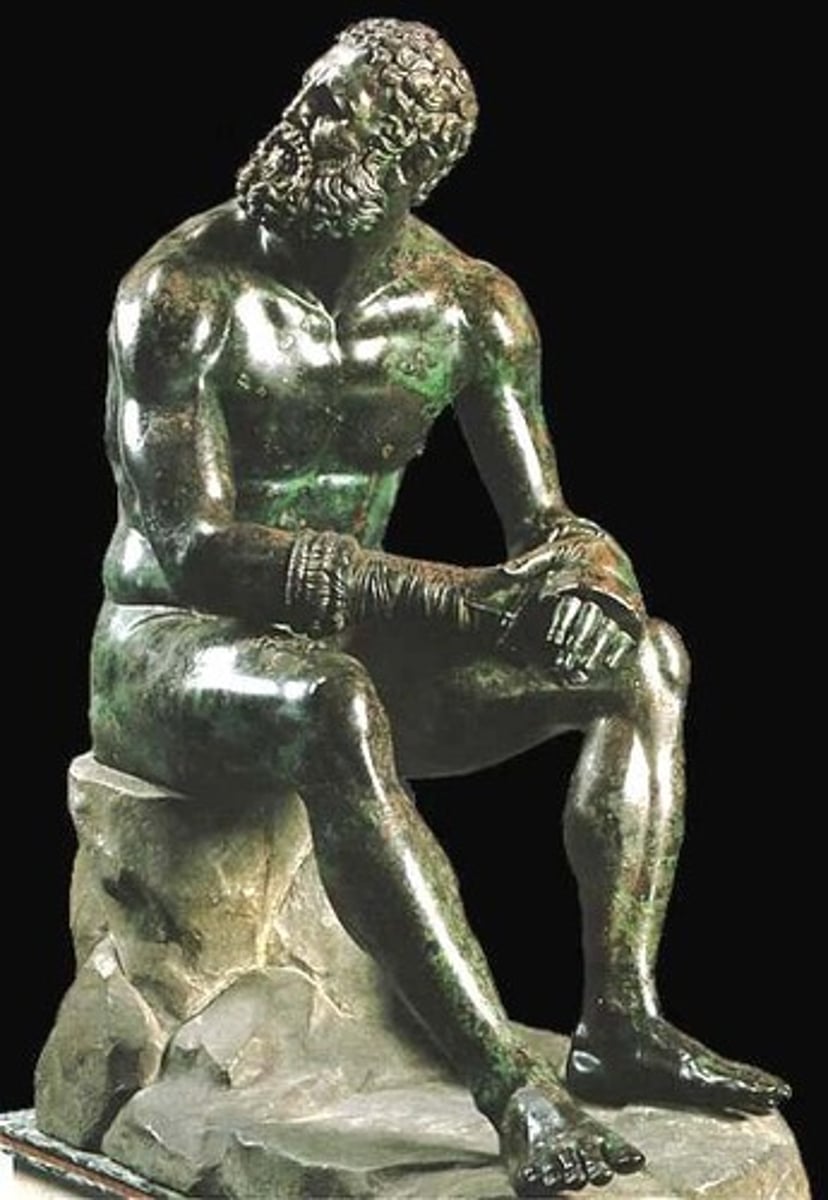
Head of a Roman partician
Form:
-marble
-deep wrinkles, hooked nose, defined cheek bones
Content:
-realistic portrayal of a Roman patrician
-show sense of civic virtue: wisdom, seriousness, public service
Function:
-kept in shrines of Roman houses
-mask of values and virtues of Republican men in Rome
Context:
-Republican Roman 75-50 BCE
-influence of Greek Hellenistic art
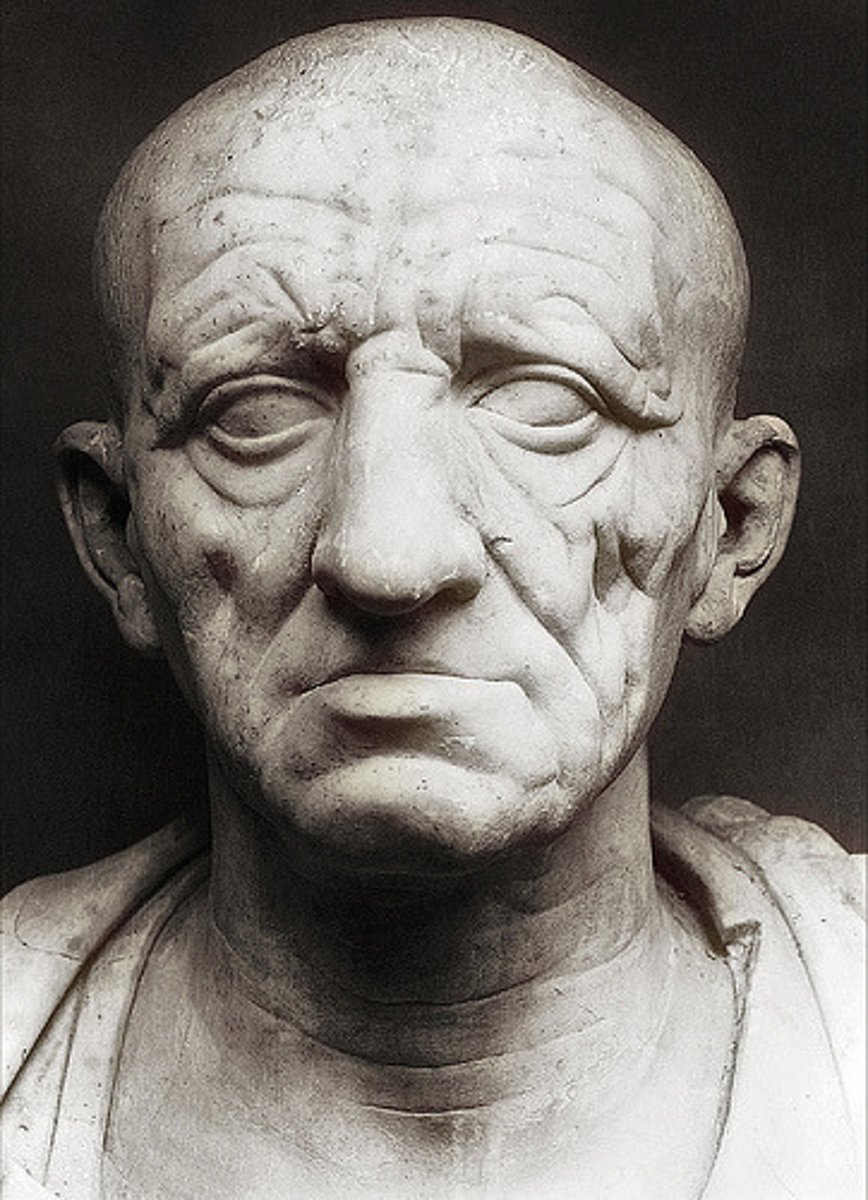
Augustus of Prima Porta
Form:
-marble, over life-size
-elevated to be more god-like
-contrapposto
Content:
-Augustus barefoot
-cupid riding dolphin (shows divinity
-breastplate is about the Pax Romana: the power of empire is due to the military
Function:
-shows Augustus as a god because he thought he was (barefoot and cupid riding dolphin signs of this)
-shows him as civic ruler (judge's robe) and warrior (breastplate)
Context:
-Imperial Rome (early empire) 1st century CE
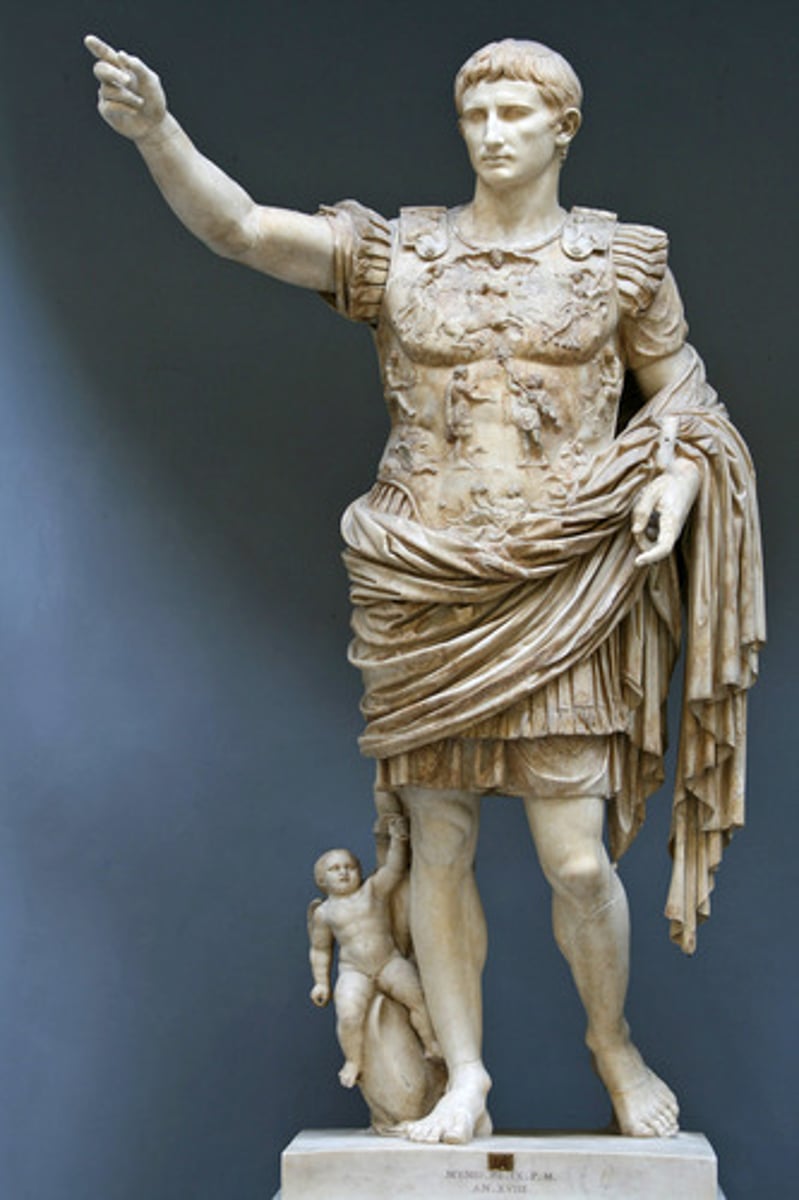
Colosseum, stone and concrete, imperial rome, 72 CE,
-entertainment for the public
-usually dangerous like gladiator fights or animal hunts
Form:
-Corinthian, Doric, and ionic columns
-outside mostly intact
-barrel vaults, thick walls, groin vaults, arches
Content:
-2 theaters
-downward force of arches
-bronze shield on top, 4 layers
-76 entrances
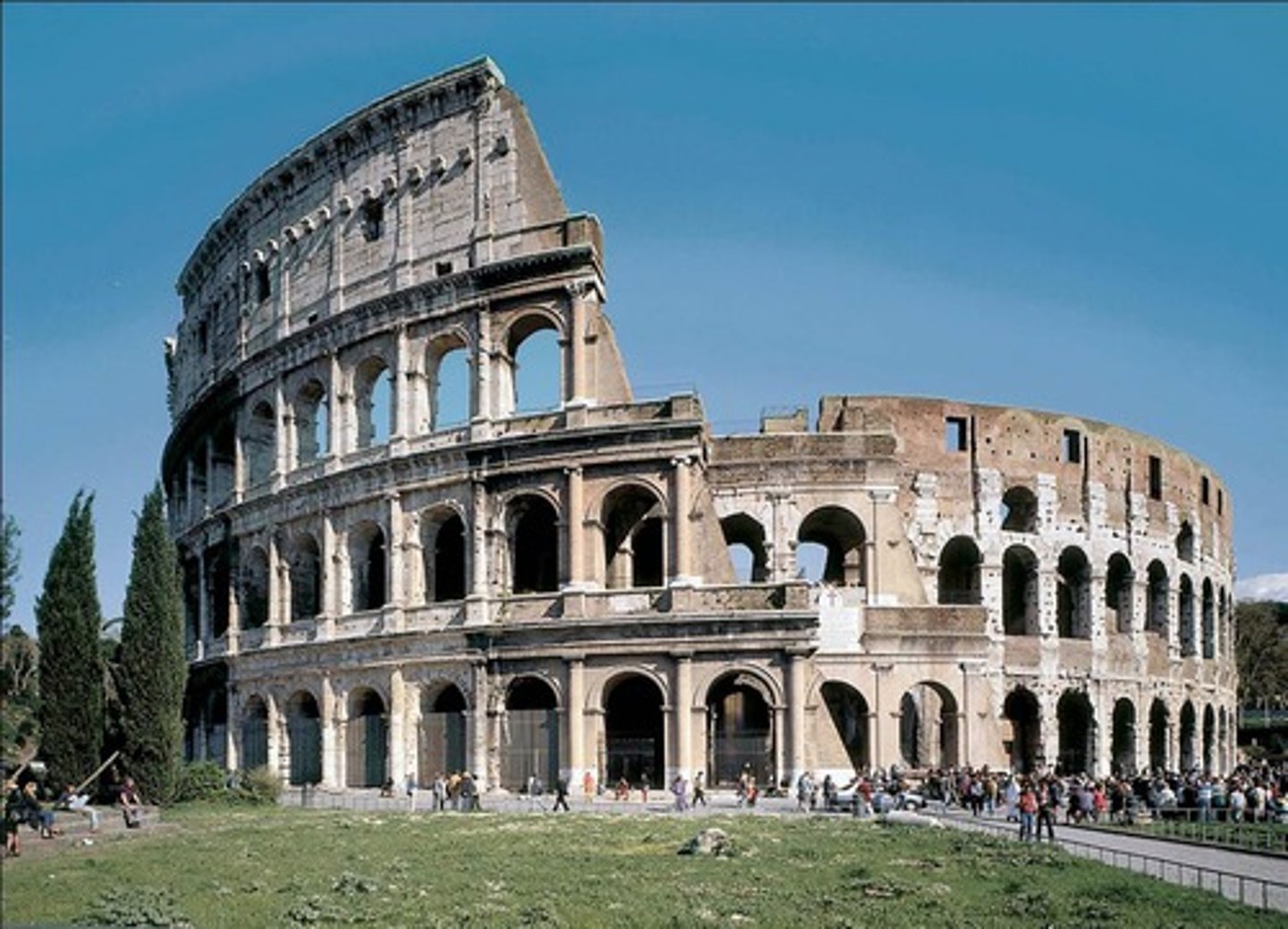
Forum of Trajan and markets, brick and concrete, 106-112 CE, Apollodorus of Damascus, Rome, Italy
Form:
-column: marble, low relief
-scroll-like frieze on column- continuous narrative
-groin vaulting/barrel vaults in market
Content:
-forum: basilica in back with equestrian figure in the center and two libraries
-marble column of trajan: ashes of trajans put in bottom, crowded composition, story of defeat of the Dacians
multilevel mall with 150 shops
Function:
-column: monuments celebrates the victory in the Dacian war

Pantheon, concrete with stone facing, imperial Rome, 118-125 CE, Marcus Agrippa
Form:
-coffers: indentations in the ceilings
-15' thick walls
Content:
-big portico in the front with a rotunda in back that has a dome with an oculus
-sculptures of gods in niches
Function:
-houses all 7 planetary gods
-famous burial space
-coffers create illusion of heaven
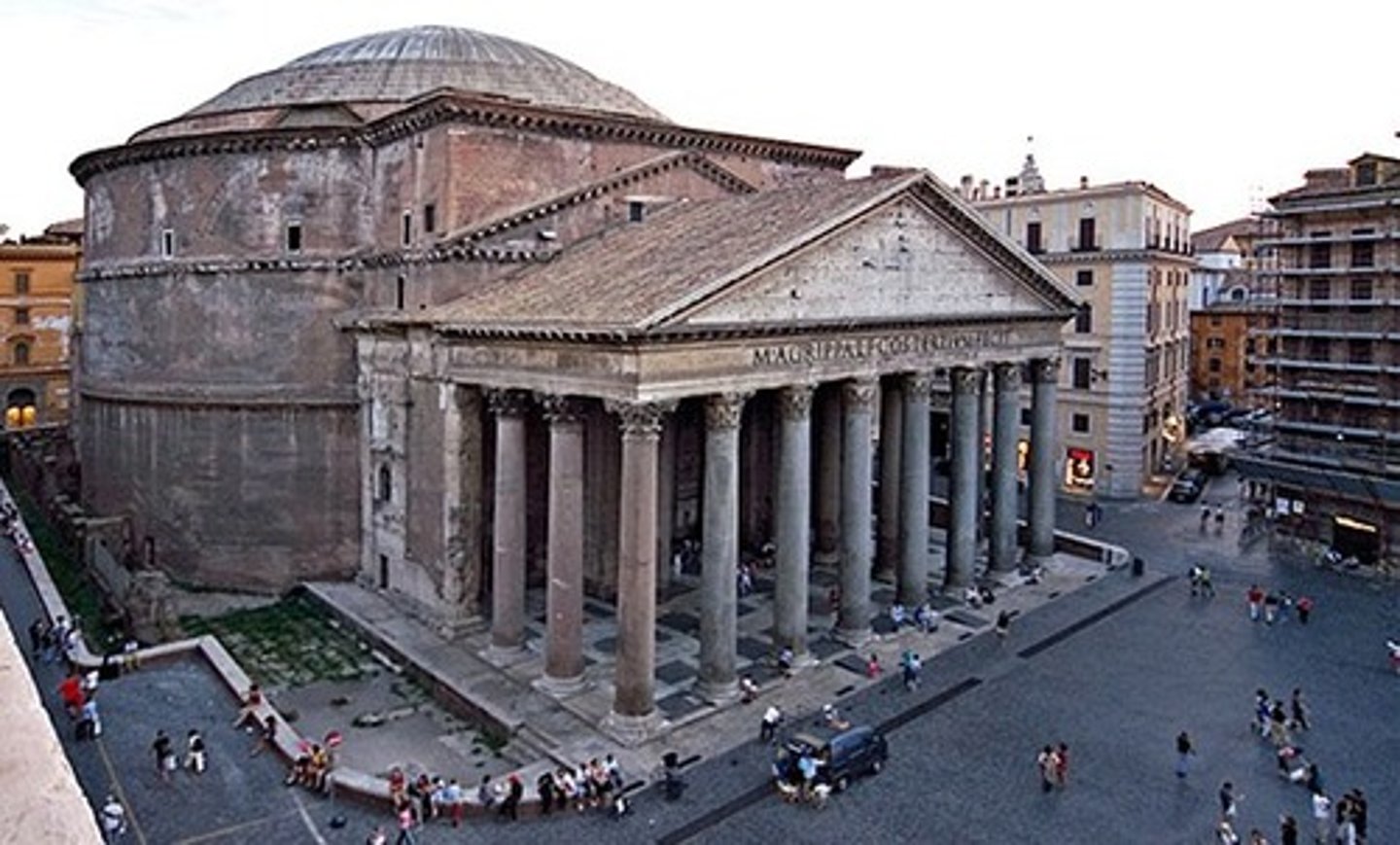
Ludovisi Battle Sacrophagus ( 250 CE, Imperial Roman, Marble)
Form:
-marble
-high relief
Content:
-figures piled on top of each other, crowded surface
-Romans shown as the good guys (ideal/noble)
-Romans trampling over defeated barbarians
- enemies very caricatured with great detail
Function:
-tomb
Context:
-late imperial empire; 250 CE
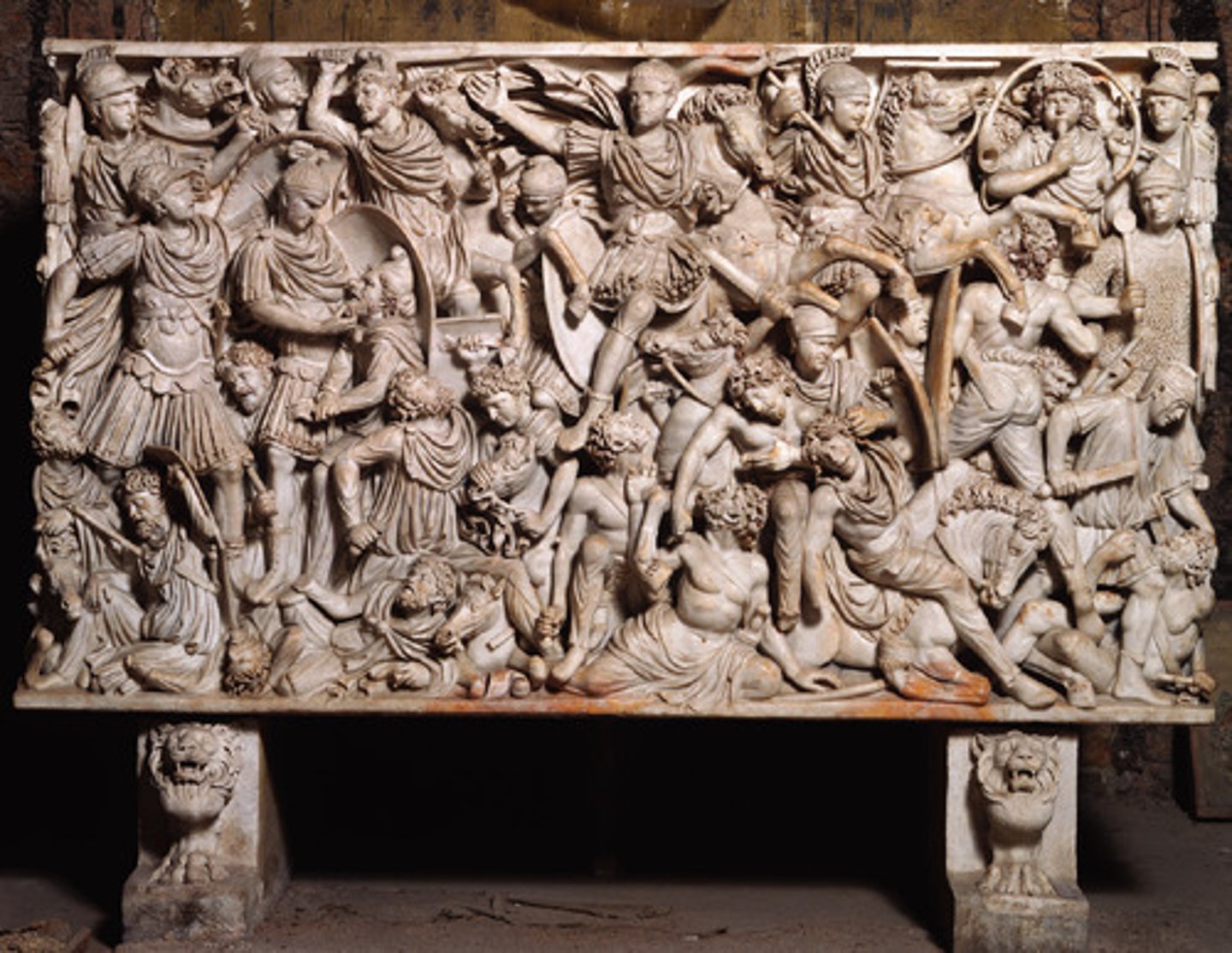
Catacomb of Priscilla (Late antique Europe, 200-400; excavated tufa and fresco; Rome)
Form:
-figures flat and with less detail (roman painting style)
-passageways underneath city of Rome, 100 miles long
-pendentives with picture
Content:
-shelves for bodies; wealthier people: sarcophagus
-scenes of New and old Testament
-curriculum
-Good Shepherd Fresco
-orants figure: arms stretched out
Function:
-tombs of poor and wealthy for 1000s of people
-poor people has body one on top of the other
Context:
- wealthy woman donated land for her family and other Christians to be buried
-3 stories deep
-Greek and Latin
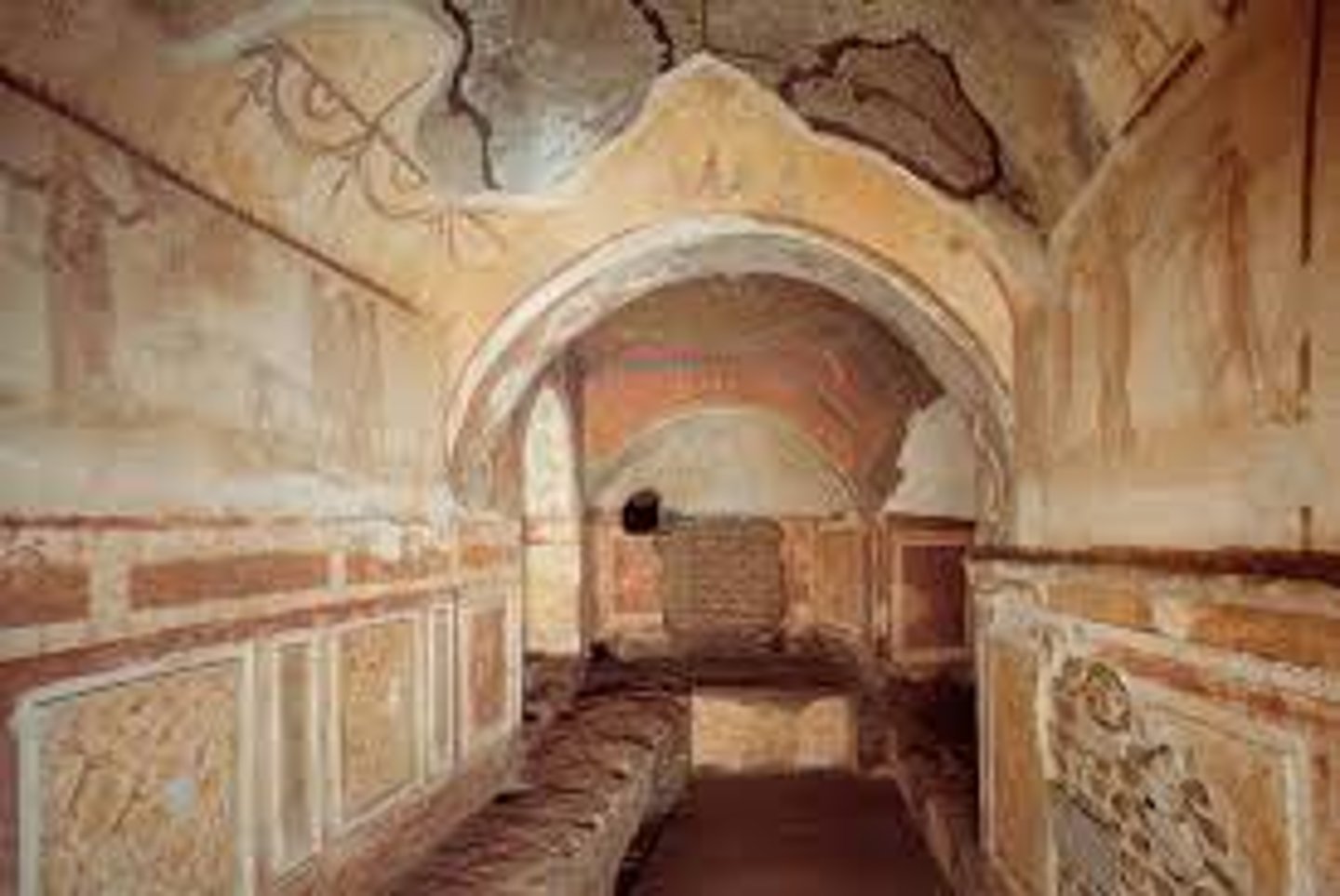
Santa Sabina (Late antique Europe, 422-432; brick, stone, wooden roof; Rome)
Form:
-2 levels: upper (windows), lower (arches/columns)
-spolia (reuse of architectual pieces from other buildings)
Content:
-apse: half dome in back that is decorated
-narthex: lobby
-nave: center aisle
-depiction of crucifix on doors
-3 aisled basilica
-columns from temple of juno in Rome (spolia)
Function:
-basilica- diverse building
-used aisle for law courts
-early Christian church
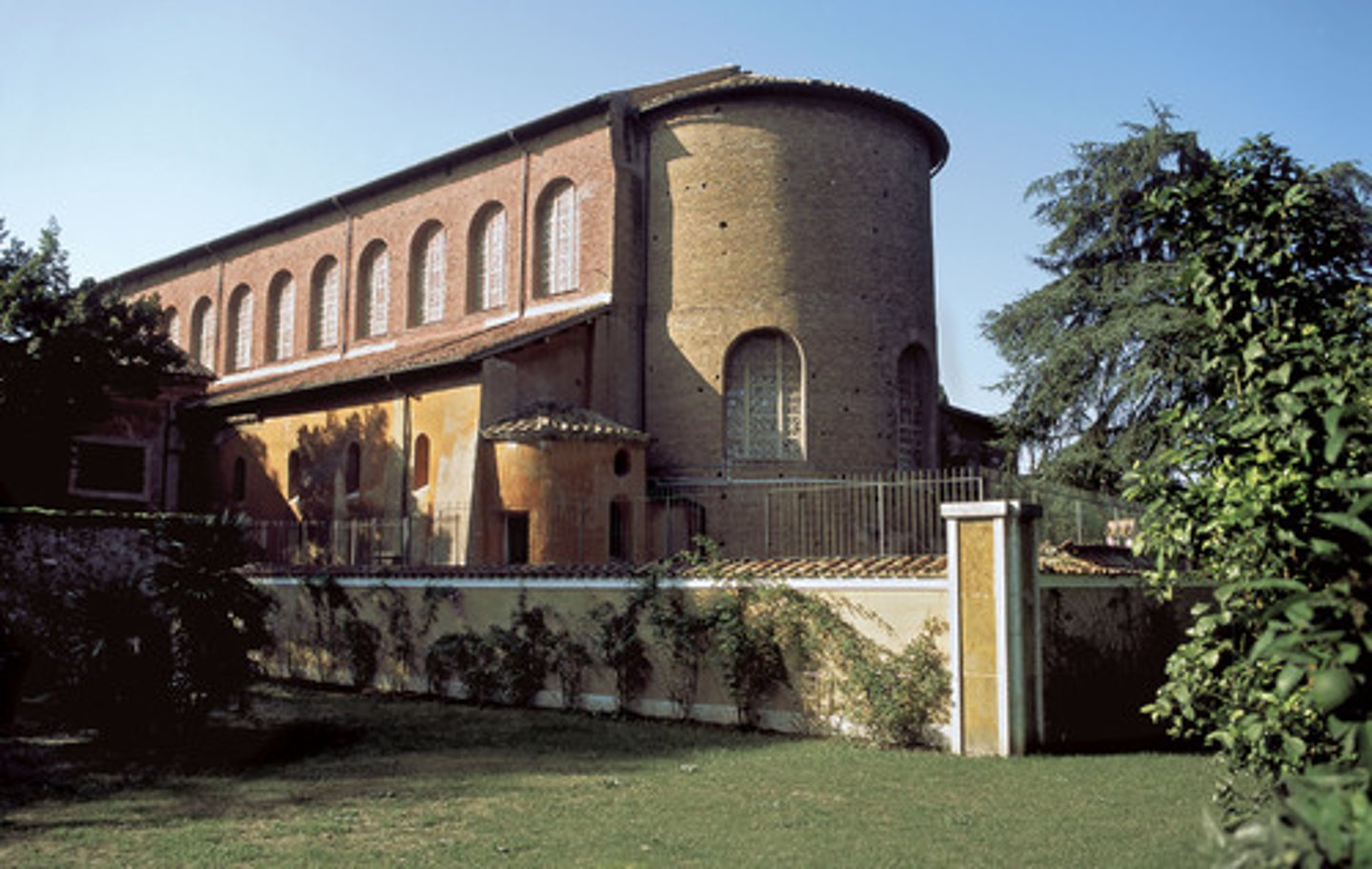
Rebecca and Eliezer at the Well and Jacob Wrestling with the Angel, from Genesis (Early Byzantine Empire 6th century CE, tempera, gold, and silver on purple vellum (animal skin), -illuminated manuscript (pictures with words) )
Form;
-continuous narrative
Content:
- stories from Genesis
-Jacob wrestles an angel at night
-Rebecca quenches thirst of camels and camel driver
-letters black now bc silver oxidized
-Greek writings> Byzantine
Function:
-tell stories
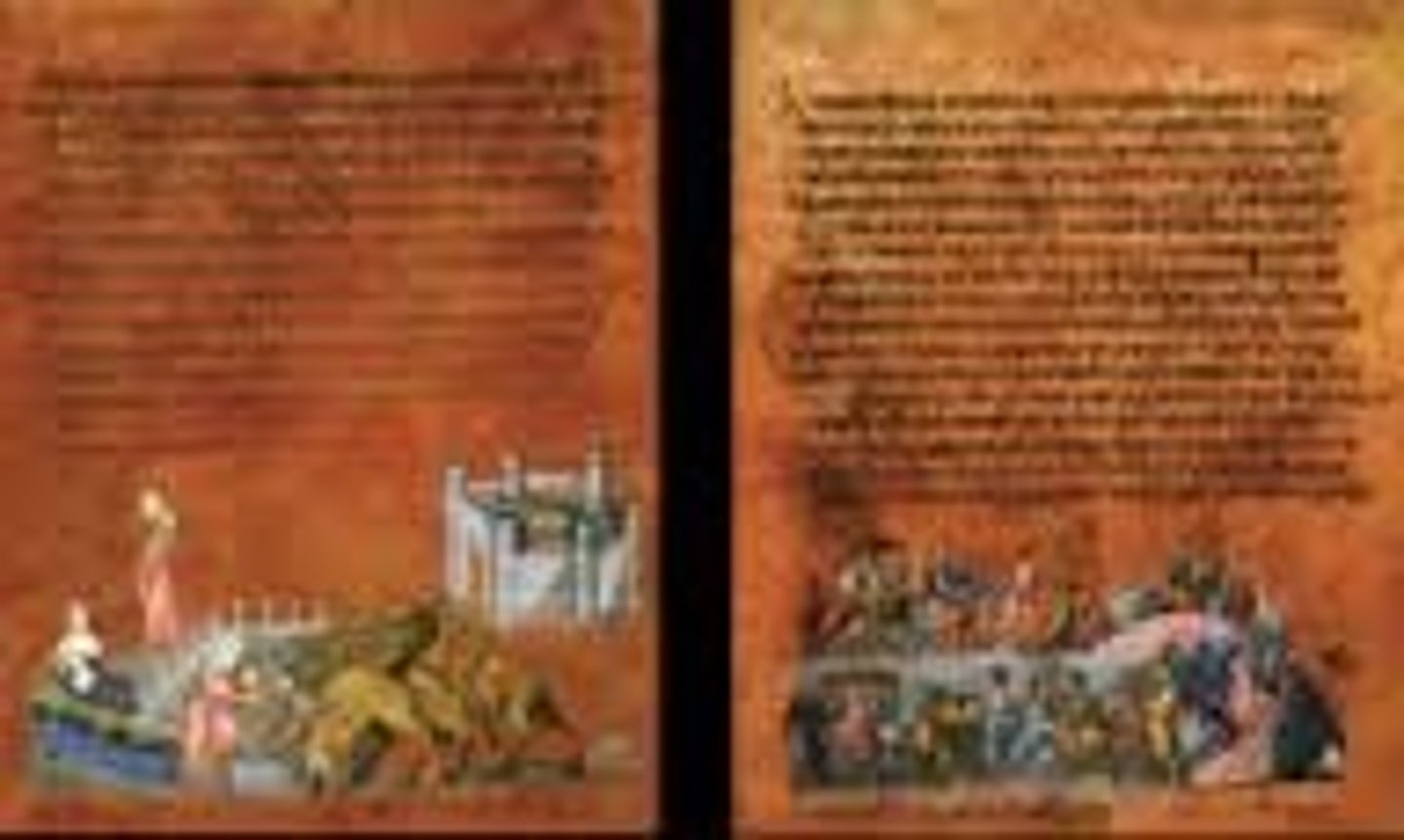
San Vitale (brick, marble, stone veneer, 526-547, Early byzantine, Ravenna Italy), Justinian Panel (547, mosaic from San Vitale), Theodora Panel (Ravenna)
Form:
-all glass covered in gold leaf
-octagonal plan
-groin vaulting
-not longitudinal
Content:
-central domed octagon surrounded by radiating wall niches (exedrae)- attention directed at the center
-big windows
-covered by vaults
-mosaic: clergy on right, military on left, Justinian in the middle
Function:
-holds icons
-basilica
-reestablish Orthodox Christianity
Context:
-Julianus Argentarius financed this building
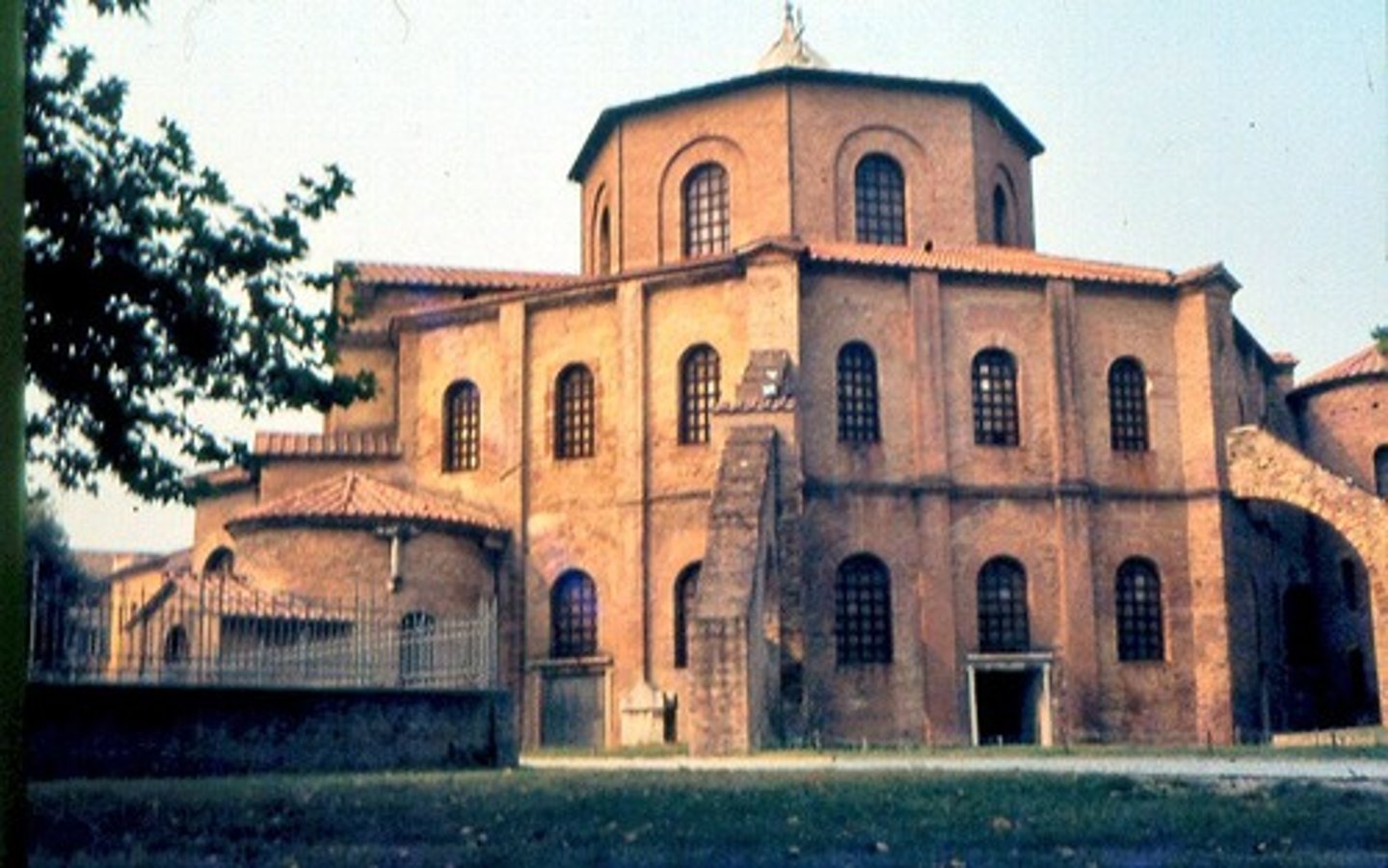
Hagia Sophia (brick and stone elements with stone and mosaic veneer, 532-537, Constantinople, Anthemius of Trallus and Isidorus of Miletus),
Form:
-ionic columns
-centralized dome supported by penditives
-buttress supports
-pendentives: triangular curving vault section
-squinches- quarter domes
Content:
- Byzantine architecture
-attention to detail
-mystical building
-altar at the end of nave (center aisle)
-minarets
Function:
-originally a basilica (church)
-converted to mosque- now has minarets
Context:
-Justinian's reign
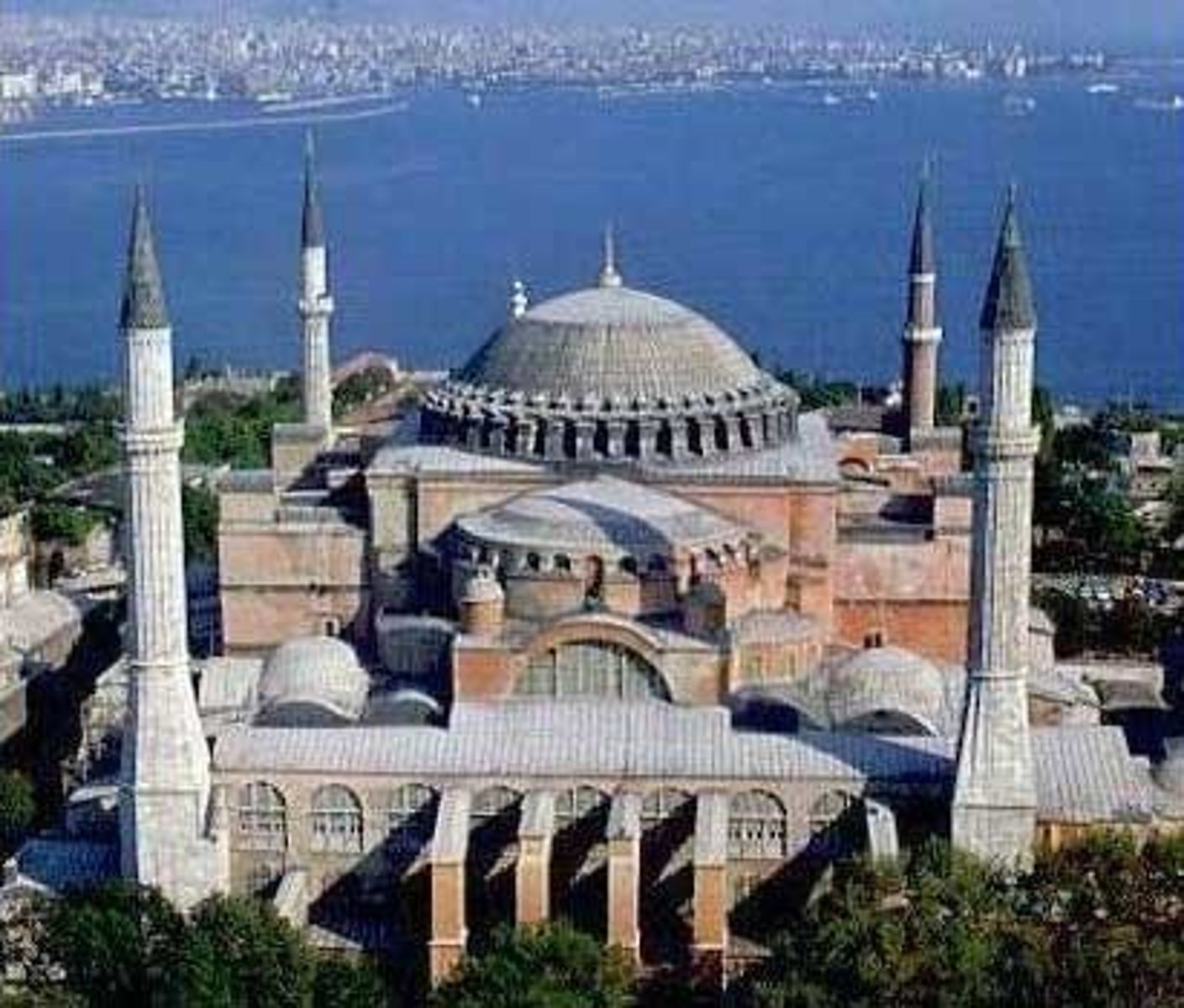
Merovingian looped fibulae ( silver gilt worked in filigree with semiprecious stones, early medieval Europe, mid - 6th century)
Form:
-interlacing (zoomorphic)
-bowed
Content:
-animals (fish represents Christ and eagle represents St. John)
Function:
-clip for holding fabric
-clasp that hold fabric to the shoulder
Context:
-Frankish kingdom
-found in tomb of rich woman
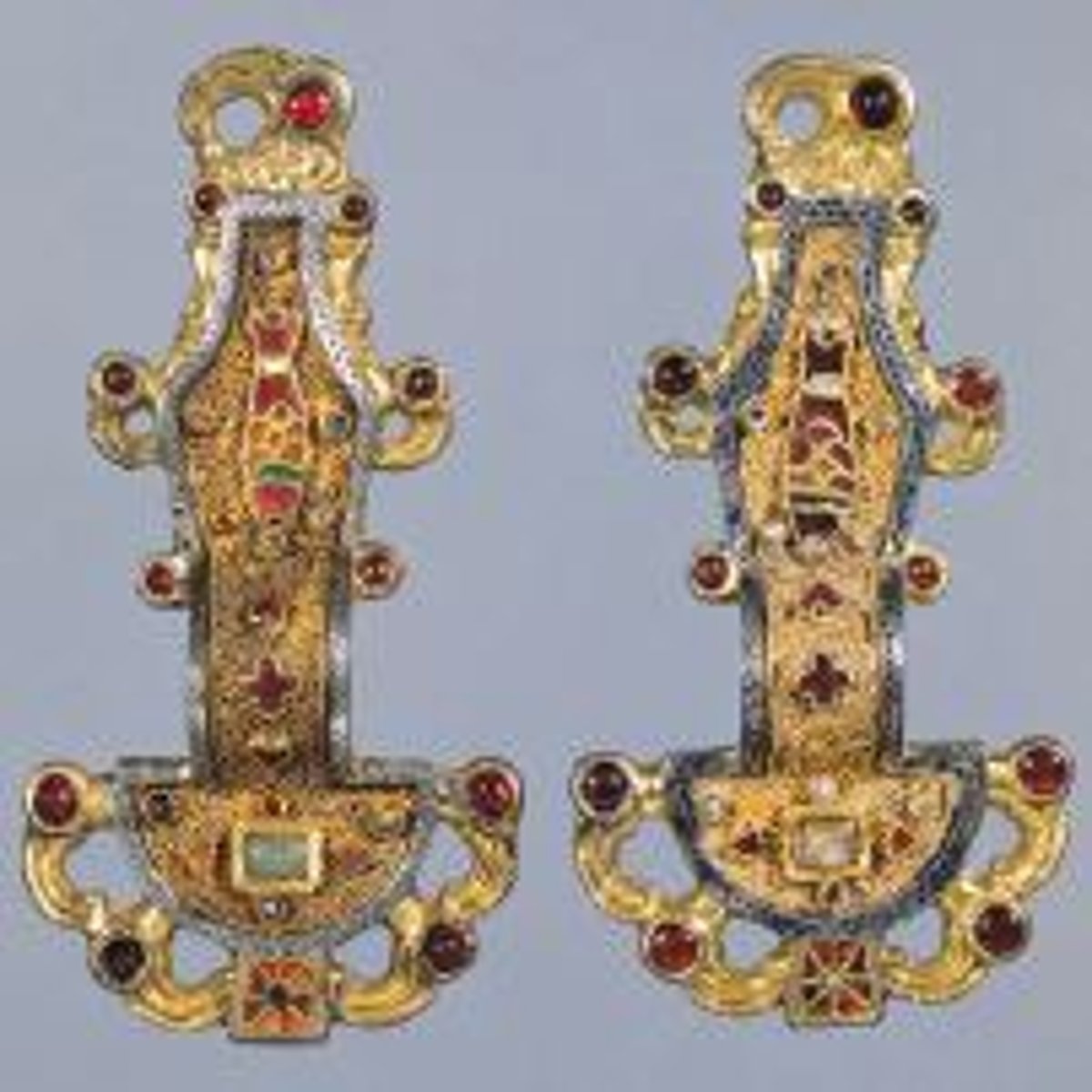
Virgin (Theotokos) and Child between Saints Theodore and George (encaustic (wax base paint) on wood, 6th-7th century, Early Byzantine)
Form:
-spacial recession but compressed space
Content:
-angels looking towards heaven
-Mary looking over viewers while the warrior saints look directly at viewer
-light falling on Virgin
-depicts Mary and Jesus in a different realm than others
Function:
-portray Mary and Christ protected by saints and hand of God
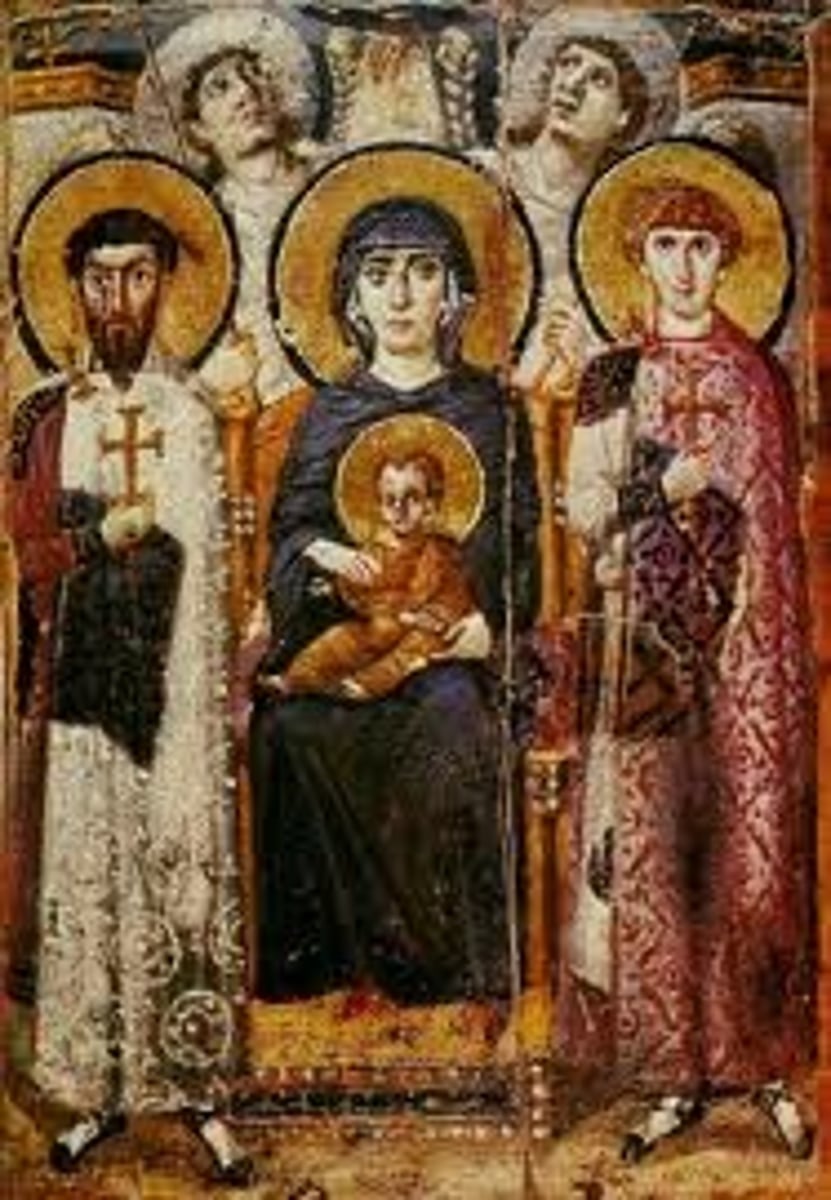
Lindisfarne Gospels (illuminated manuscript; ink, pigments, and gold on vellum, 700, early medieval Europe)
Content:
-cross carpet page: cross forms out of chaos, creates illusion of 3D in which viewer can lose themselves in contemplation
-portrait page (luke): holds quill/looks prepared to write, gold halo (divinity), ox above his head, robe with purple and streaks of red
-incipit page (Luke): it "begins", animal life, spiral forms, swirling vortexes
Function:
-earliest known translation of the Bible
Context:
-created by monks
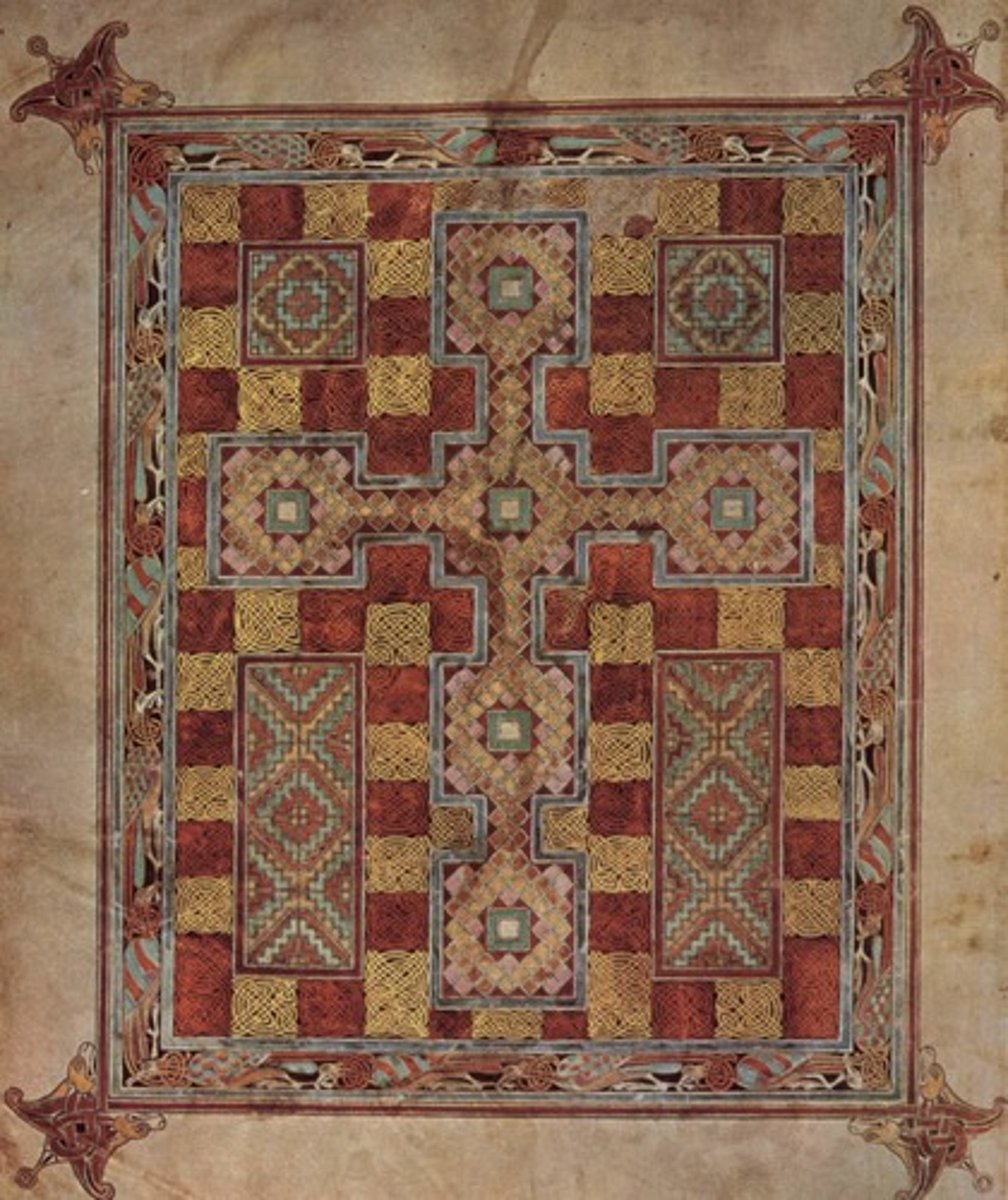
56. Great Mosque(Stone Masonry, Cordoba, Spain- Umayyad 785-786 CE)
Form:
- hypostyle mosque
-spolia (using roman and Christian pieces from old church it used to be
-vossoir: wet stone that holds arches up
-grid vaulting
-culturally diverse
Content:
-horseshoe arches with vaults above
-mihrab- niche is Qibla wall (mostly decorated in geometry and text)
-wooden cieling
-mosaics everywhere- byzantine artists from Constantinople
-Qibla Wall- direction of where Muslims have to pray in order to pray towards Mecca
-Kufic calligraphy
-856 columns
Function:
-1st: Roman temple (Janus)
-2nd: Chirstian church
-3rd- mosque
-now: cathedral
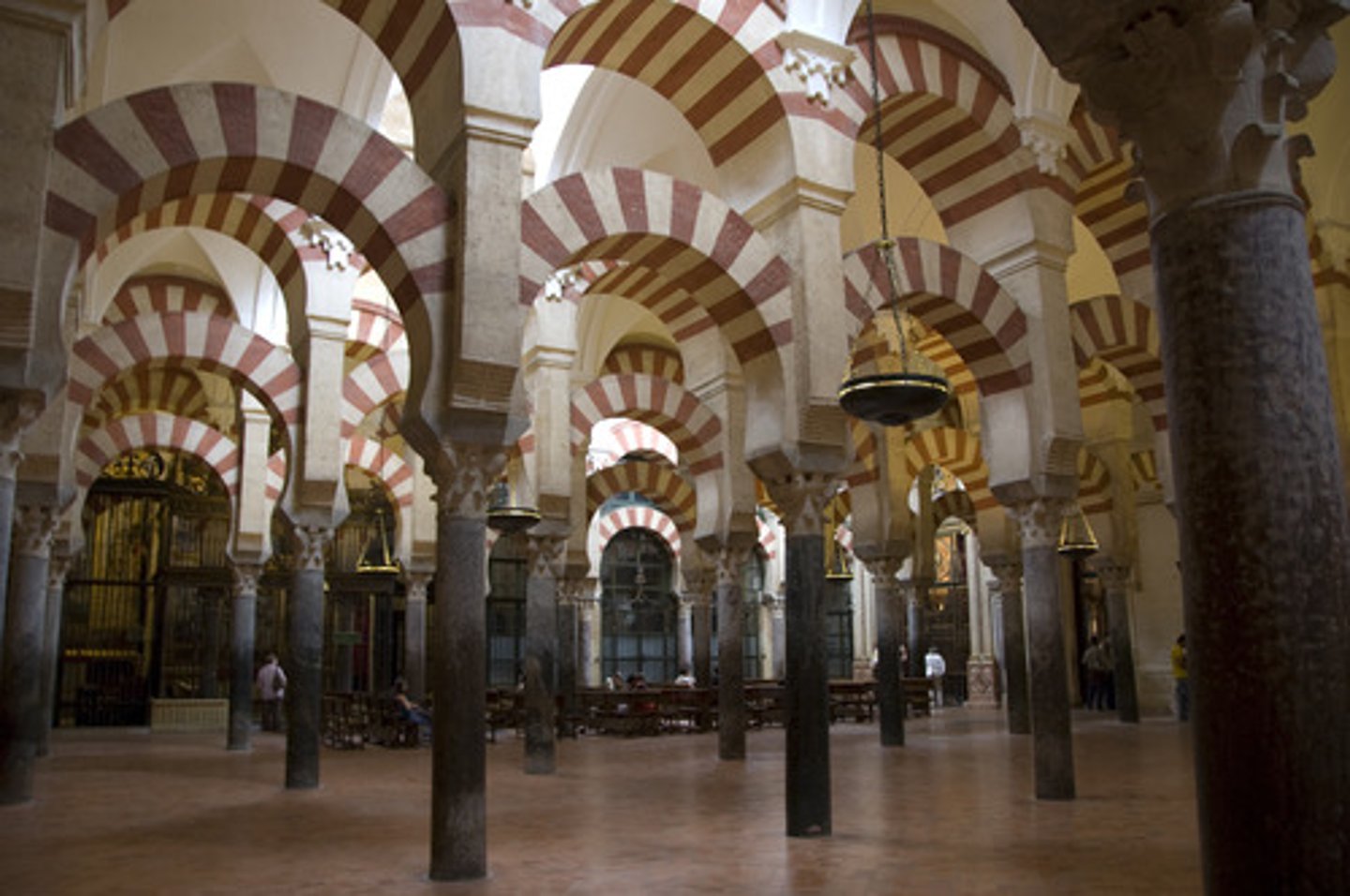
Pyxis of al-Mughira (968, Ummayad, ivory), function:
-luxury cosmetic holder: text on top/decorated richly
-coming of age present from caliph to his younger son
Form:
-carvings of text and pictures
-text used as a decoration
Content:
-roaring lions
-4 8-lobed medallions showing pleasure activities
-human and animal figures
-geometrical and vegetal motifs
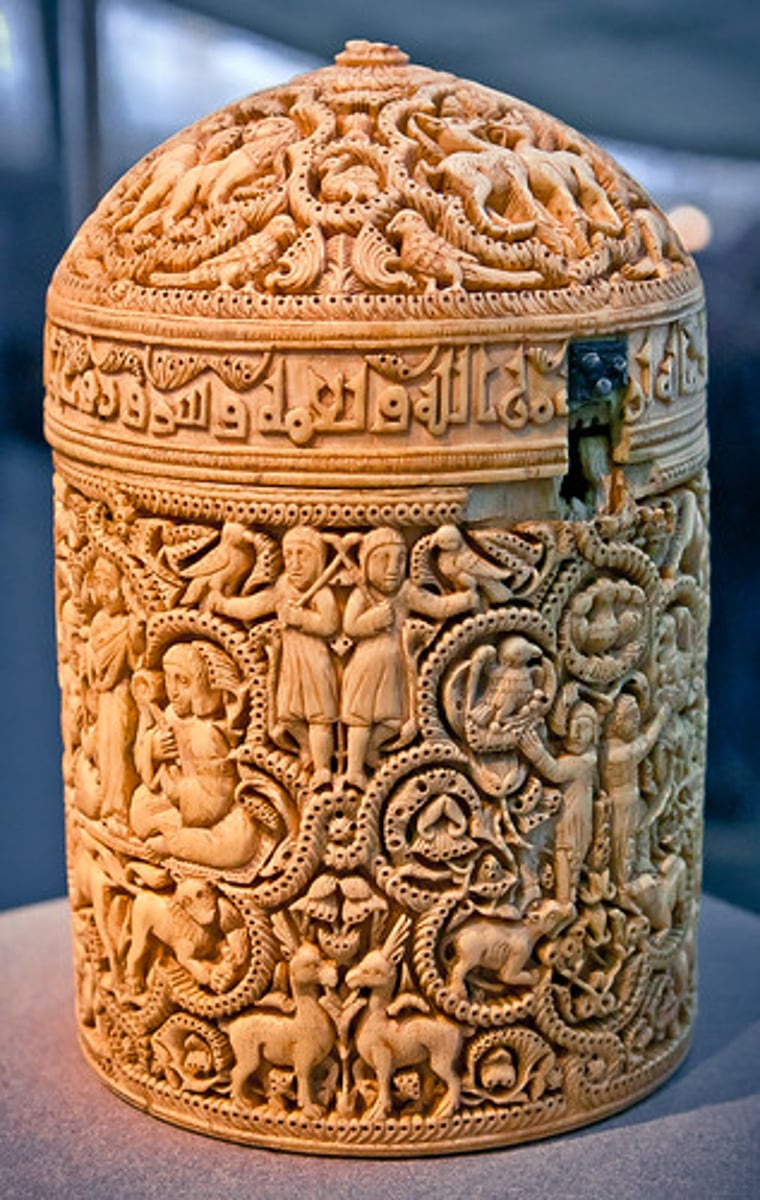
Church of Sainte-Foy (Romanesque Europe, 1050-1130, stone, Conques France), Last Judgement (1050-1130, stone and paint, Sainte-Foy, Conques), Reliquary of Sainte-Foy (1050-1130, gold, silver, gemstones, and enamel over wood, Sainte-Foy, Conques)
Form:
-symbolic Latin cross plan
-vaulting, groin vaults
-spolia
-archivolts: bands that go around tympanum
Content:
-gallery on top (distributes the weight)
-barrel vaulting
-tympanum
-radiating chapels, nave arcade
-3 aisles
-dark building
Function:
- pilgrim church, people come to see
-built so that it could handle a lot of people
- part of monastery where monks lived

Bayeux Tapestry (Romanesque English or Norman, 1066-1080, embroidery on linen)
Form:
-2/3 of a football field in length
-continuous narrative
Content:
-a great epic
-2 main scenes
-story of William's conquest of England in the battle of Hastings
-Haley's Comet
Function:
-show Norman conquest
Context:
-Cantebury, NW France
-commissioned by Bishop Odo
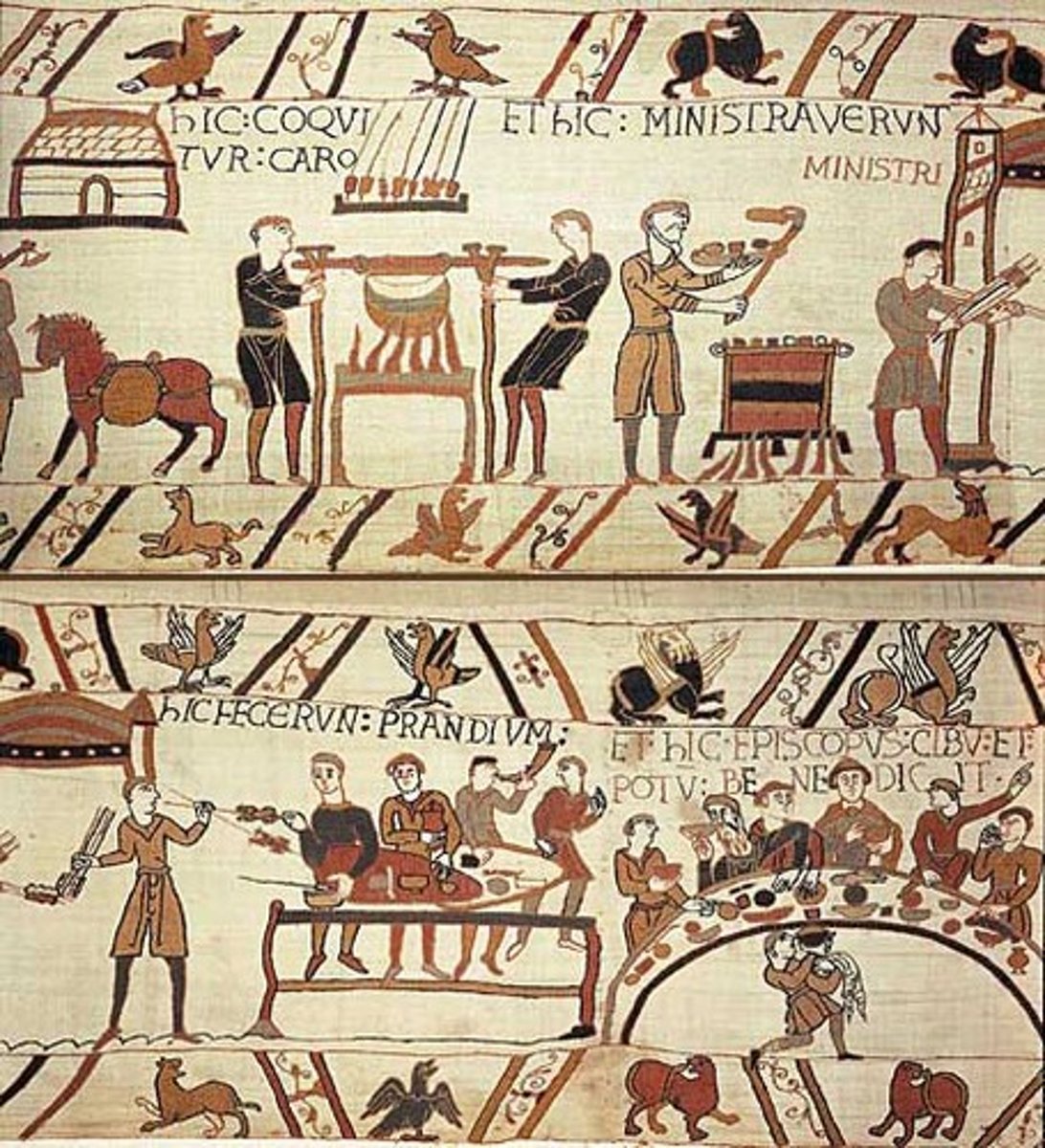
Chartres Cathedral (limestone and stained glass, Gothic Europe, 1145-55, reconstructed 1194 - 1220), Great Portals of the west Facade (1145 - 55, limestone, France) Notre Dame de la Belle Verriere (1170, stained glass, Chartres Cathedral)
Form:
-3 phases of Gothic (Early in facade, High French in back, Late in the North Spire)
-painted arches, rib vaults- Gothic elements
-colors vivid
-knowledge, nature, light
Content:
-narrow passageway
-jamb figures
-relic: Mary's dress
Function:
-Church with great beauty that honors Mary and gives her the respect she deserves
-built after they found Mary's Tunic unharmed in the fire
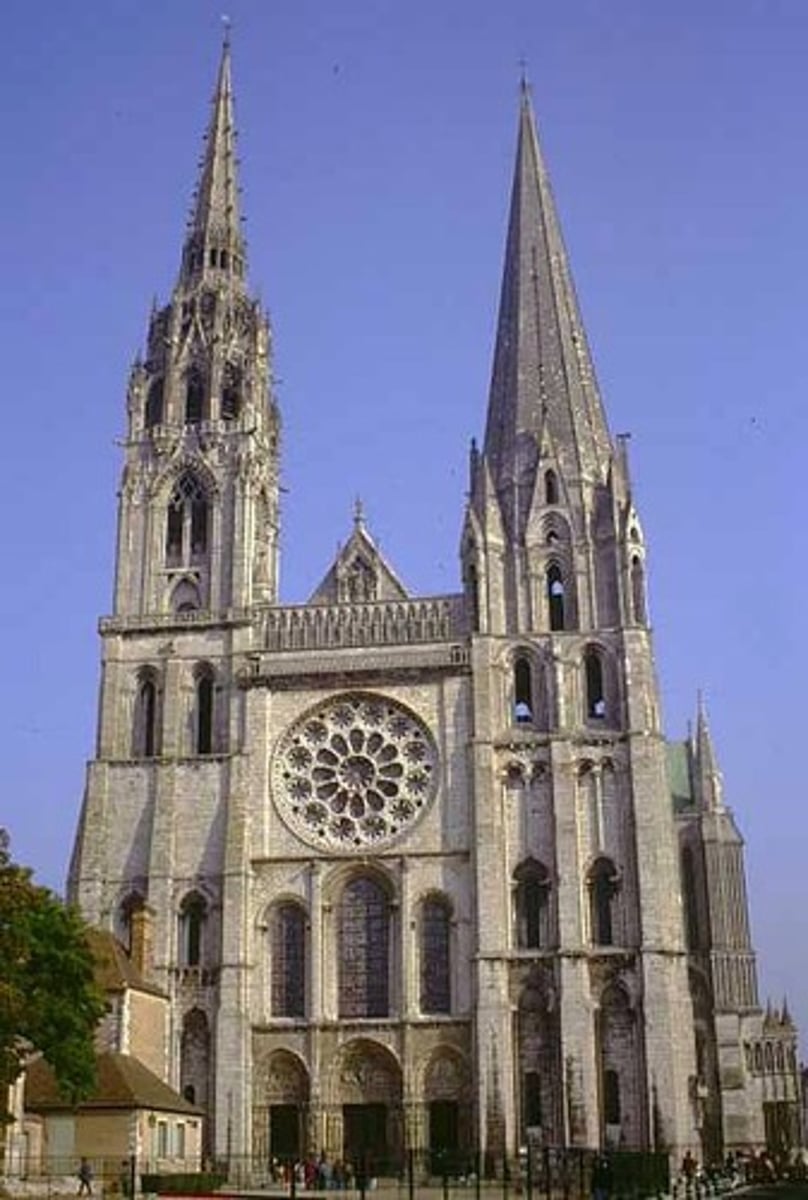
Dedication Page with Blanche of Castile and Louis IX of France (Gothic Europe, 1226-34, illuminated manuscript, ink, tempera, and gold leaf of vellum)
Form:
-dedication page
Content:
-King Louis IX
-Blanche of Castile
-passages from Old and New Testament
Function:
-made for Frnech royals' home (King Louis IV)
-create a moral through visionary readings

Rottgen Pieta (Late medieval Europe, 1300-25, painted wood)
Form:
-Medieval/Gothic and realistic
Content:
-Mary holding her dead son after Cruxifiction
-Mary is pained and anguished
Functions:
-versperbils (German devotional)
-feel the pain she feels
-intended to be used in contemplation and prayer
-devotional image
-shows them closer to the humanity side
Context:
-German Gothic
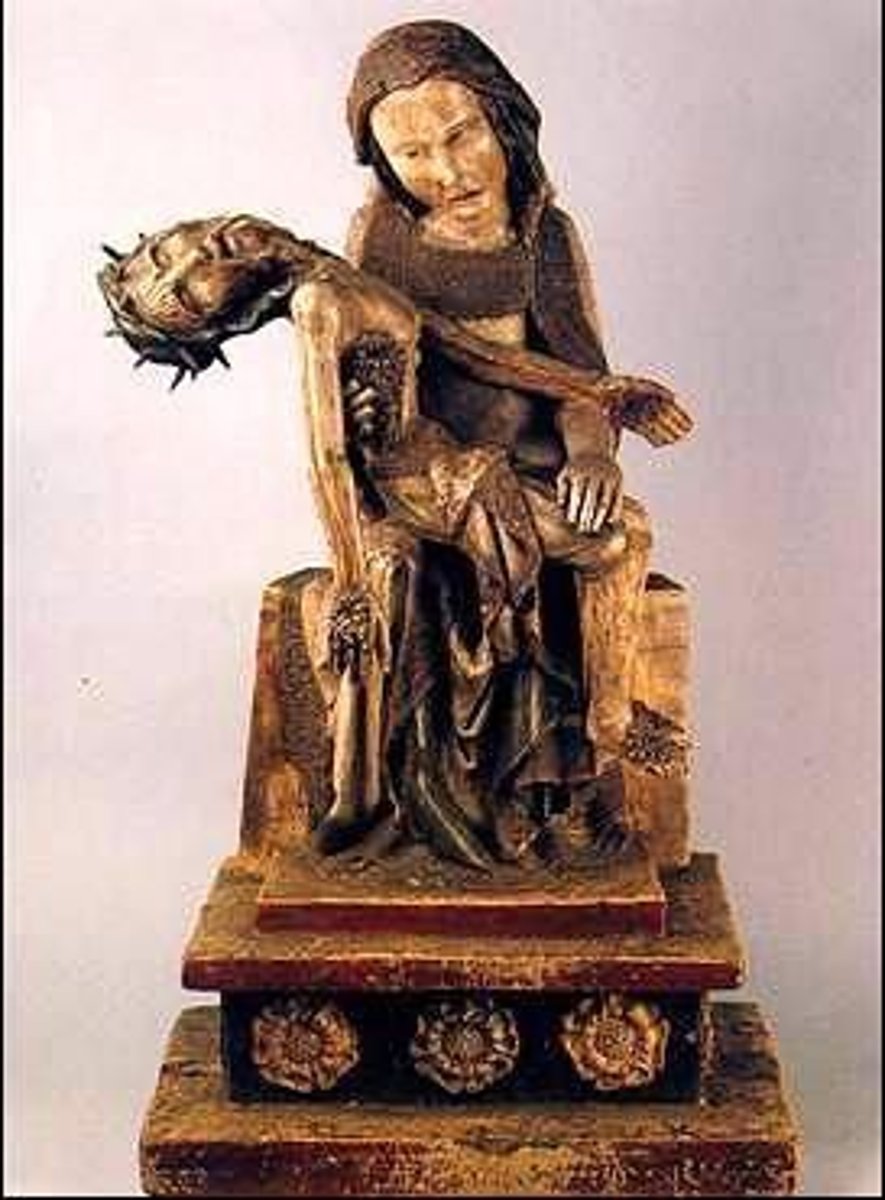
Arena (Scrovegni) Chapel. (1303, brick, Padua, italy)
Form:
-fresco
-painted plaster
-grisaille (gray tones)
-quatrefoils
-tracing
-plain outside, transformative inside
Content:
-Last judgement scene
-lancet windows
-Scrovegni at bottom offering up chapel to Jesus (artist portrait included)
-The Lamentation (Jesus has been crucified and now he is being mourned)
-Mary with others grieving
-Life of Mary>Passion of Jesus
Function:
- private family chapel (connected to a house)
Context:
-on grounds of an old arena
-artist: Giotto di Bondone
-Proto-Renaissance

Golden Haggadah (late medieval Spain, 1320, illuminated manuscript, pigments and gold leaf on vellum)
Content:
-Left: plagues of Egypt
-Middle: scenes of liberation (Israelites leave)
-Right: Passover
Function:
-book used by a wealthy Jewish family to tell the story of Passover around the sedar table each year
Context:
-similar to Christian Gothic manuscripts
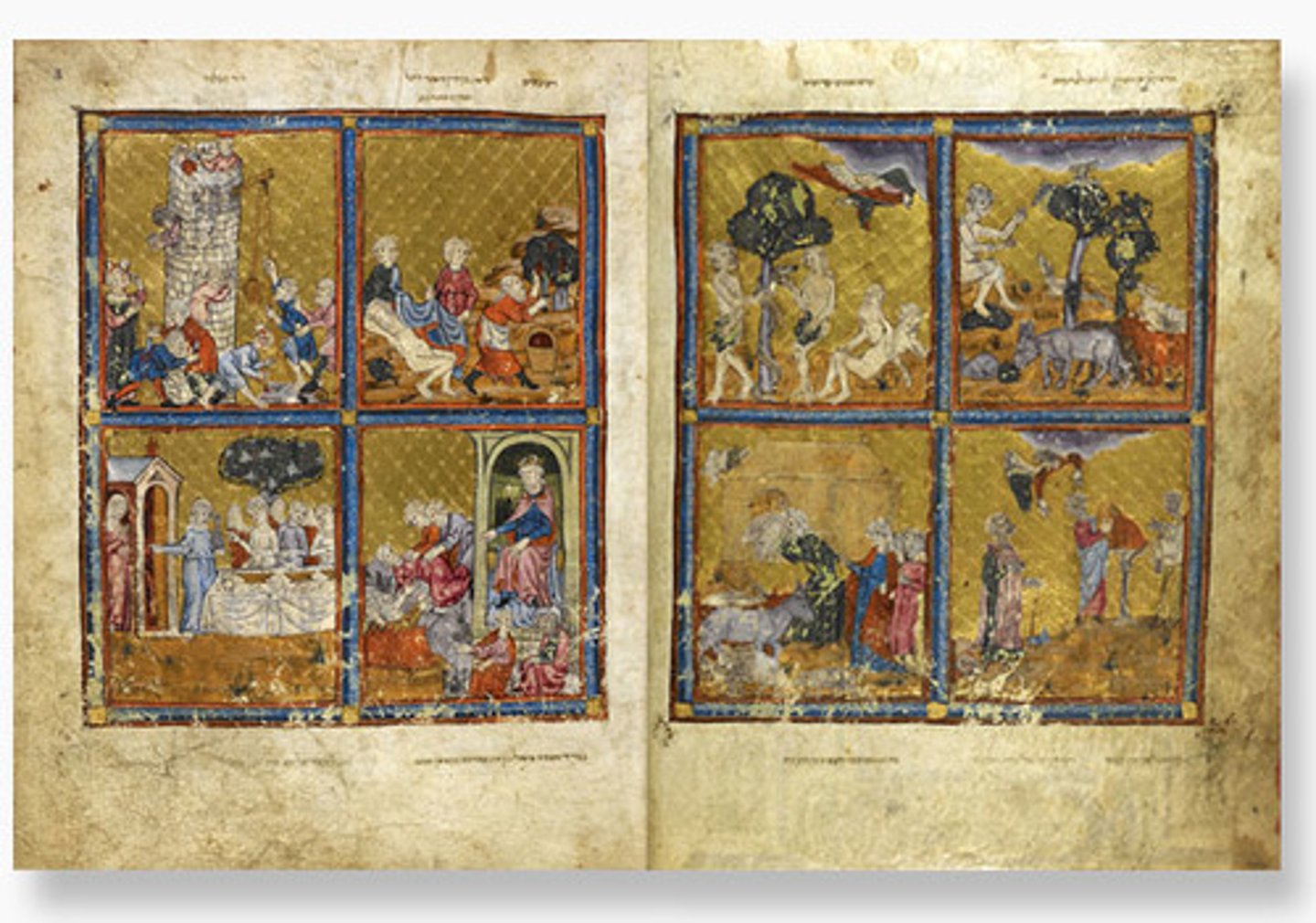
65. Alahambra(Granada, Spain- Nasrid Dynasty 1354-1391 CE, whitewashed adobe stucco, wood, tile, paint, and gilding)
Form:
-complex arches
-elevated on top of a hill (power)
-arabesques (organic/natural designs- flowers/vines) on arches
Content:
-court of lions: courtyard with gardens and water- luxurious
-4 quadrants
-channels of water run throughout
Function:
-complex of palaces
-some markets
-garden provokes sense of paradise/heaven
-palace of Nasrid
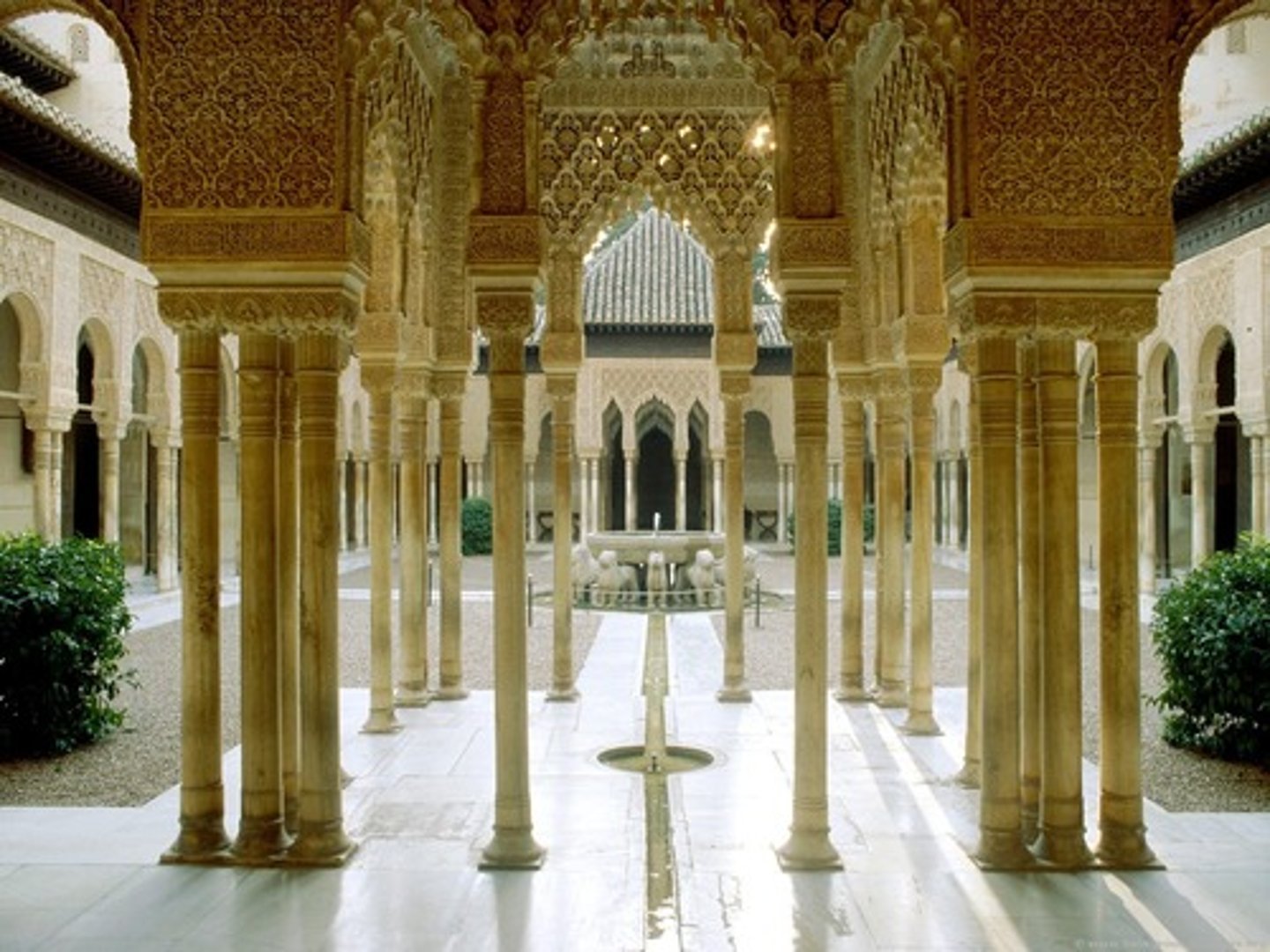
Annunciation Triptych (Robert Campin Workshop, 1427-1532, oil on wood)
Form:
-altar piece (portable)
-renaissance
-hyper reality/hyper clarity
-closed during the week, open during mass
Content:
-scene of the Anunciation
-Holy Spirit and Jesus coming through window
-couple asking for divine intervention
-Joseph on right making mouse traps
-Mary laying down on pew
-image of Chris coming from the window going to Mary's womb
Function:
-private devotional place
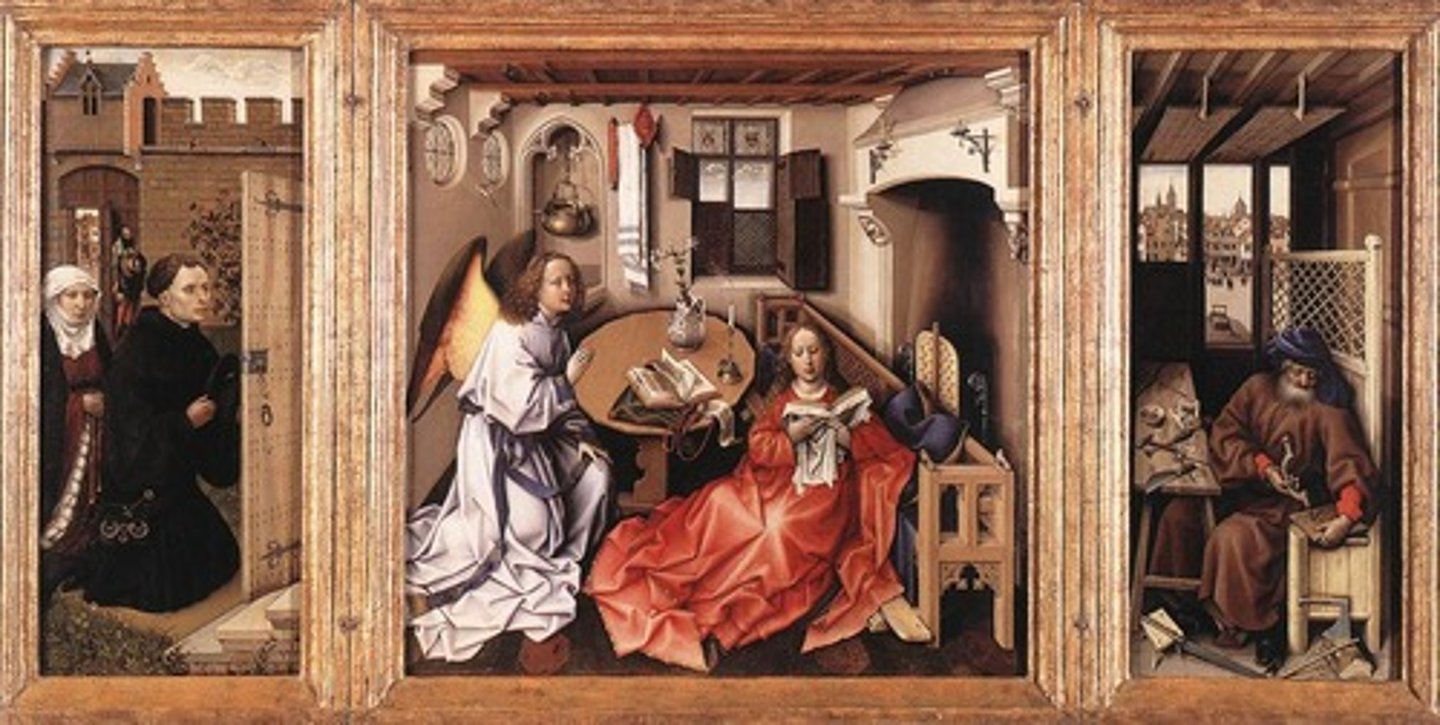
Pazzi Chapel (Filipo Brunelleschi, 1429-61, masonry, Florence, Rome)
Form:
-articulate, everything white on the inside
-dome cieling
-simple geometry
-pietra serena- soft gray tone
-inlaid marble, terracotta tiles
-strigil pattern
-Franciscan
Content:
-entablature
-arch forms
-family crests
Function:
-show Pazzi family wealth
-served as chapter house (meeting room for the Franciscan monks)
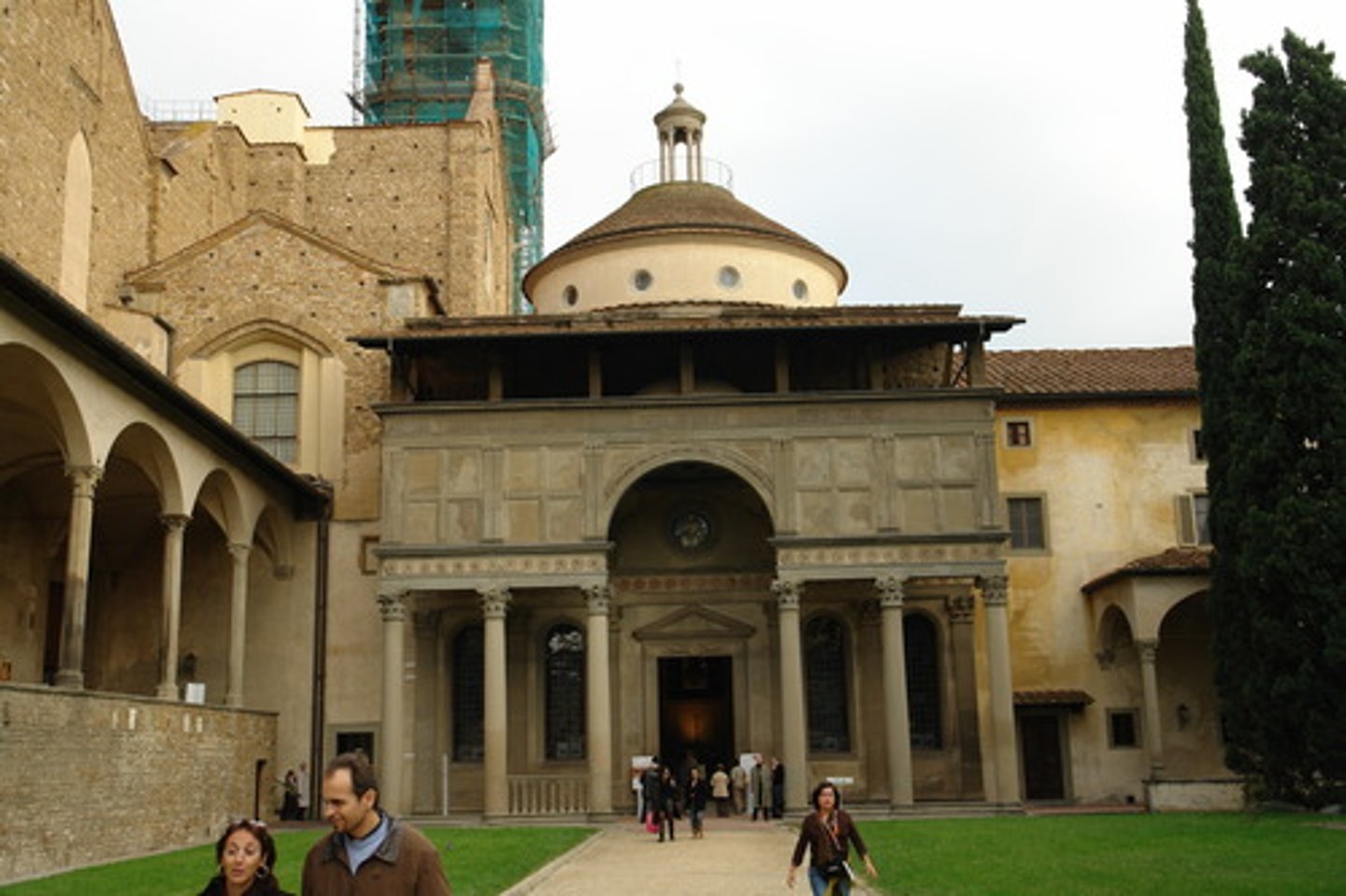
Arnolfini Portrait (Jan Van Eyck, 1434, oil onwood)
Form:
-Renaissance
Content:
-betrothal (engagement)
-dog represents wealth and fidelity
-barefeet- something sacred taking place
-Patron saint of domesticity (St. Margaret
-Vaneyck signature and reflection in mirror
-witnesses of the marriage shown in the mirror
Function:
-shows status, wealth, power
Context:
-Flanders

David Donatello (Donatello, 1440-60,, bronze)
Form:
-exaggerated contrapposto
-beautiful, ideal, classical, cultured, independent, wealth, power (like Florence)
Content:
-shepherd's hat with flowers of Florence (small can conquer giants)
-biblical figure of Florentine Republic
-religious AND political connotation
-return to the nude powerful figure in contrapposto
-Goliath's head under his foot
Function:
-made for private viewing
-made for Medici
Courtyard
Context:
-early renaissance
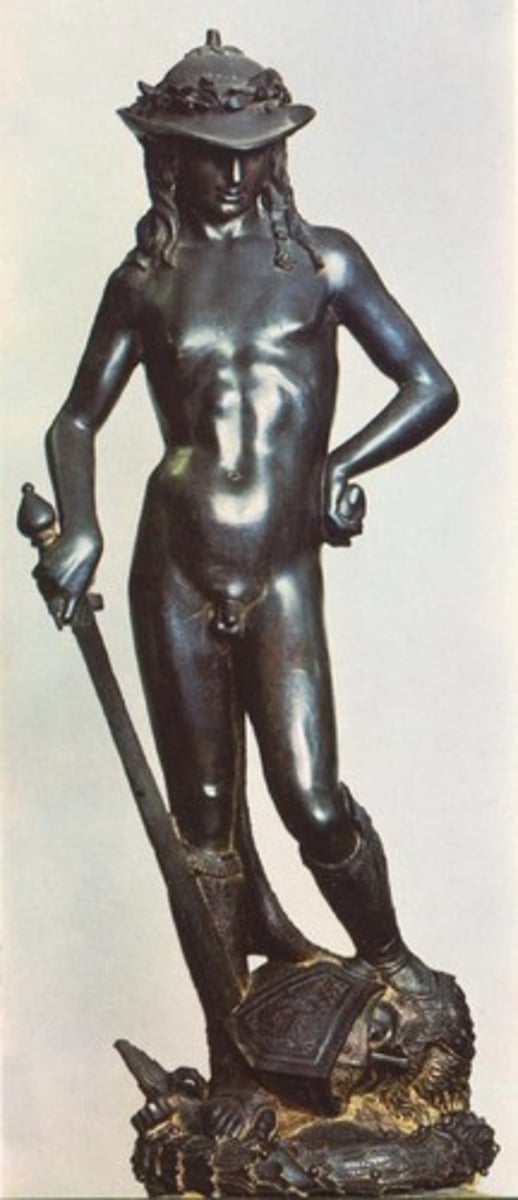
Palazzo Rucellai (Leon Battista Alberti, 1450, stone, masonry, Florence)
Form:
-3 levels (like classical)
-round arches
Content:
-3 levels: each different column style
-built around courtyard
-levels around divided by entablatures with frieze
-Medici and Rucellai symbol in frieze
-humanism: domestic architecture
Function:
-show allegiance to Medici
-civic pride
-beautiful city
-residences and businesses
-show their good taste
Context:
-Giovanni Rucellai commissioned it
-Early Italian Renaissance
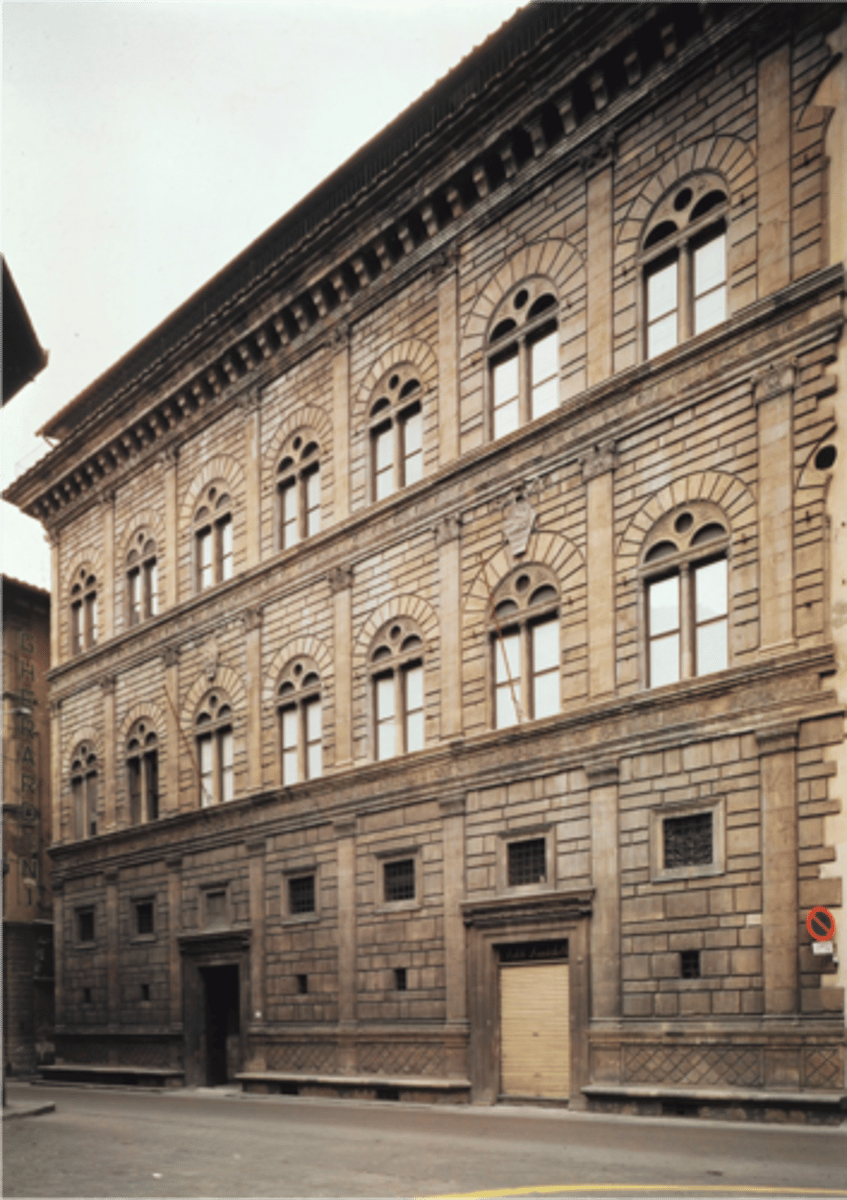
Madonna and Child with Two Angels (tempera on wodd, 1465, Fra Filippo Lippi)
Form:
-3D figures
-sense of space
-elegant lines/curves
-humanism
Content:
-all humanized (mischievous look)
-Mary's halo slowing going away (divinity fading)
-Mary youthful/beautiful
-landscape through window (Flemish background)
-pearls (symbol of immaculate conception
Function:
-relate more to viewers by making humanistic images
-connect us to Mary and Jesus
Context:
Early Renaissance Italy
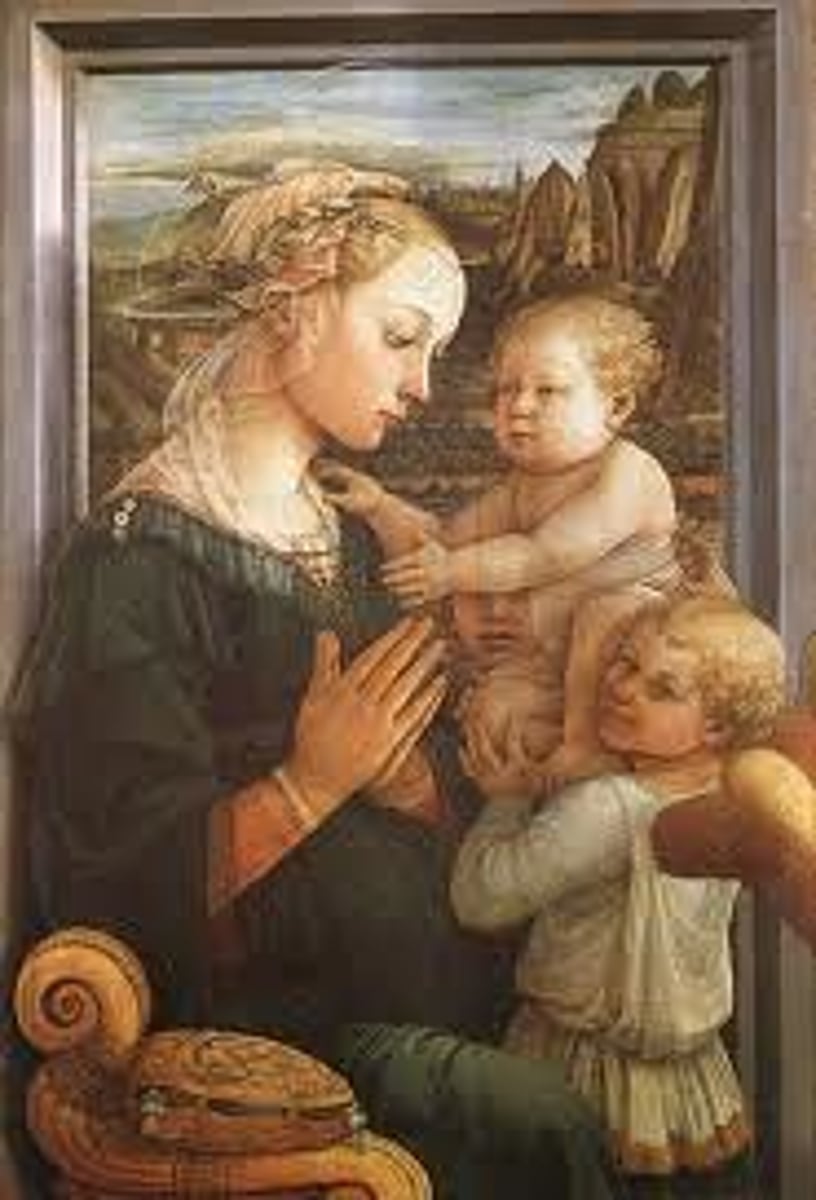
Birth of Venus (tempera on canvas, 1484-1486, Sandro Boticelli)
Form:
-curvy body (flexibility)
-neoplatonic love (classical and Christian)
-sense of pattern and beauty
Content:
-Venus standing on seashell
-born by the sea fullgrown
-couple intertwines; pushing Venus to land
-someone on shore ready to receive Venus with cloth
-floating figures
-Earthly and celestial love
Function:
-probably wedding gift
Context:
-Medici commission
-Venus is goddess of love
-Early Renaisasnce

Last Supper (Leonardo da Vinci, 1494-98, tempera and oil, Santa maria delle Graize, Milan)
Form:
-linear perspective, spatial illusionism, frieze-like
-triangle in center (Christ @ the point)
-monumental forms
Content:
-Jesus and his apostles having a final meals before Jesus is arrested
-the betrayal (Judas)
-the Eucharist (body and blood of Jesus) given to his people
-uses models to paint the people so he can make it more realistic
Function:
-dining hall/refectory for monks eating in silence
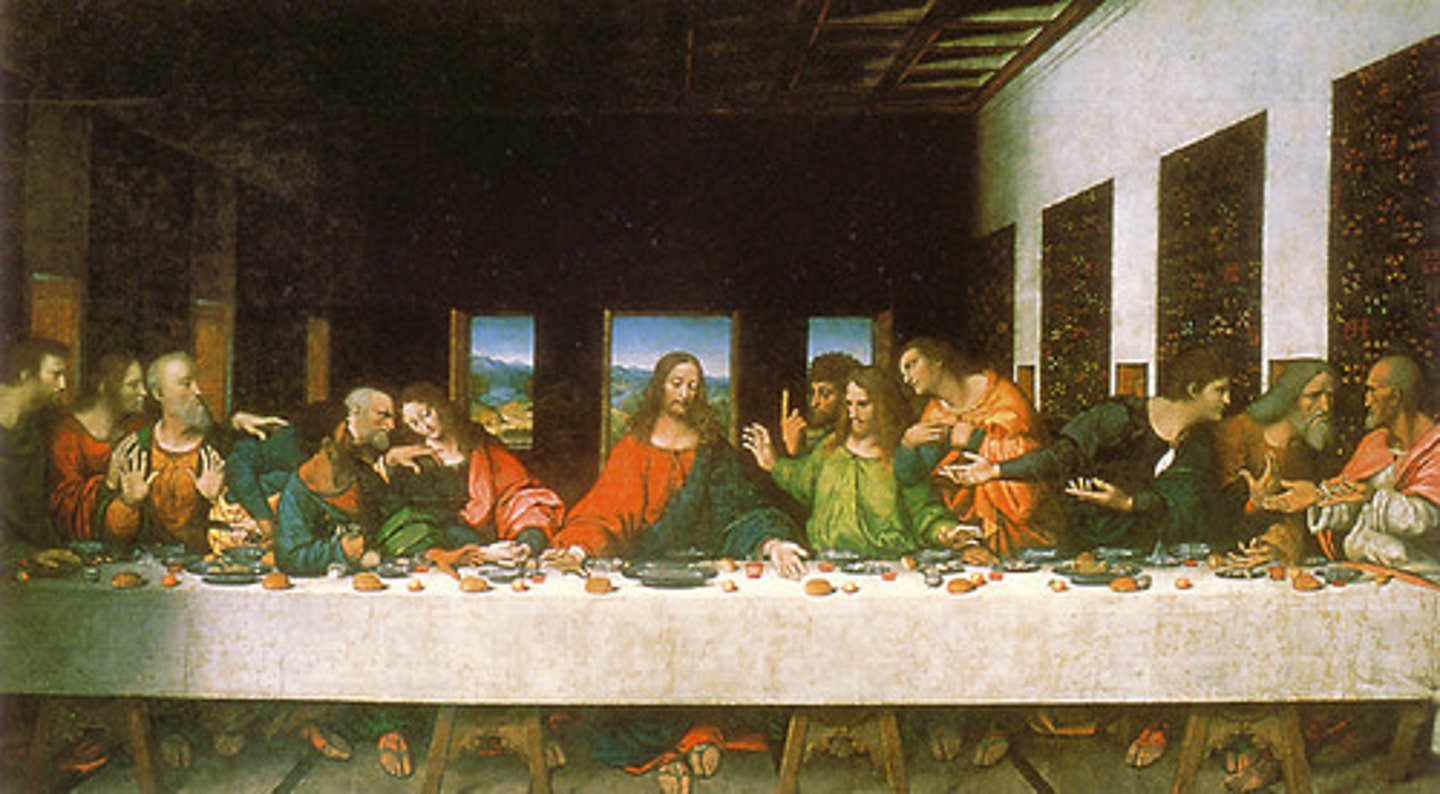
Adam and Eve (Albercht Durer, 1504, engraving)
Form:
-contrapposto
-tiny details (high renaissance)
Content:
-animals representing temperaments and humors being let into the world
-artist signature on sign
-Tree of Knowledge and Life
-fall of humanity
Function:
-shows his knowledge of classical act
Context:
-artist: Albrecht Durer (german)
-Latin

Sistine Chapel (Michealangelo, 1508-12, fresco, Vatican City)
Form:
-sculptural element to his paintins
-neoplatonic (classical and Judeo-classical)
-hellenistic figures
Content:
cieling:
-scenes from the OT (9)
-Noah's Ark
-men working on ark hoping for salvation
-duster seeking sanctuary
altar wall:
-counter reformation
-last judgement, life and death
-saved and damned people
-sibyls: monumental (hellenistic figures)
-portraits of certain artists on lower walls
Function:
-election of new pope and masses happen in this building
-art is made for this building (Sistine Chapel)
Context:
-under Pope Julius II
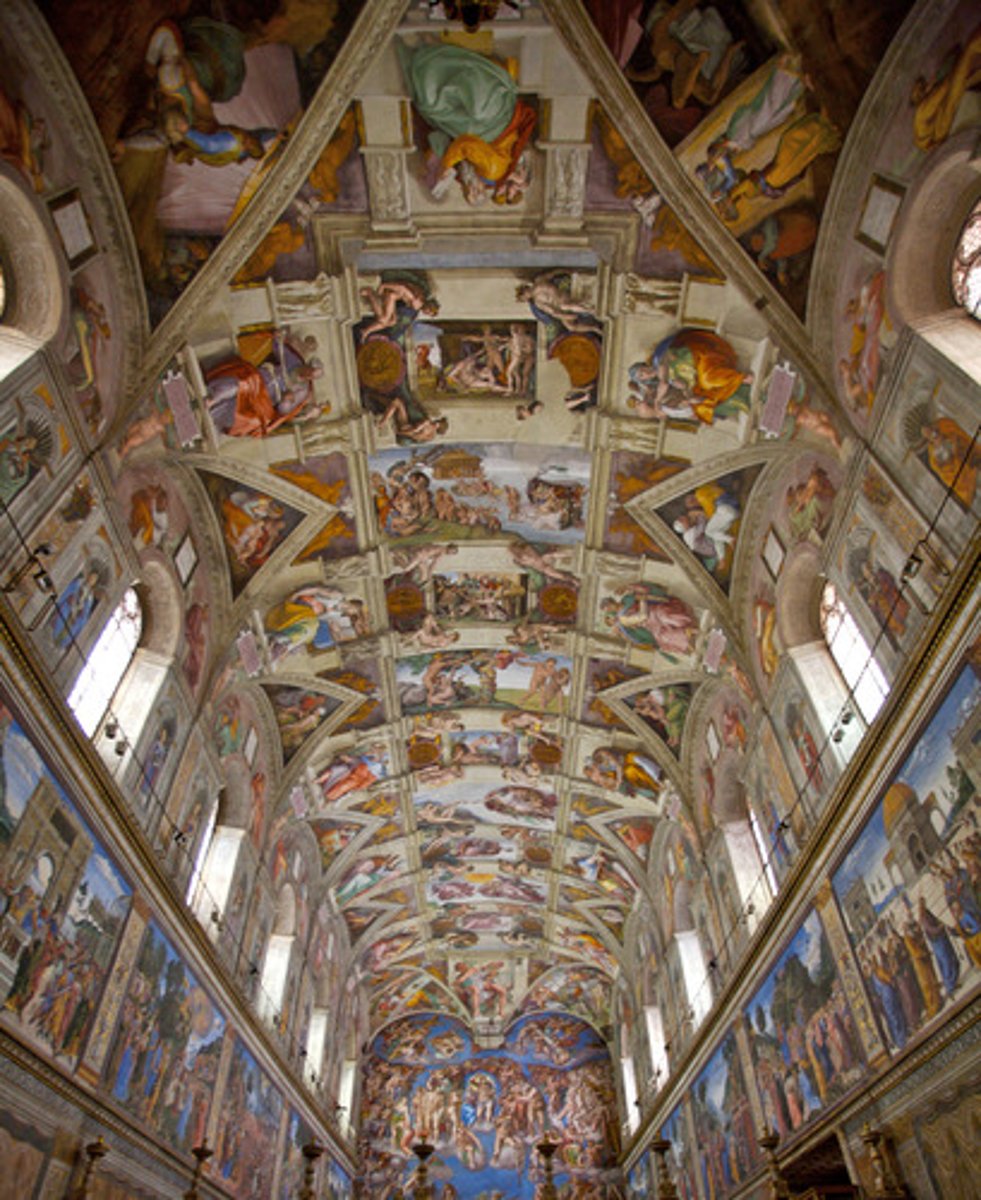
School of Athens (fresco,Raphael, 1509-11, apostolic, Vatican)
Form:
-spatial illusionism
-fluid/interlocking
-same style as Sistine figures
-roundalls
-barrel vaults
-coffers
Content:
-branches of knowledge under faith
-philosophy and science
-Plate: idealism (points up)
-Aristole: realism (points down)
-Raphael self portrait
-Michaelangel on block of marble
-poetry, imagination
-disputah: faith and reason
-heavenly court of prophets and saints
-Jesus in full body halo
-Stanza della Segnatura: room of signatures
-acorns: symbol of family
Function:
-expresses knowledge and faith
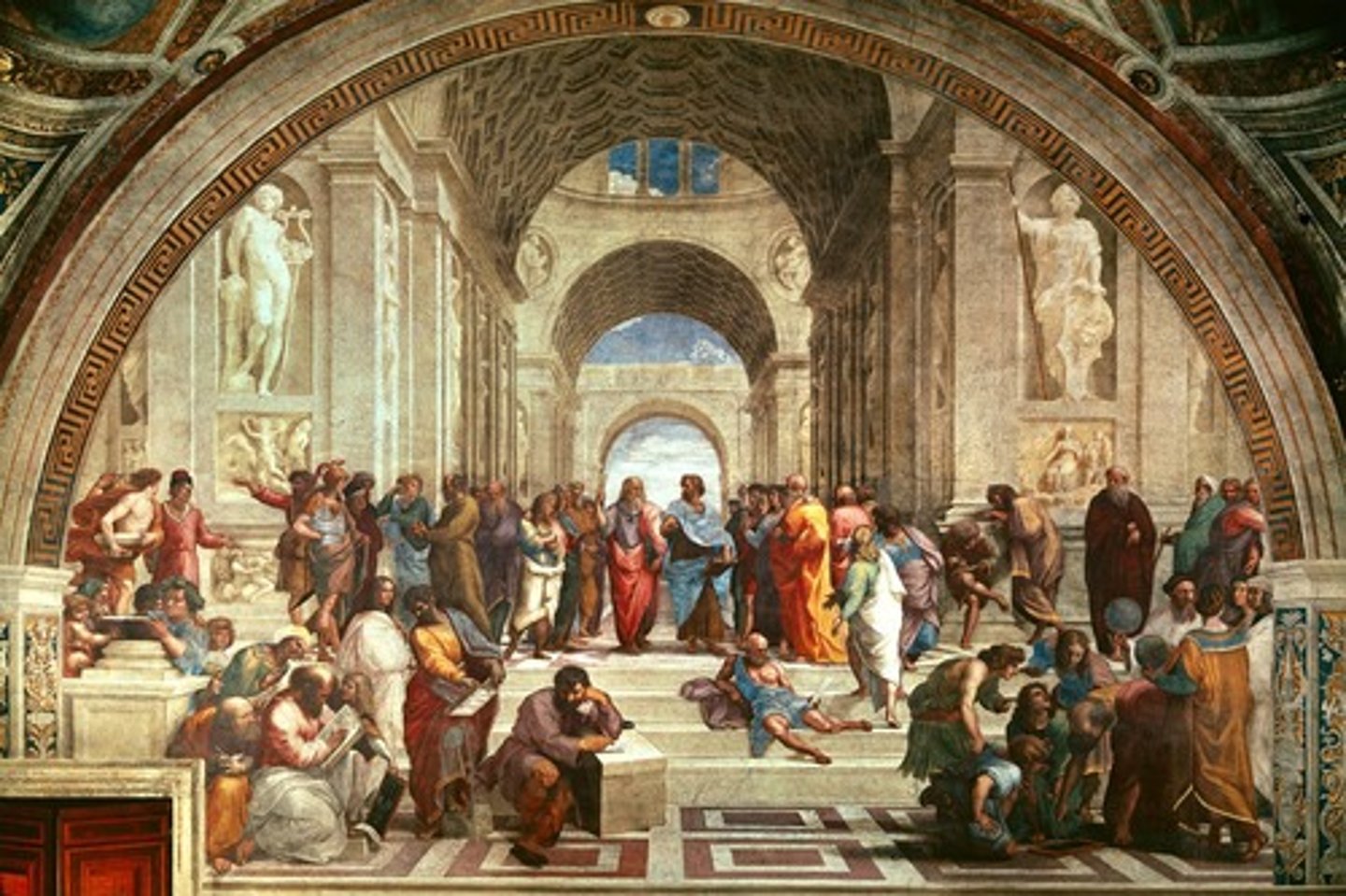
Isenheim Altarpiece (Mattthias Grunewald, 1512-1516, oil on wood)
Content:
-predella: base of the altarpiece
-1st panel: shows Jesus suffering on the cross symbolizing the suffering of the patients
-2nd panel: shows Jesus resurrection
-3rd panel: statue of St. Anthony who was patron saint of the hospital
Function:
- made for a hospital to relate their suffering to Jesus' suffering in order to make them feel better
Context:
- no longer in situ
- Boarder of France and Germany
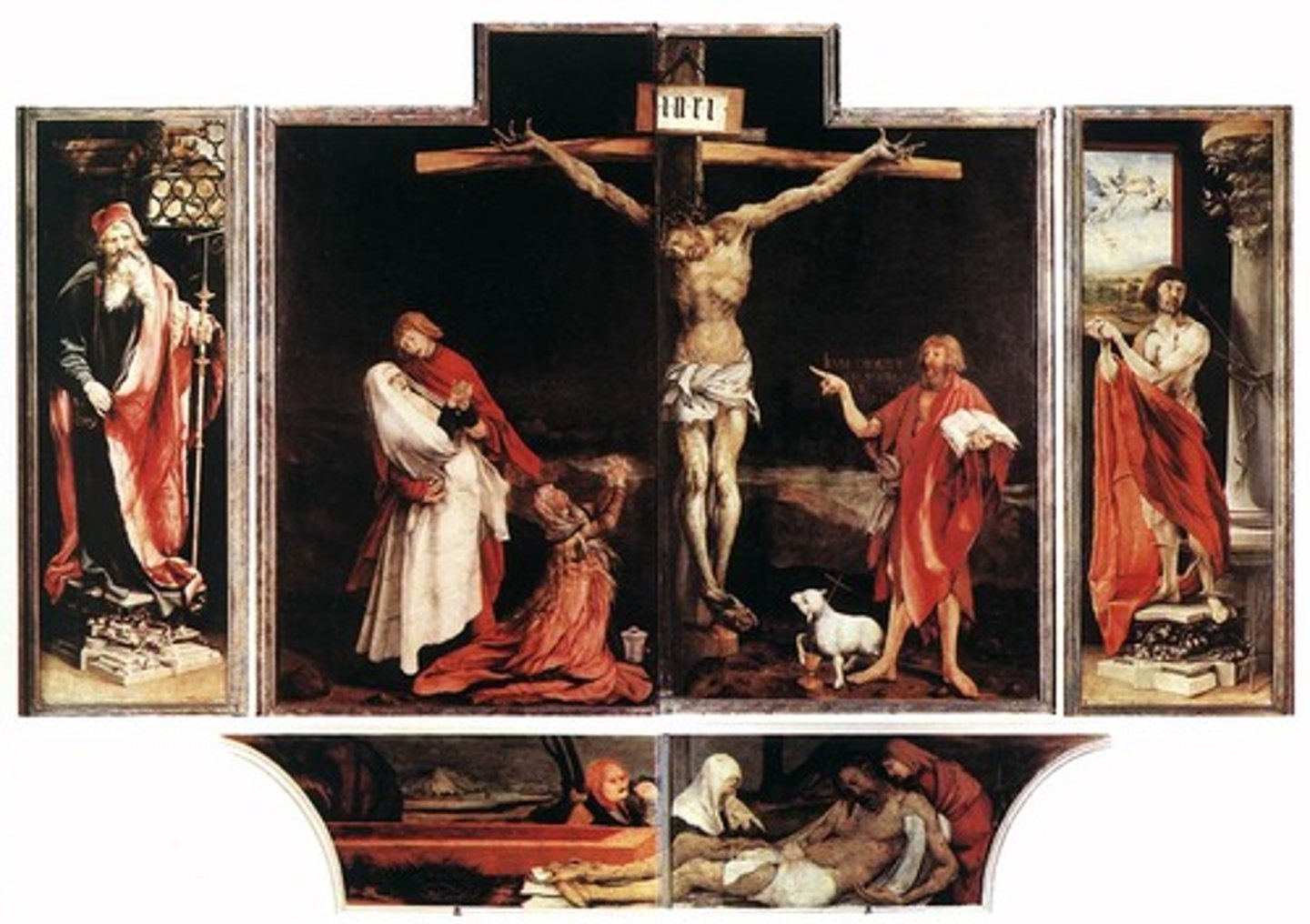
Entombment of Christ (Jacopo de Pontormo, 1525-28, oil on wood)
Form:
-manneristic: shows great knowledge of Renaissance but distorts it
-figures stylized and elongated
-primary colors and white
-roundalls above of Evangelists
-space is nonsensical
-1D (no depth)
Content:
-no symbols of holiness (no cross, etc.)
-Mary proportionately larger
-everyone mournful
-lower Jesus from the cross
-chaotic figures/constant movement
-self portrait
-non balance (lots of different directions)
Function:
-altar piece
-doesn't look Renaissance
-family chapel
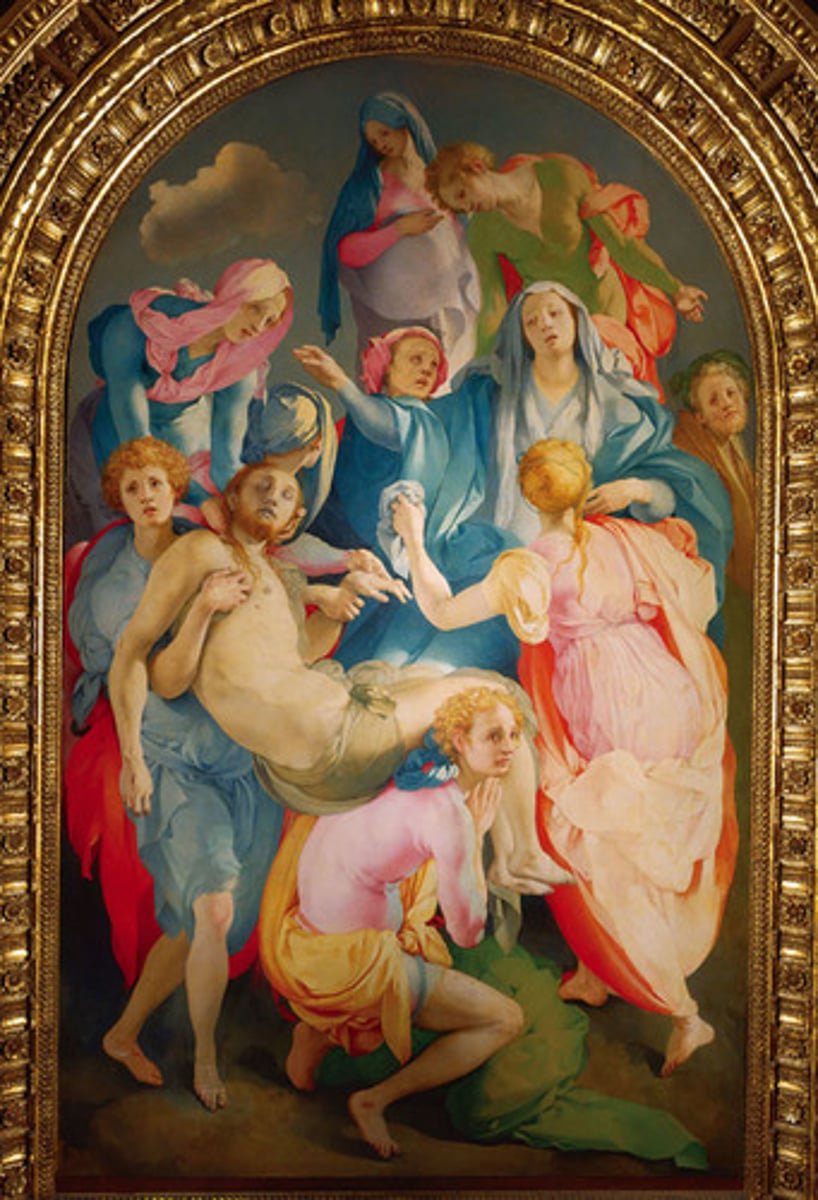
Allegory of Law and Grace (Lucas Cranach the Elder, 1530, woodcut and letterpress)
Form:
-Protestant
-German text
Content:
-written in people's voice
-left: being chased by death (shows 10 commandments)
-right-washes over with Holy Spirit (can only be saved by God's grace
Function:
-propaganda during Reformation
-debates between Catholics and Luthers on how to get to heaven
Context:
-German; worked with Martin Luther

Venus of Urbino (titian, 1538, oil on canvas)
Form:
-rich colors (red)
-nude reclining
-celebrating female body
-paints thin layer of paint to create flow and softness
Content:
-woman reclining while maids get her clothing
-dog=wealth
-seduction look= erotic
Function:
-wedding gift
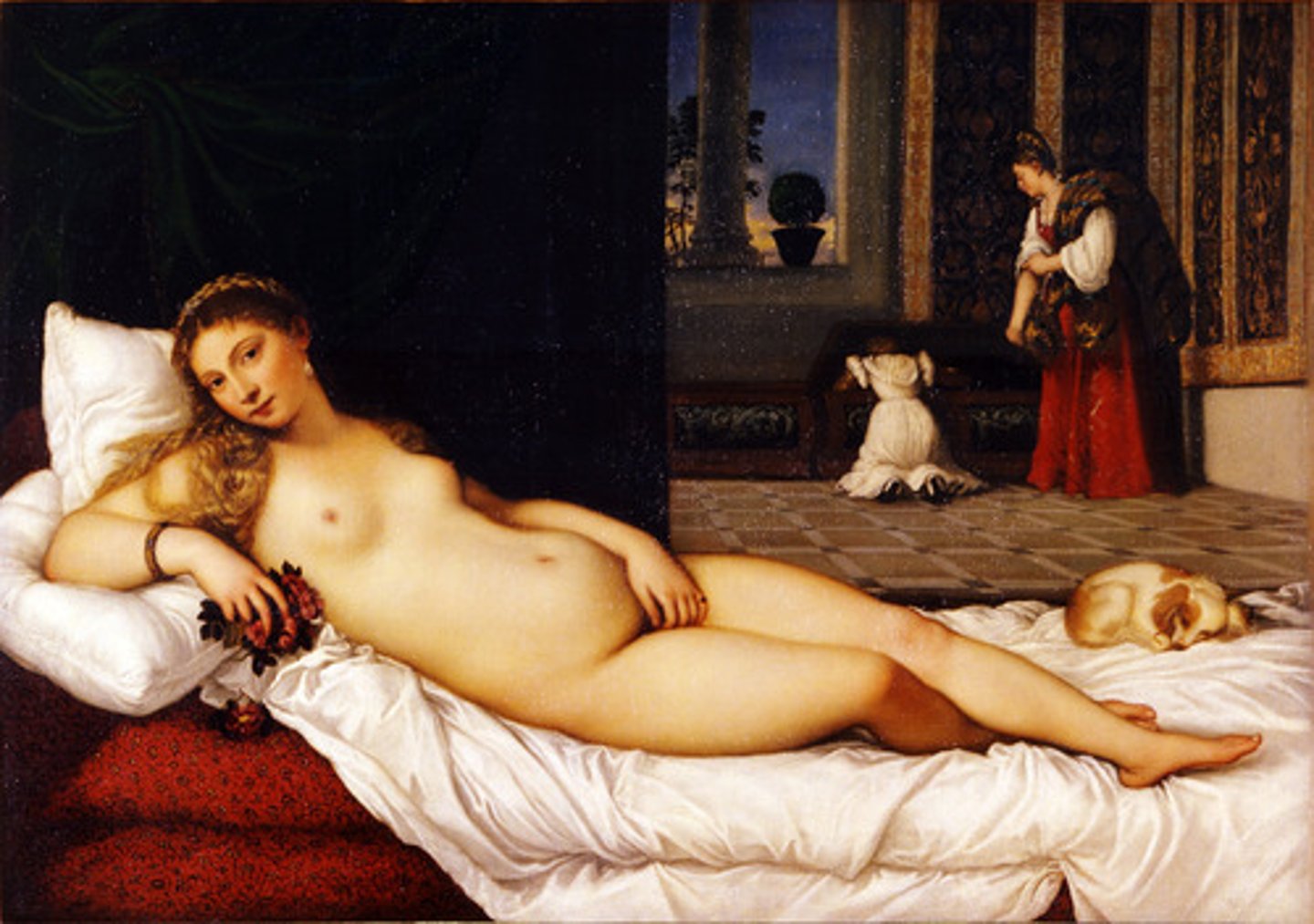
Frontispiece of the Codex Mendoza (Viceroyalty of New Spain, 1541-42, ink and color on paper)
Form:
-codex
-city laid out in 4 sections
-text
Content:
-Part 1: creation of the City of Tenochtitlan (eagle on cactus describes how city was founded)
-Part 2: conquests achieved by Aztec alliances
-Part 3: daily life
-Templo Mayor
-canals dividing cities
Function:
-made for Spanish viceroy
-historical account for the Aztecs
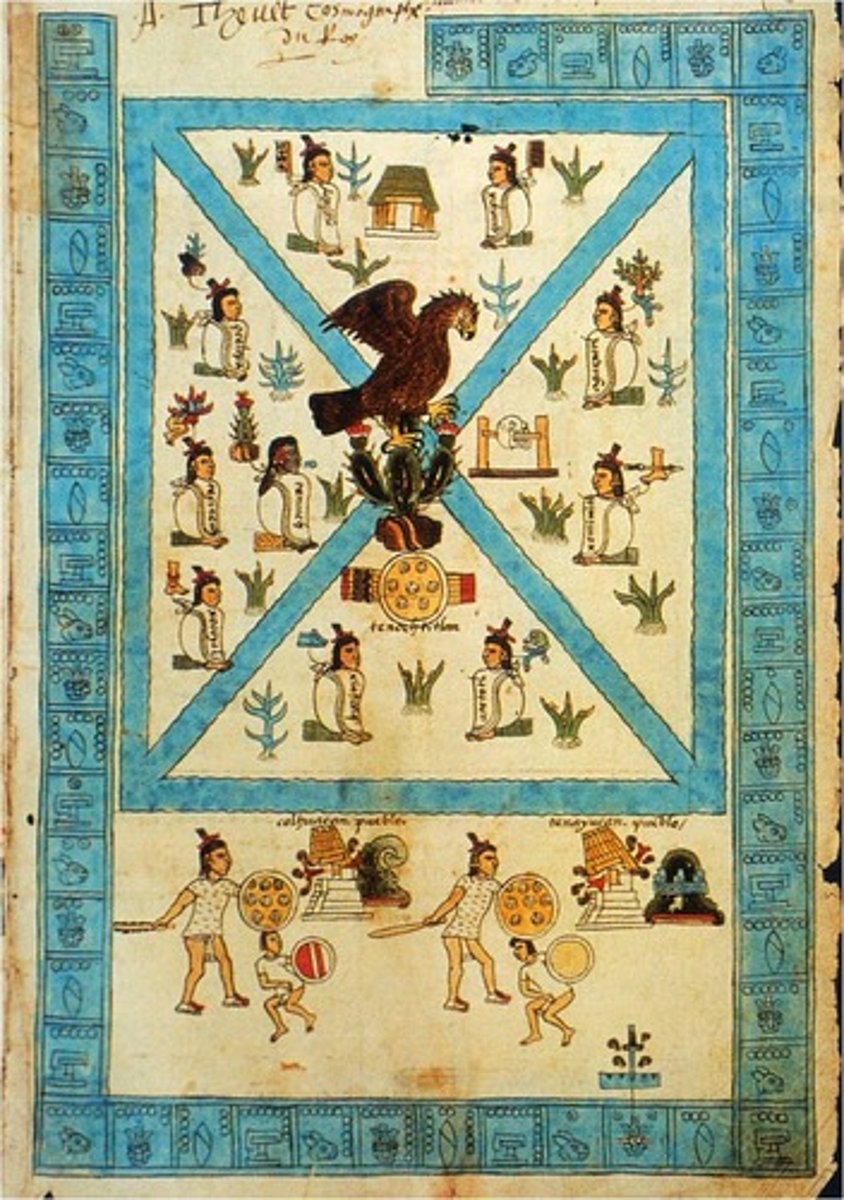
Triumph of the Name of Jesus (Giovanni Battista Gaulli, 1676-79, fresco and stucco, II Gesu, Rome)
Form:
-building: marble, brick
-Lation cross plan, simple
-single aisle
-Post Reformation
Content:
-faith through the senses
-Last Judgement (ceiling) spatial illusionism, end of Baroque period
-IHS: interpretation of Jesus' name
Function:
-mother church for the Jesuits of the world
Context:
-architect: Giacomo da Vignola
-facade: Giacomo della Porta
-Jesuits are great defenders of the pope
-ceiling made 100 years later (1676)
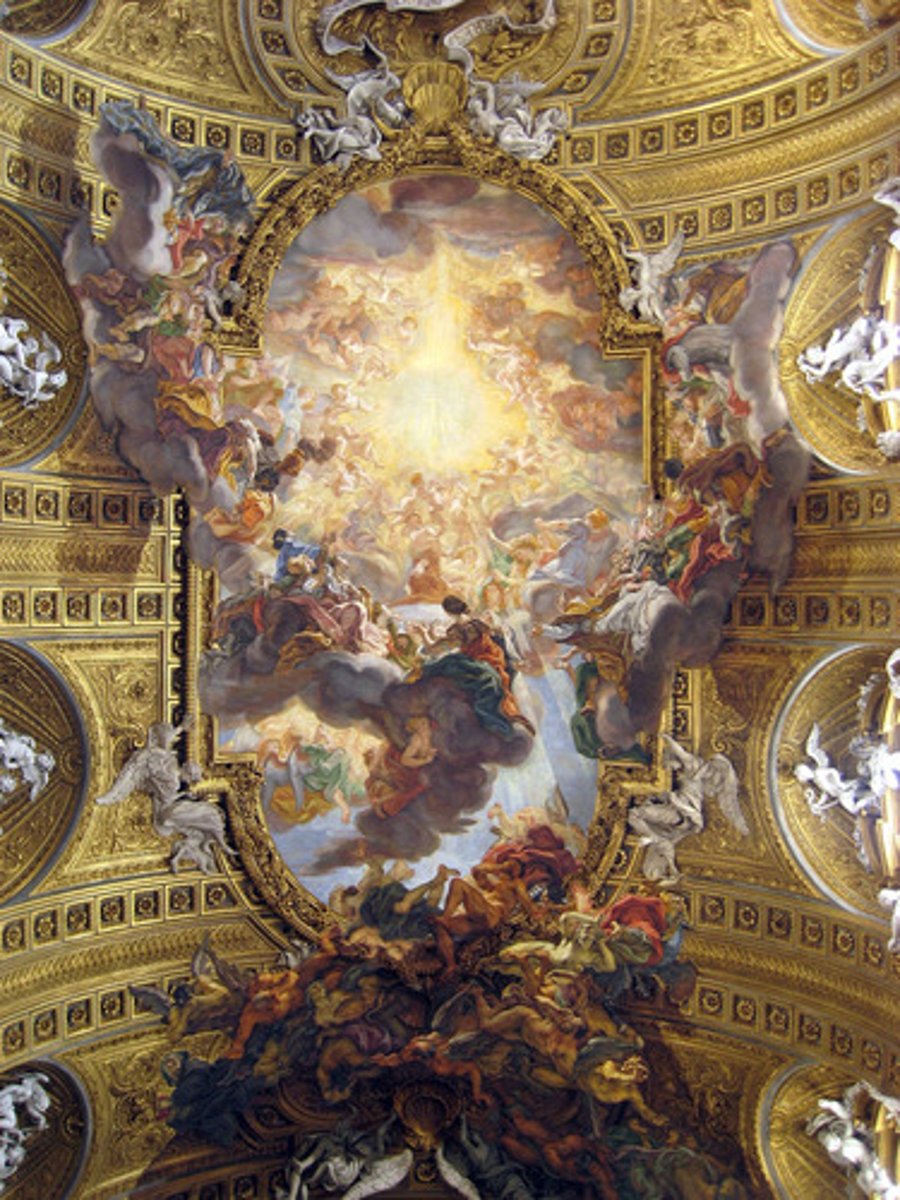
Hunters in the Snow ( Pieter Bruegel the elder, 1565, oil on wood)
Form:
-endless, winter landscape
-panoramic view
-apart of series of 4 seasons
Content:
-hunters coming back after an unsuccessful hunt (only one rabbit)
-people iceskating and curling (shows daily life)
-broken sign above inn
-vastness and beauty of world
Function:
-part of calendar series
0show how they had to get their food
0for dining room of wealth merchant in Antwerp
Context:
-Antwerp
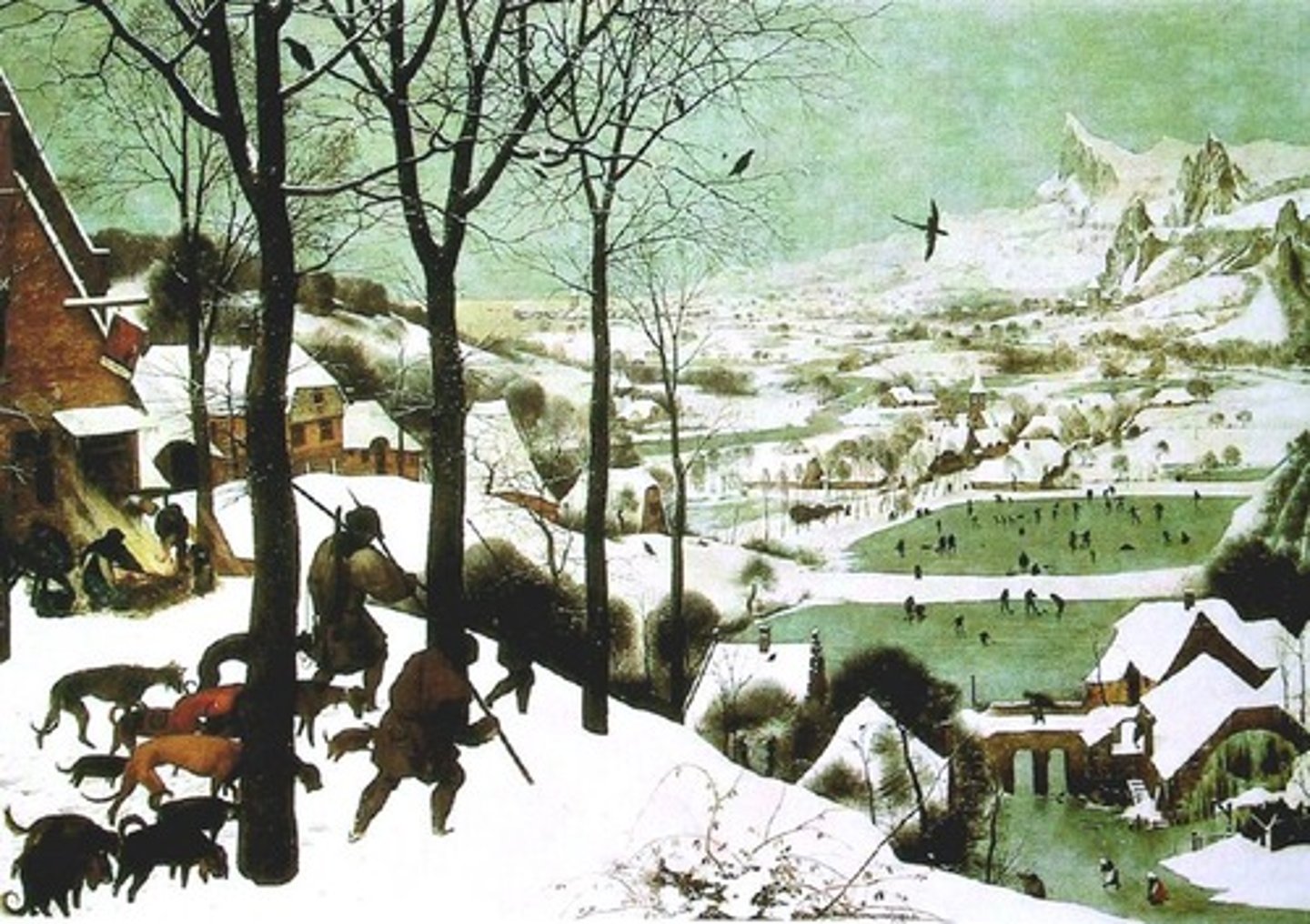
Mosque of Selim II (brick and stone, 1568, Edirne, Tukey: Ottoman,made by architect, Sinan)
Form:
-similar to Hagia Sophia
-dome, squinches, piers, apses
-richly decorated dome from the inside
-centralized, octagonal mosque
Content:
-slender, tall minarets
-centralized with 8 piers
-courtyard and prayer hall
-madrassa (college for Islamic instruction)
-souk: shops in the mosque
-Qibla wall faces outwards showing openness
Function:
-mosque made to replace Hagia Sophia
Context:
-part of a complex
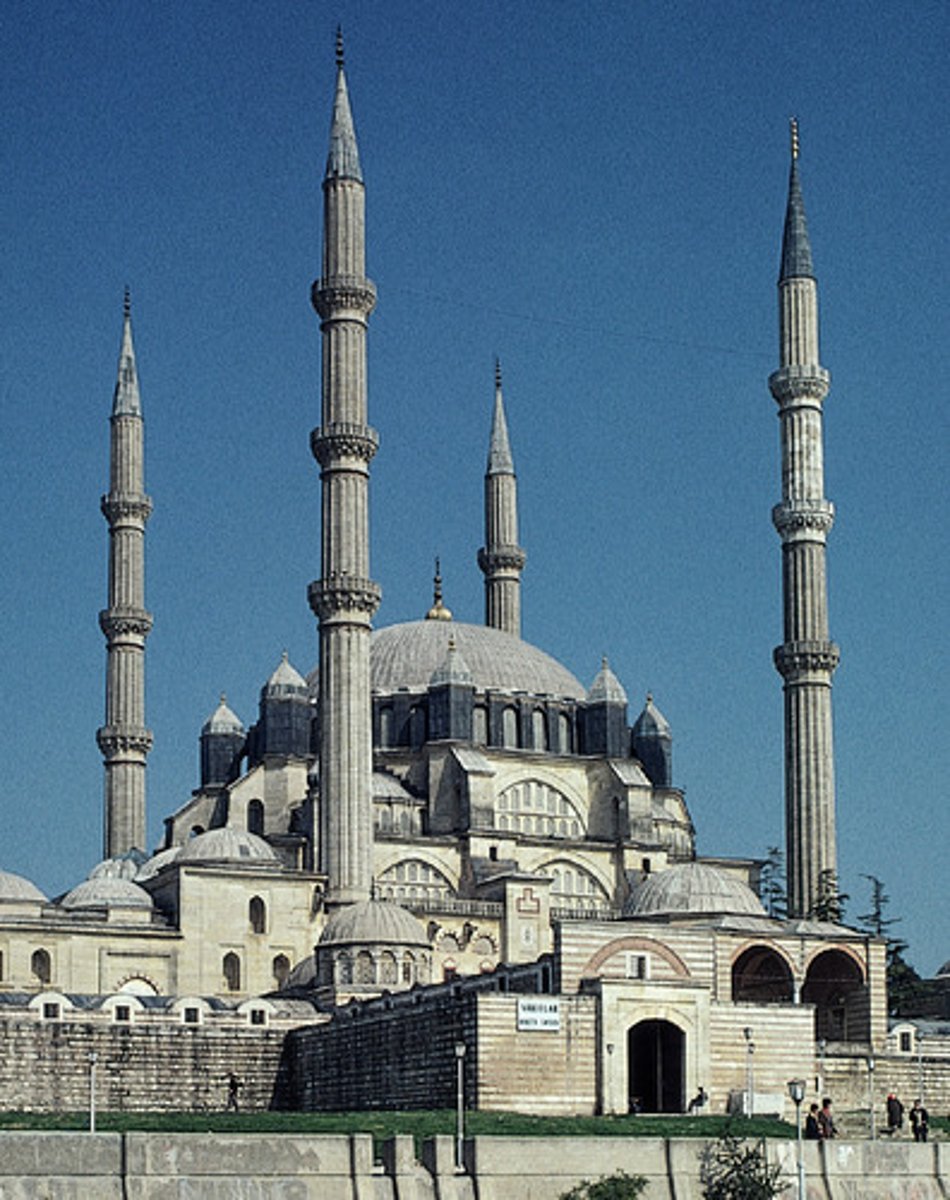
Calling of St. Matthew (Caravaggio, 1597-1601, oil on canvas)
Form:
-metaphysical painting
-Baroque (Counter Reformation, through your sense)
-diagonal light (tenebrism)
-realism/illusionism
-unusal setting for Jesus
Content:
-meant to be contemplated
-Jesus extended hand (same hand as in Sistine Chapel)
-Matthew sitting with fellow tax collectors
Function:
-body and soul are between a spiritual reality and physical reality
-Jesus shown in modern environment
-part of 3 part series
-use of light
-in chapel
Context:
-Contarelli Chapel
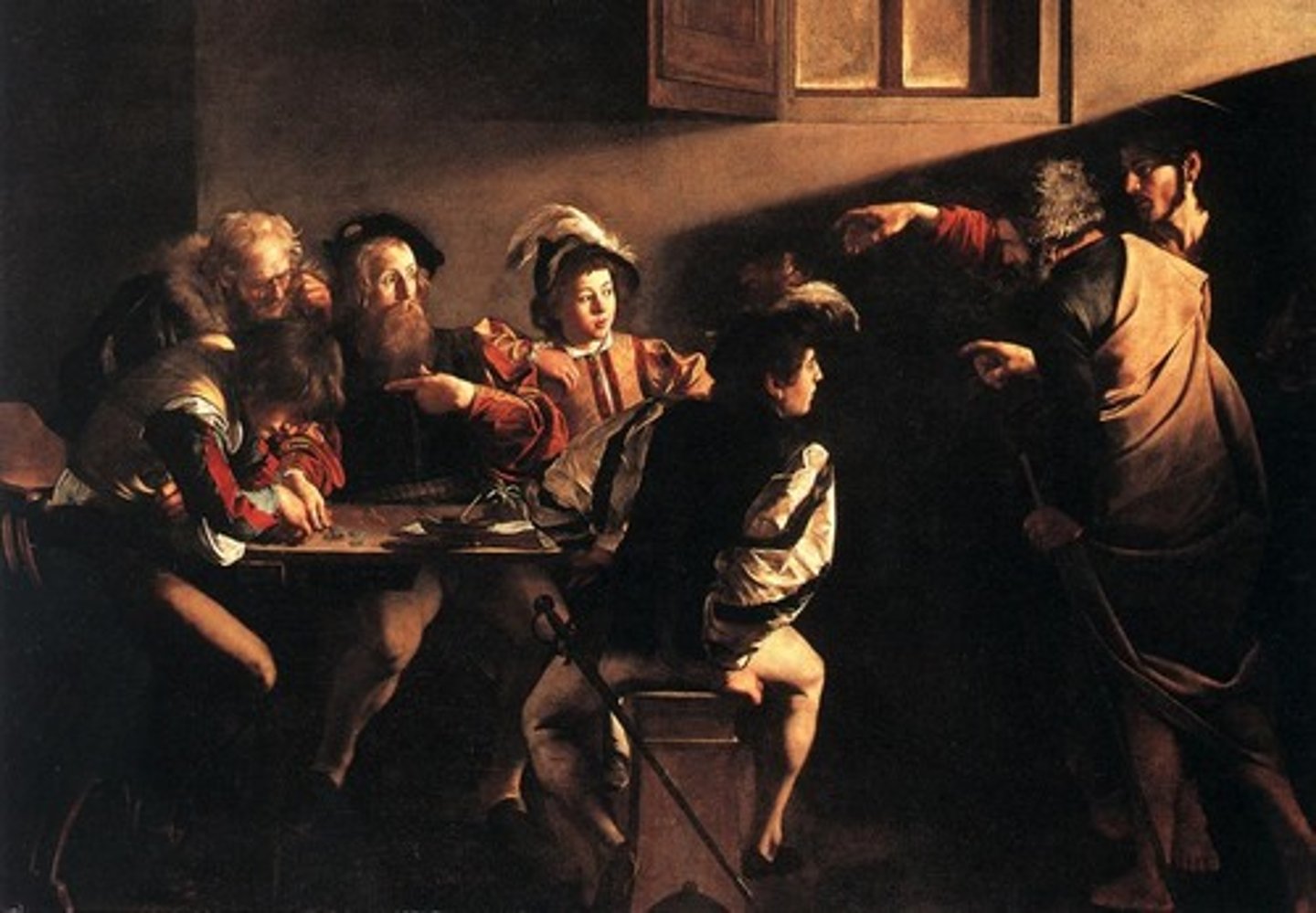
Henri IV Recieves Portrait of Marie de 'Medici (Peter Paul Rubens, 1621-25, oil on canvas)
Form:
-floating figures
-part of a cycle
-shows an event in her life
-Catholic Baroque
Content:
-Henry IV present the picture of Marie that confirmed his religious identity; married a Catholic queen
-marries her so he can have a son and recreate him in a Catholic way
-Jupiter and Juno gives blessing to them
Function:
-"early harmony"
-part of a tribute to her life
-show that their marriage was official bc portrait
-shows political power, sophistication, and stability
Context:
-from Marie de' Medici cycle displayed in the Louvre
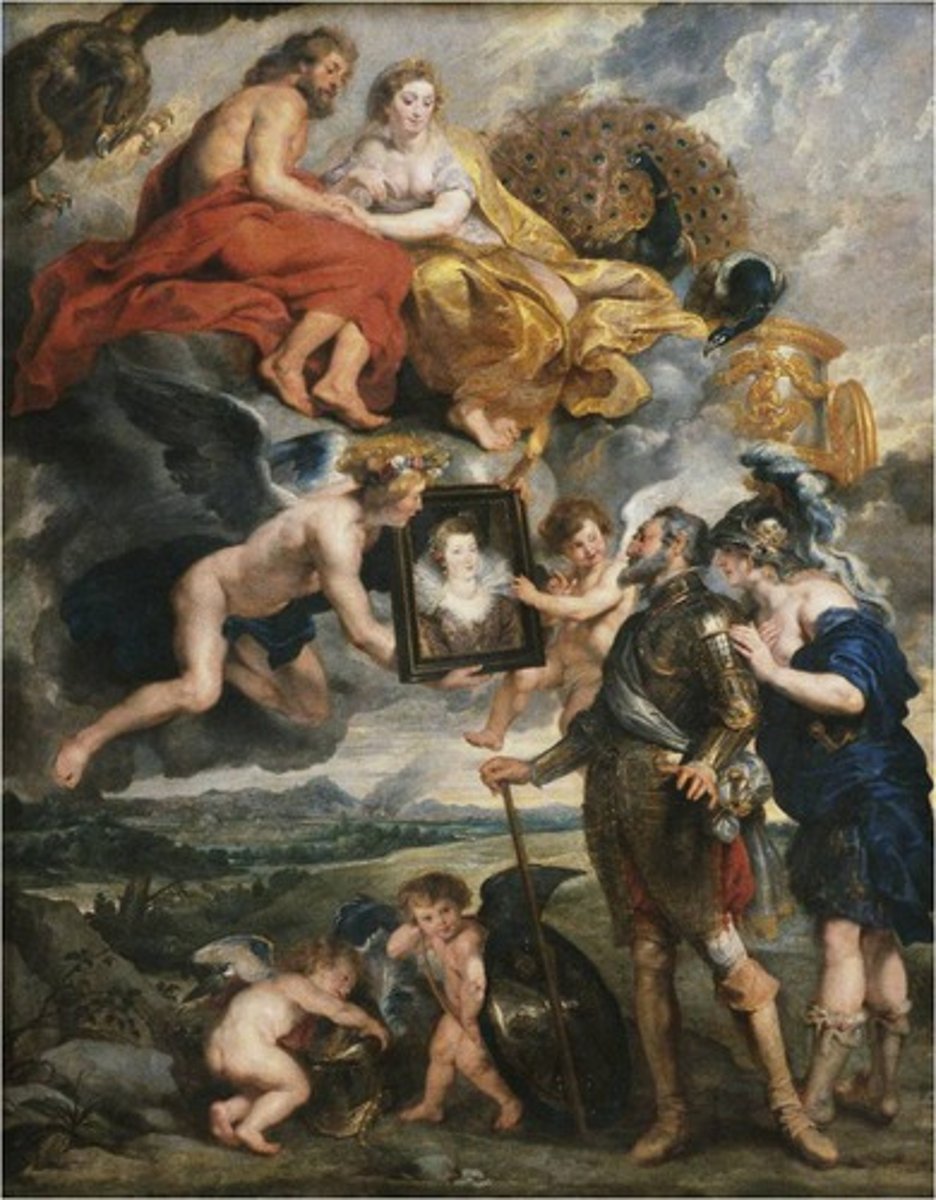
Self Portrait with Saskia (Rembrandt, 1636, etching)
Form:
-Dutch Baroque
-difference in emphasis on the figures
-exists in 3 different states
-rich tonal quality
-abrupt spatial construction
-genre: private movement between husband and wife
-small scale
Content:
-Rembrandt and wife in historical clothing
-wife, Saskia died at the age of 30 (only piece he did of her)
-Rembrandt drawing his drawing
-exploring who he is
Function:
-self portrait/marriage portrait
-role playing
Context:\\
-he is mostly a portrait maker
-Dutch, Amsterdam
-Dutch Baroque

San Carlo alle Quatro Fontane (franceso borromini, 1638-46, stone and stuco, rome)
Form:
-pure white inside with complex geometry
-rich orientation
-balance convex vs. concave
-flowing walls
Content:
-Trinitarian order in centers of ceiling (triangle=HS)
-big columns
-4 fountains
Function:
-dedication to Saint Carlos
-represent the trinity
-reminder of the Renaissance
-Monastic Church (Trinitarian Order)

Ectasy of Saint Teresa (Gian Lorenzo Bernini, 1647-52, marble, stucco, gilt bronze, santa maria della vittoria, rome)
Form:
-rich color
-many shapes and directions
-spiritual vs. physical
-Baroque
-shallow carving
-Counter-Reformation
Content:
-St. Teresa having a vision (physical and spiritual experience)
-fresco on ceiling
-Holy Spirit as a dove, light coming from HS
-columns serving as a frame as you enter chapel
-real daylight explosion
Function:
-Bernini's comeback after his scandal with mistress
-inspire and involve the viewer by bring sculptures to life
-after St. Teresa canonized
-shows union of world
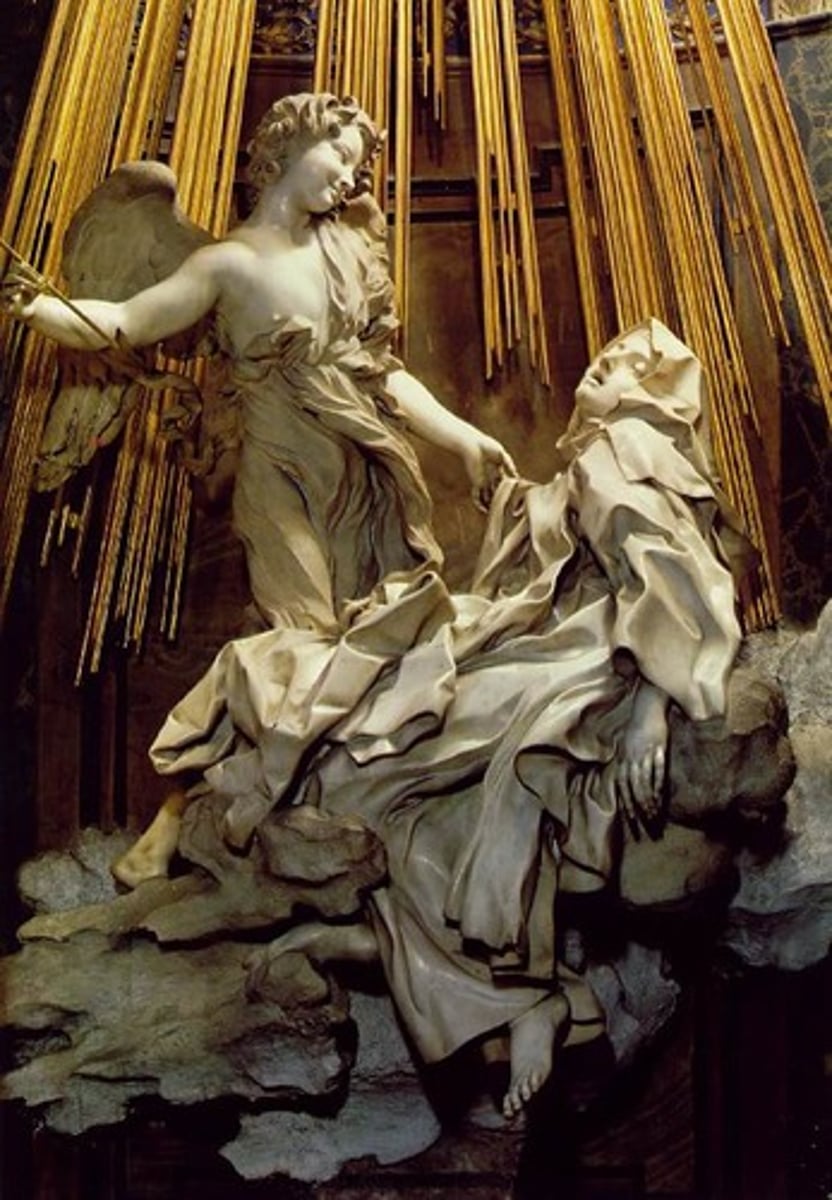
Angel with Aequebus, Asiel Timor Dei (Master of Calamanca, 17th century, oil on canvas)
Form:
-Spanish Colonial Baroque
-idealistic
-Latin inscription
-part of a large history
Content:
-guns from 80 years of war
-feathered crown
-nobility
-elegant clothing
-Catholic missionary
-Asiel fears God
-Church=army
-angel=soldiers
-aristocratic clothing
-Angel with gun
Function:
-militarist approach to faith
-propaganda for war
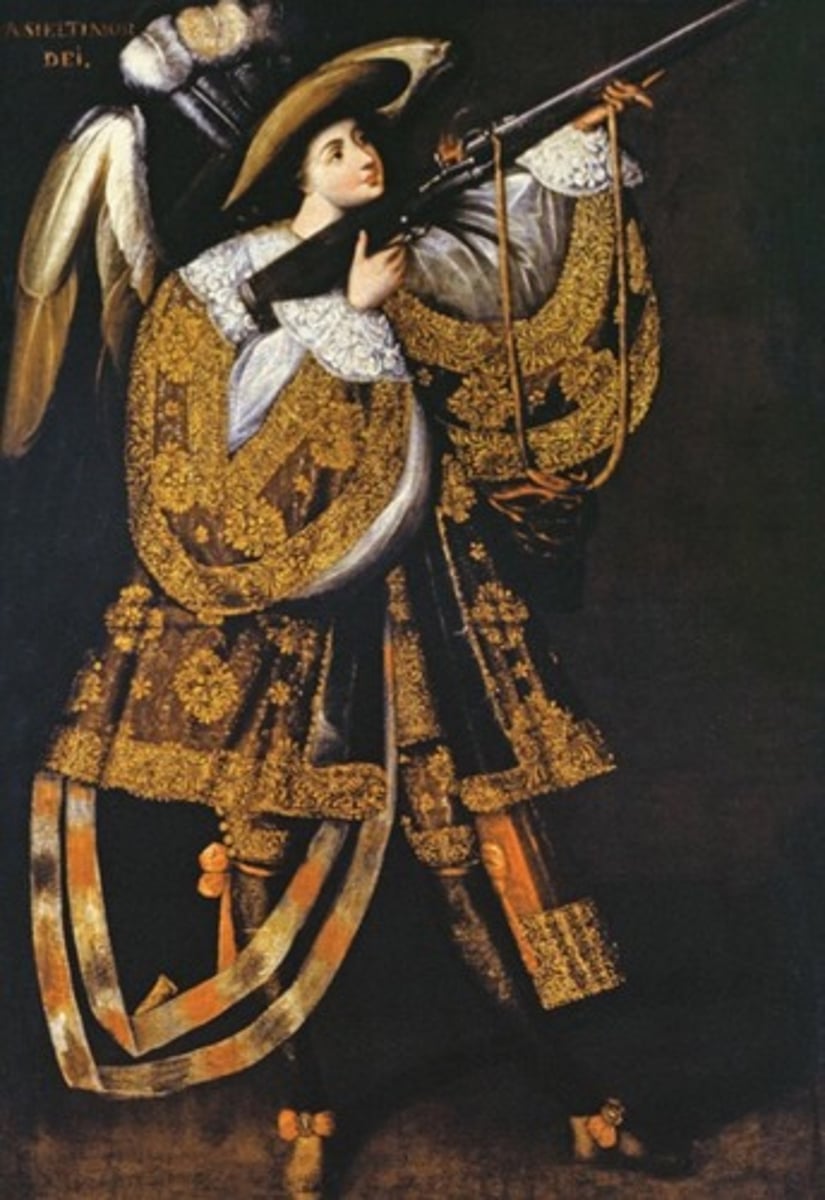
Las Meninas (Diego Velasquez, 1656, oil on canvas)
Form:
-use of mirrors (Baroque)
-movement in strokes not as detailed as you think
-large painting
-gaze
Content:
-maids of honor and daughter
-dog=wealth
-self portrait of Velazquez
-painting in a painting
(Velasquez painting this painting
-people looking at viewer
Function:
-view of palace life
-show wealth/status
-made for Philip IV (the viewer)
-genre painting
Context:
-Spanish Baroque
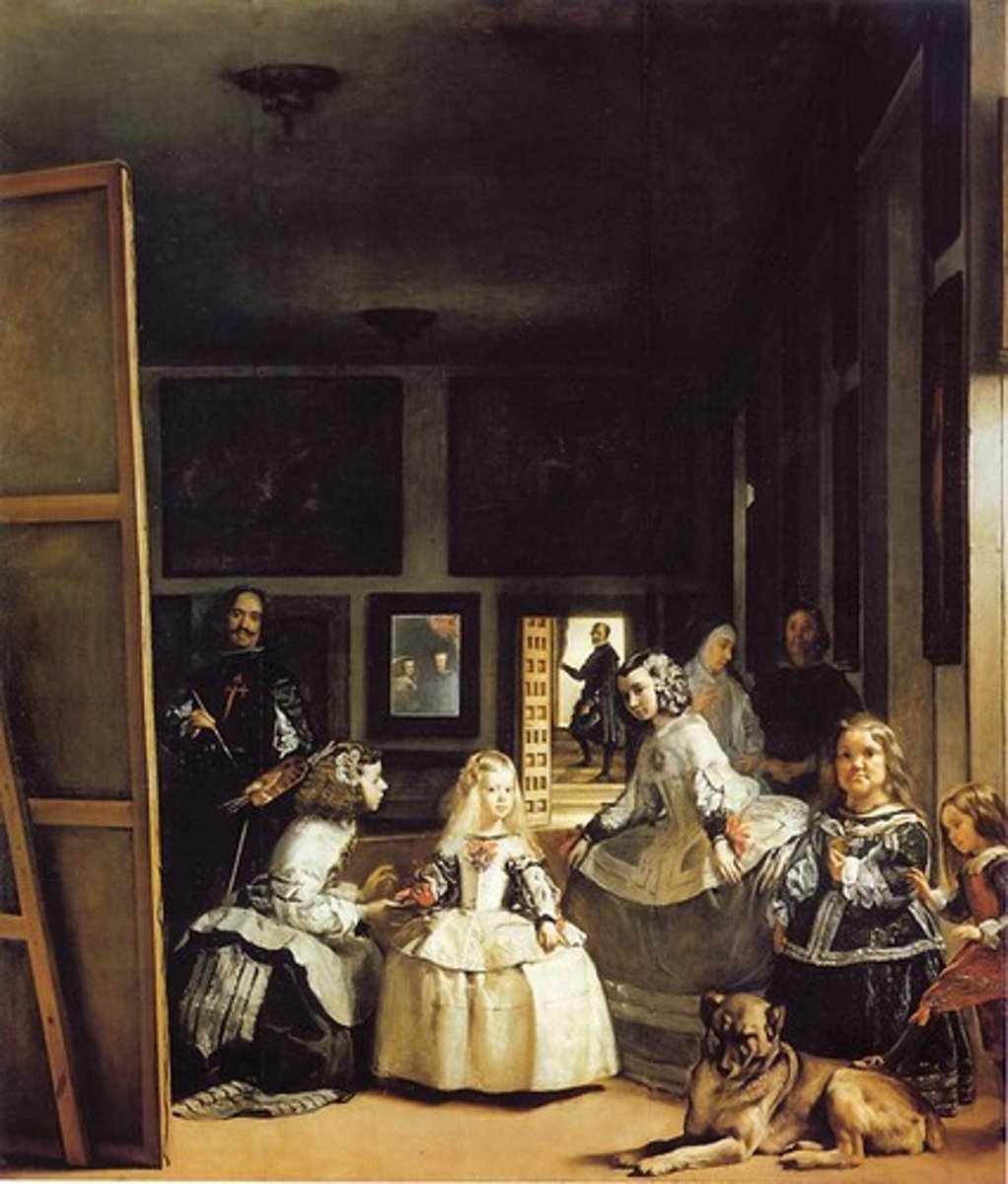
Woman Holding a Balance(Johannes Vermeer, 1664, oil on canvas)
Form:
-Catholic elements
-Scientific lighting
-genre scene
-small scale,
-use of light
-vanishing point
-color palette
Content:
-women part of upperclass (fine clothing)
-fur coat
-balance has nothing in it
-weighing valuables
-Last Judgement scene above
Function:
-material wealth
-painting for merchants
-religious meaning but not painted just for Church
-time and change
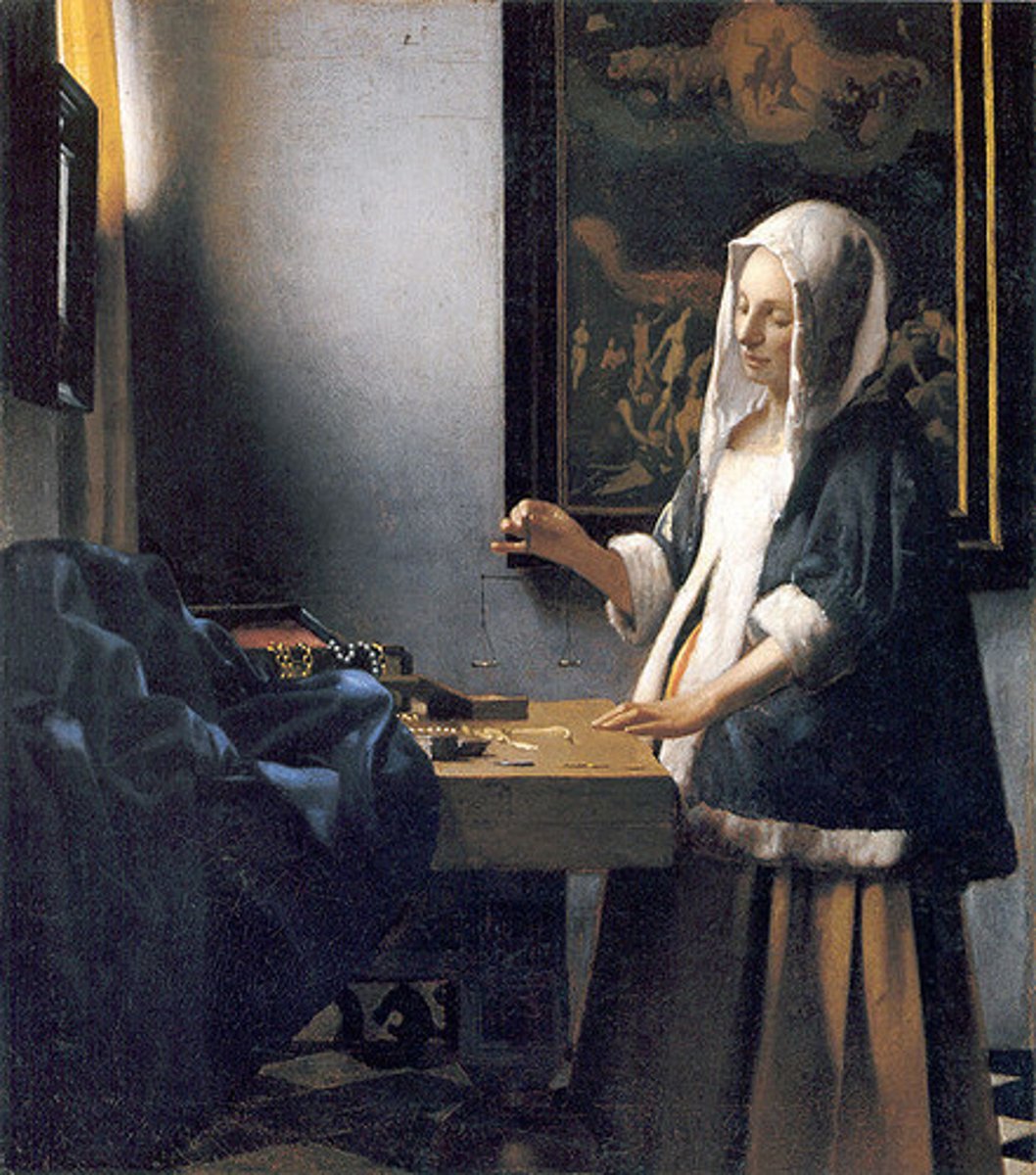
The Palace of Versailles (Louis le vau and jules hardouin-mansart, begun 1669, masonry, stone, wood, iron, gold leaf, gardens, versailles, france)
Form:
-east-west axis
-rigorous geometry
-classical architecture (symmetry, repetitive, and based on Greek temples)
-painted ceilings
-outside is not as "ornate"
-symmetrical
-Greek/Roman influence
-mirrors (hall of mirrors)
Content:
-Hall of mirrors (social gatherings)
-700 rooms
-gardens
-sculptures, paintings, fountains tributed to him
Function:
-King Louis XIV decided to build a new palace
-example of nobility
-living for King, his close friends, family, servants, and soldiers)
-emphasize Louis' importance (everything revolves around him
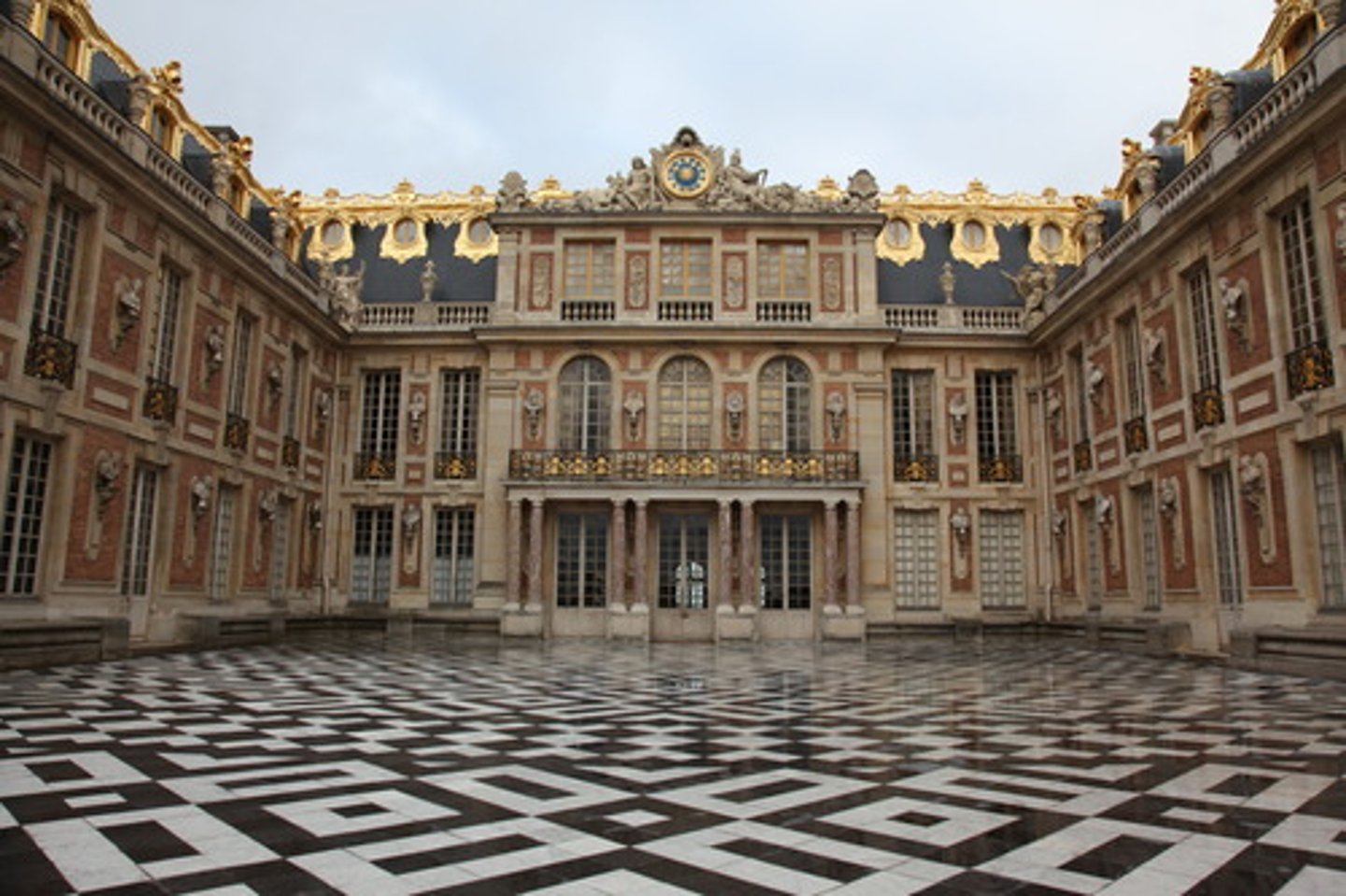
Screen with Seige of Belgrade and hunting scene (1697- 1701, Tempera and resin on wood inlaid with mother-of-pearl)
Form:
-Japanese folding screen (Biombo)
-Spanish Colonial Baroque
-tapestry
-shell inlay (Aztec)
Content:
-historical event from Europe
-one side: battle scene
-other side: landscape
-Great Turkish War
-combines multiple cultures
Function:
-expresses exonomic power of the Spanish in Colonial Mexico
-made Spanish viceroy
-room divider (biombo- Japanese folding screen)
-relationship between Japan and Latin America
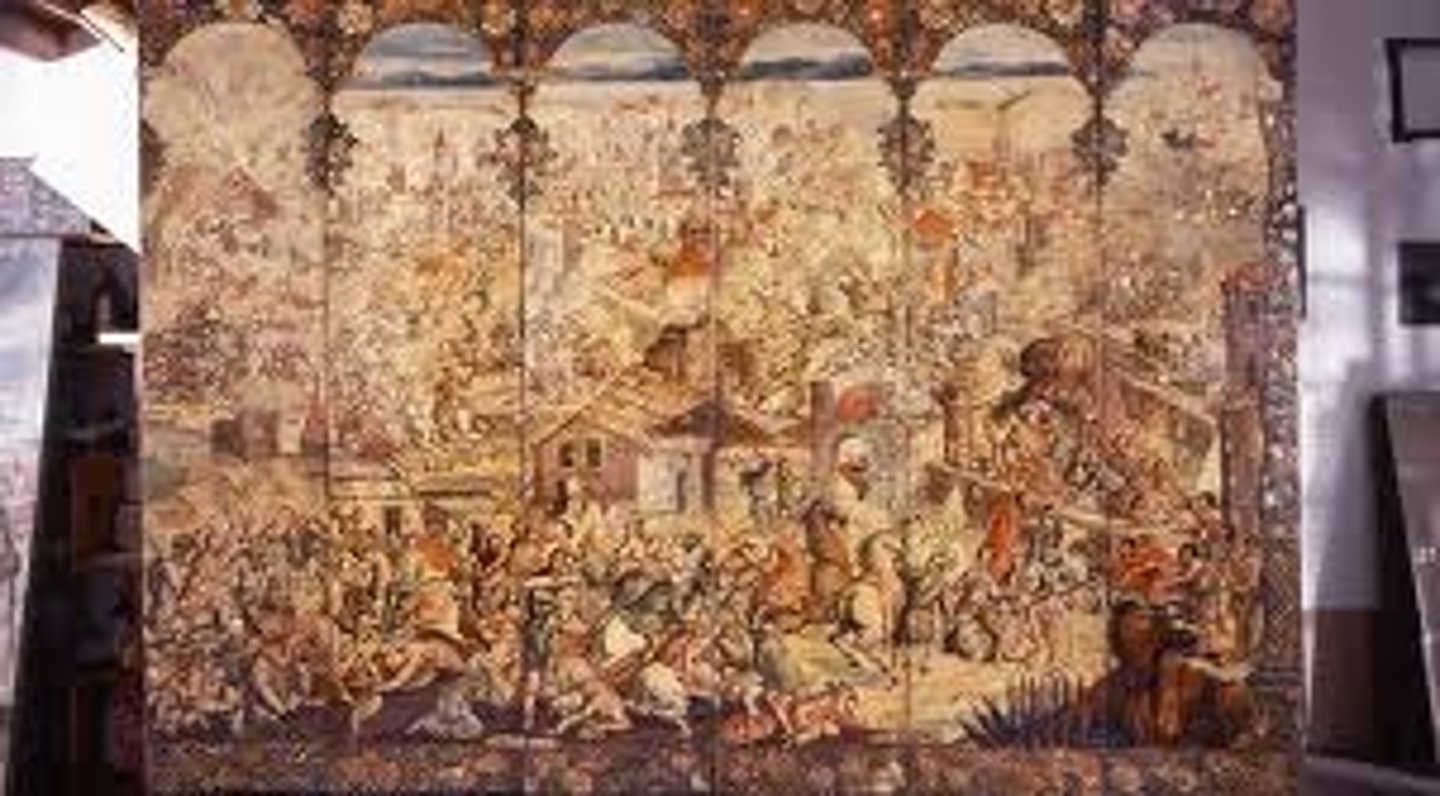
The Virgin of Guadalupe (Micheal Gonzalez, 1698, oil on canvas on wood inlaid with mother-of-pearl)
Form:
-based upon the original
Content:
-artist signature
-traditional view
-story of Juan Diego (Aztec man)
-roses with her image
-radiating light off Mary
-indigenous coming to Roman Catholic Church
-dark-skinned people portraits
Function:
-tribute to Mary and show her as divine
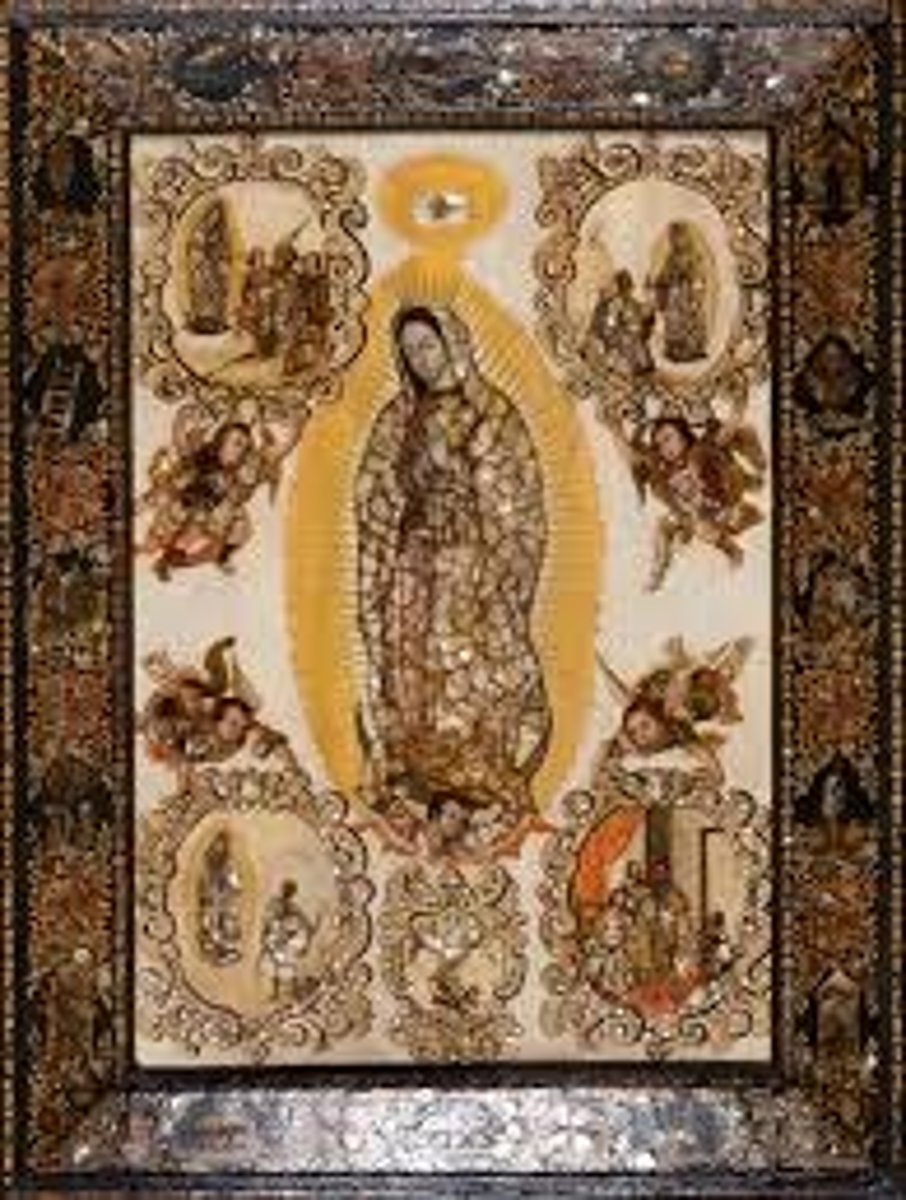
Fruit and Insects (Rachel Ruysch, 1711, oil on wood)
Form:
-still life
-Baroque
-colors, detailed
Content:
-insects, fruit
-wheat and grapes= Jesus?
-bringing different compositions together
Function:
-harvest in autumn
-microscopic organisms: used microscope to study these organisms
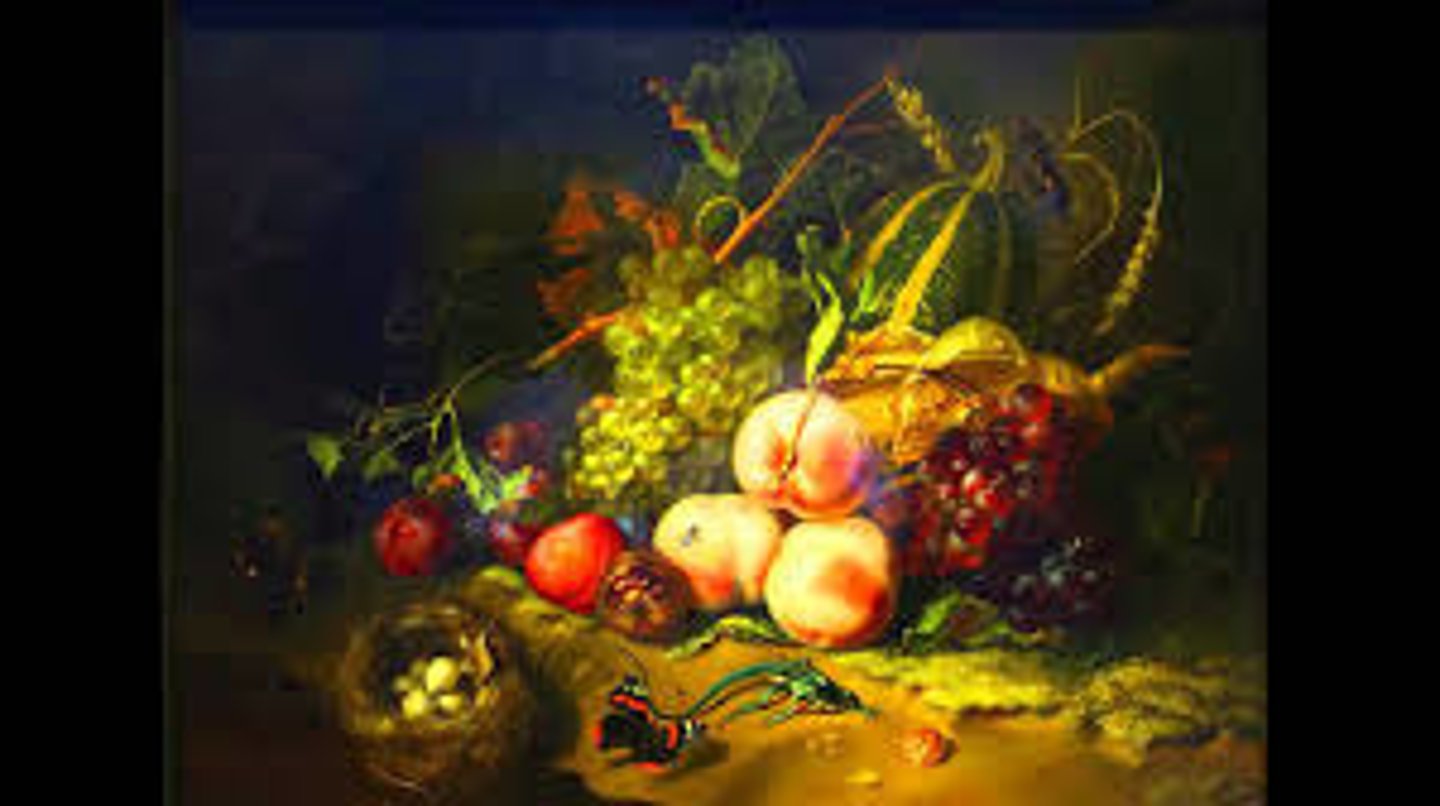
Spaniard and Indian Produce a Mestizo (Juan Rodriguez Juaarez, 1715, oil on canvas)
Form:
-casta painting (displays mother, father, and child) possibly modeled after the Holy Family
-text is the title of the piece
-enlightenment
Content:
-woman wearing traditional Indian clothing and white father with their mixed race son (Father wearing French-style European clothing)
-servant carrying the son
-family appears content
-racial purity=whiteness
Function:
-displays social status (tied up in one's racial makeup)- helped maintain European power and control
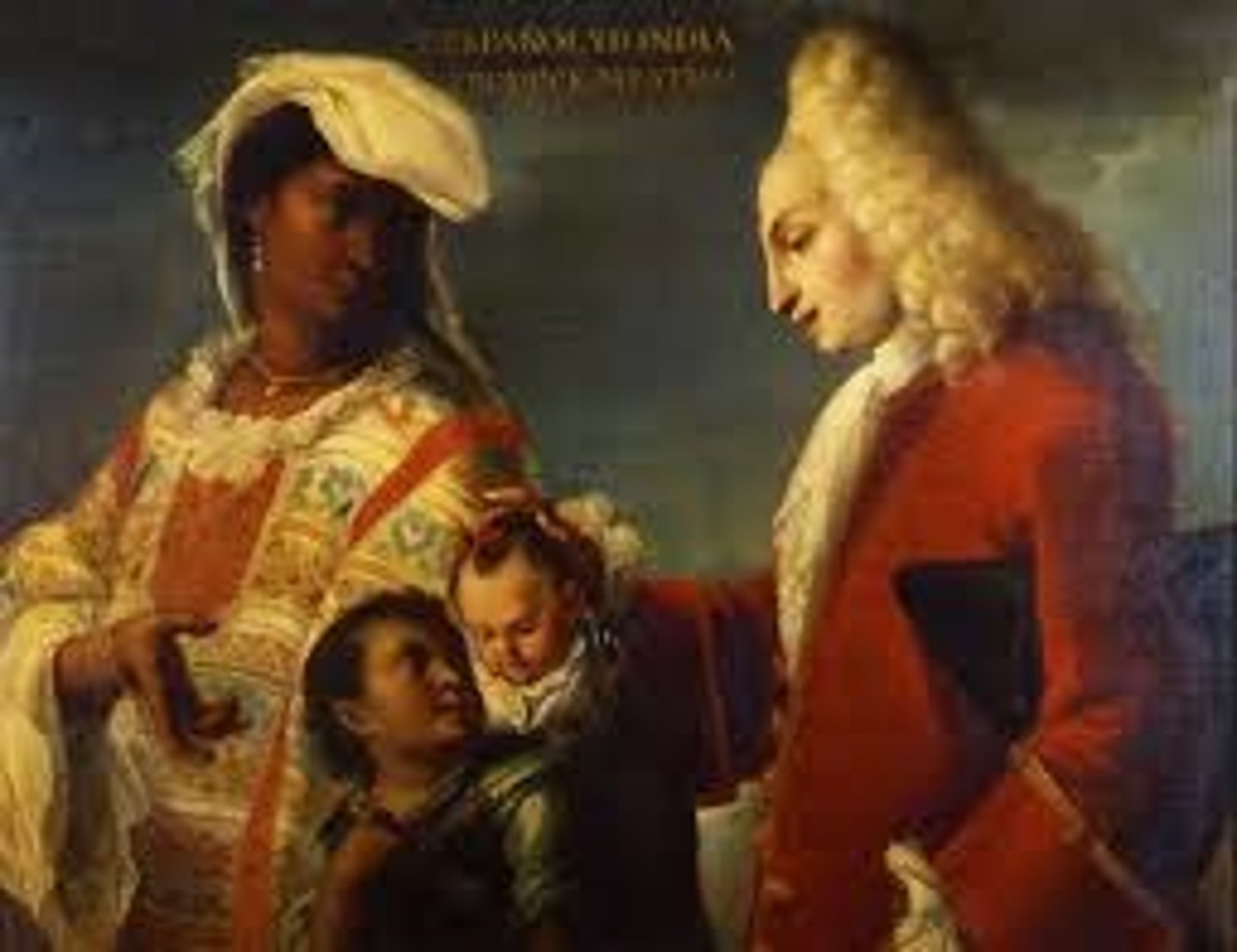
The Tete a Tete from Marriage a la Mode (William Hogarth, 1743, oil on canvas)
Form:
-looks like French Rococo (uses to make fun of the French
Content:
-critques upper-class for getting married because of bloodlines and family
-shows the couple is married but not faithful to eachother
-man being sniffed by dog because smell of another woman's perfume
-woman has been out all night trying to become popular
-part of a series (arranged marriages end badly, marriage should be about love)
-sign that sex occurred before husband came back home (flipped over chair)
-merchant gives up on couple because they won't take finances seriously
Function:
-satire from British to French
-art being made for the growing middle class
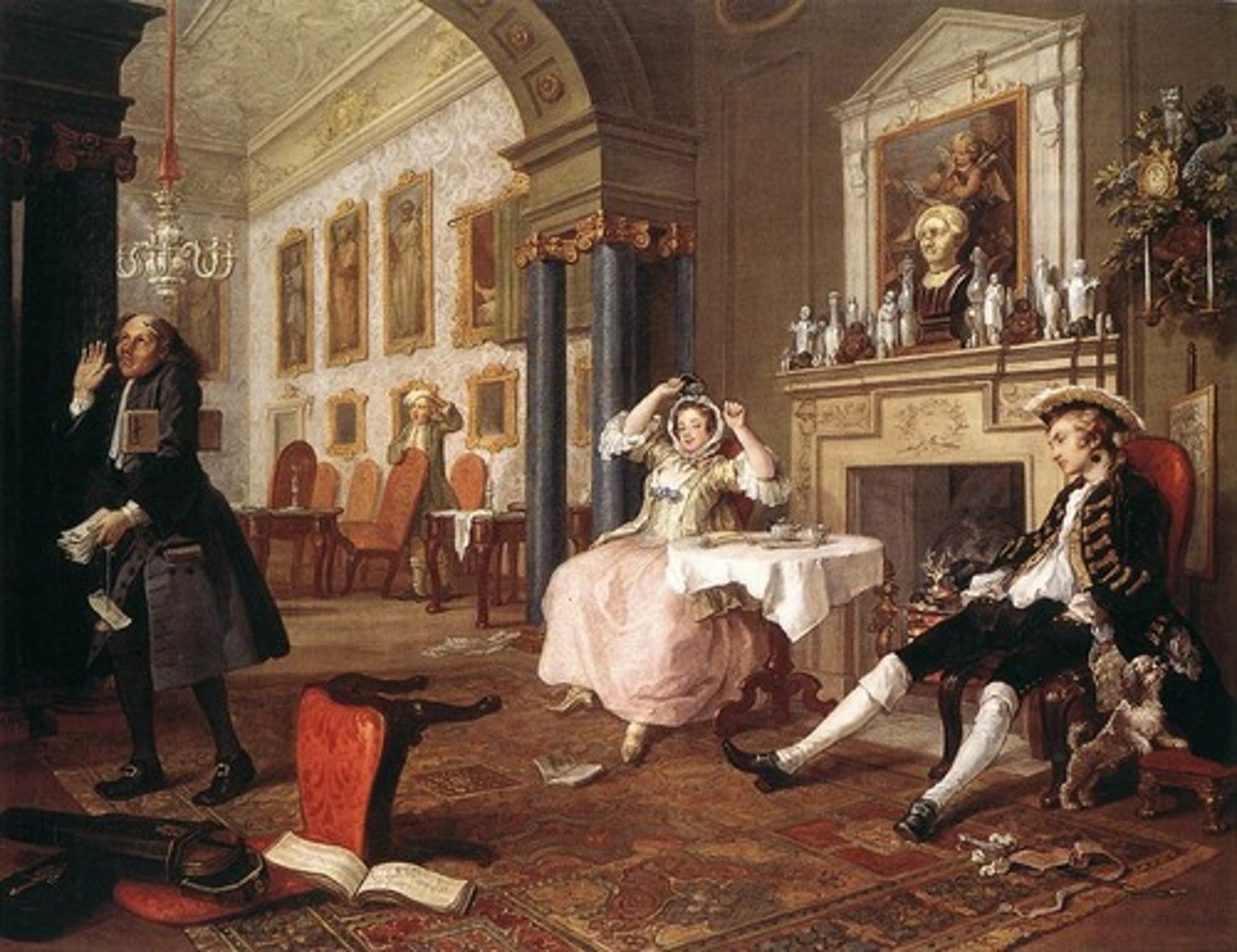
Portrait of Sor Juana Ines de la Cruz (Miguel Cabrera, 1750, oil on canvas)
Form:
- style: enlightenment
-baroque: billowing red curtain
Content:
-typical nun looks
-surrounded by books (educated)
-nun=sor
-wearing a shield
-has painting of Virgin Mary
-hold St. Jerome's translation of the Bible (her religious order is named after him)
-toys with rosary in her left hand
-gaze directly at viewer
-red curtains shows higher status
-woman taking on the clergy
Function:
-conveys religious and intellectual status
-feminist
Context:
-location: Mexico City
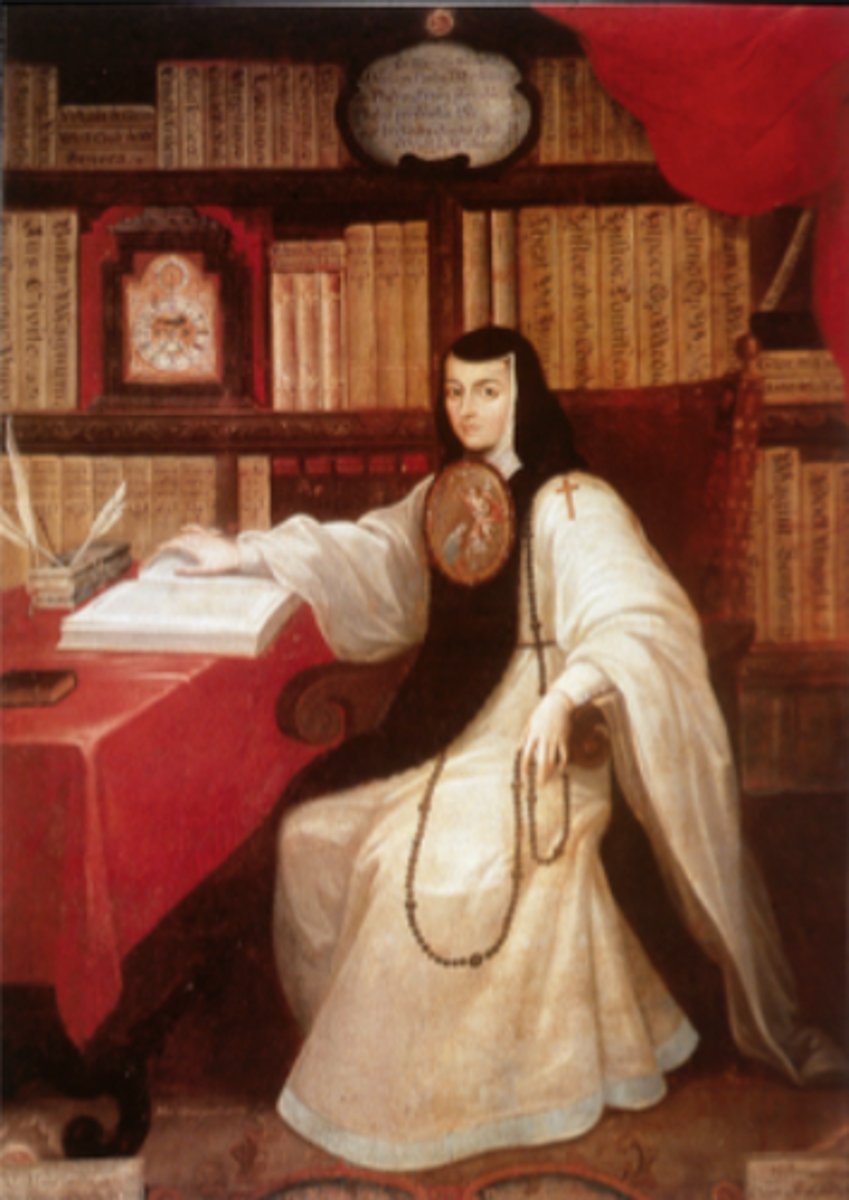
Philosopher giving a lecture on a Orrery (Joseph Wright of Derby, 1763-65; oil on canvas)
Form:
-Tenebrism now used in secular aspects (mimicking Caravaggio)
-Chiaroscuro: contrast between light and dark
Content:
-orrery: model of the solar system (heliocentric)
-philosopher explain something to people in painting (education is sacred)
Function:
-introduction to science
-celebrates access to knowledge
-shift from religion to science
-philosophical groups emerging
